Inbox and Environment News: Issue 542
June 12 -18, 2022: Issue 542
Sydney Metropolitan Wildlife Services: Possums In Your Roof
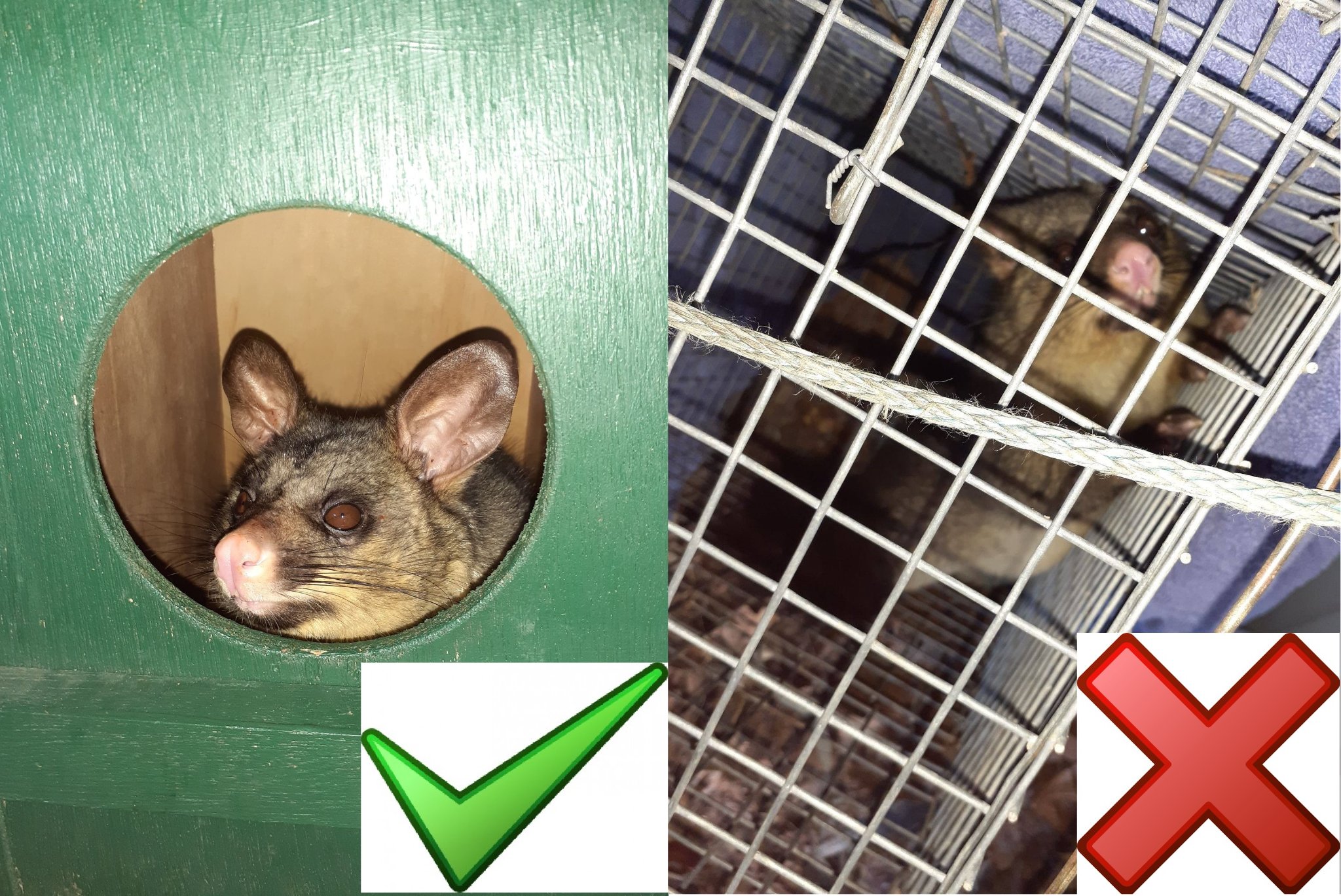
Local Leatherback Turtle Deaths
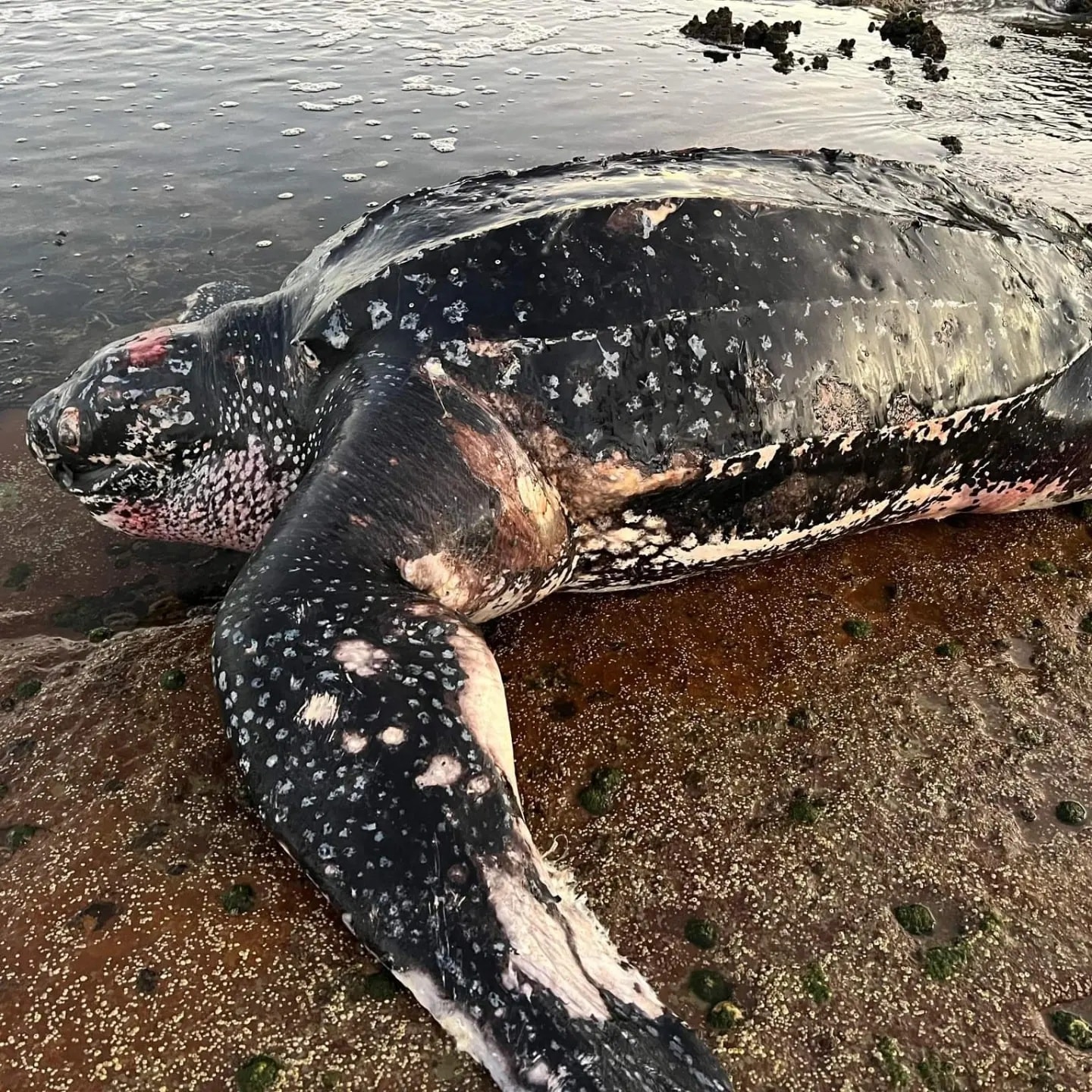
Pelicans Heading To The Coast Now: Winter Migrations
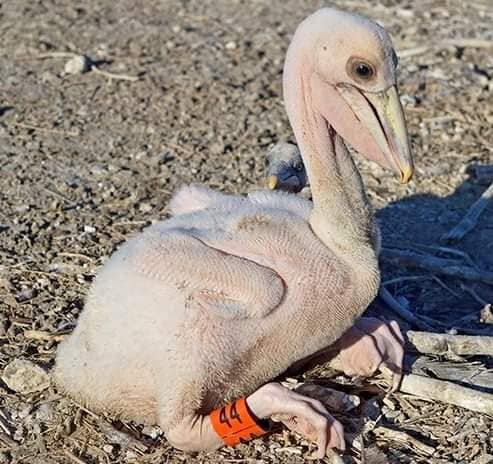
Central Coast Announced As Location For New Offshore Artificial Reef
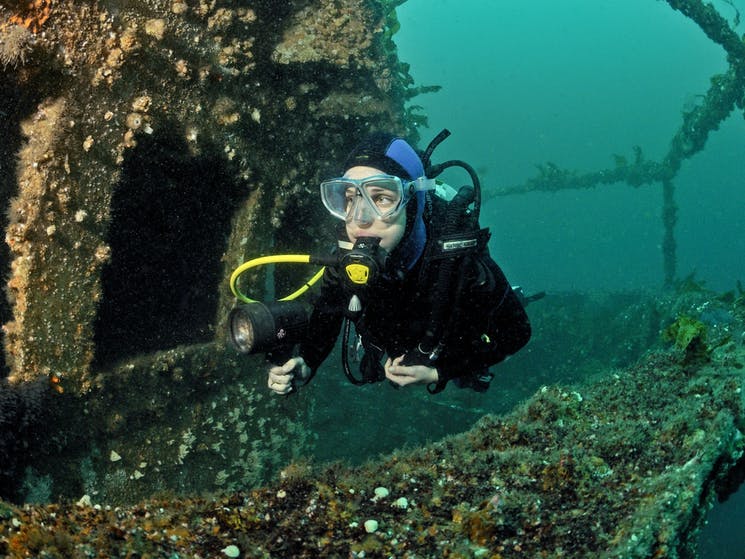
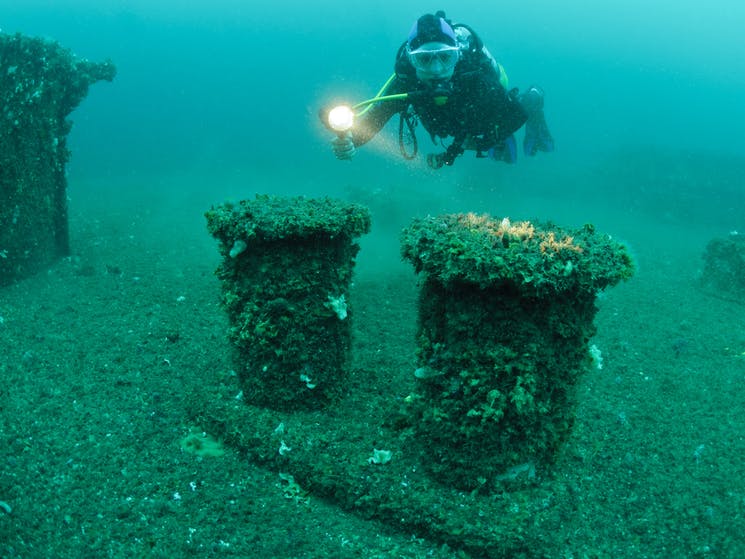
Sand Point - Palm Beach: Winter 2022
Pittwater Natural Heritage Association (PNHA) Walks
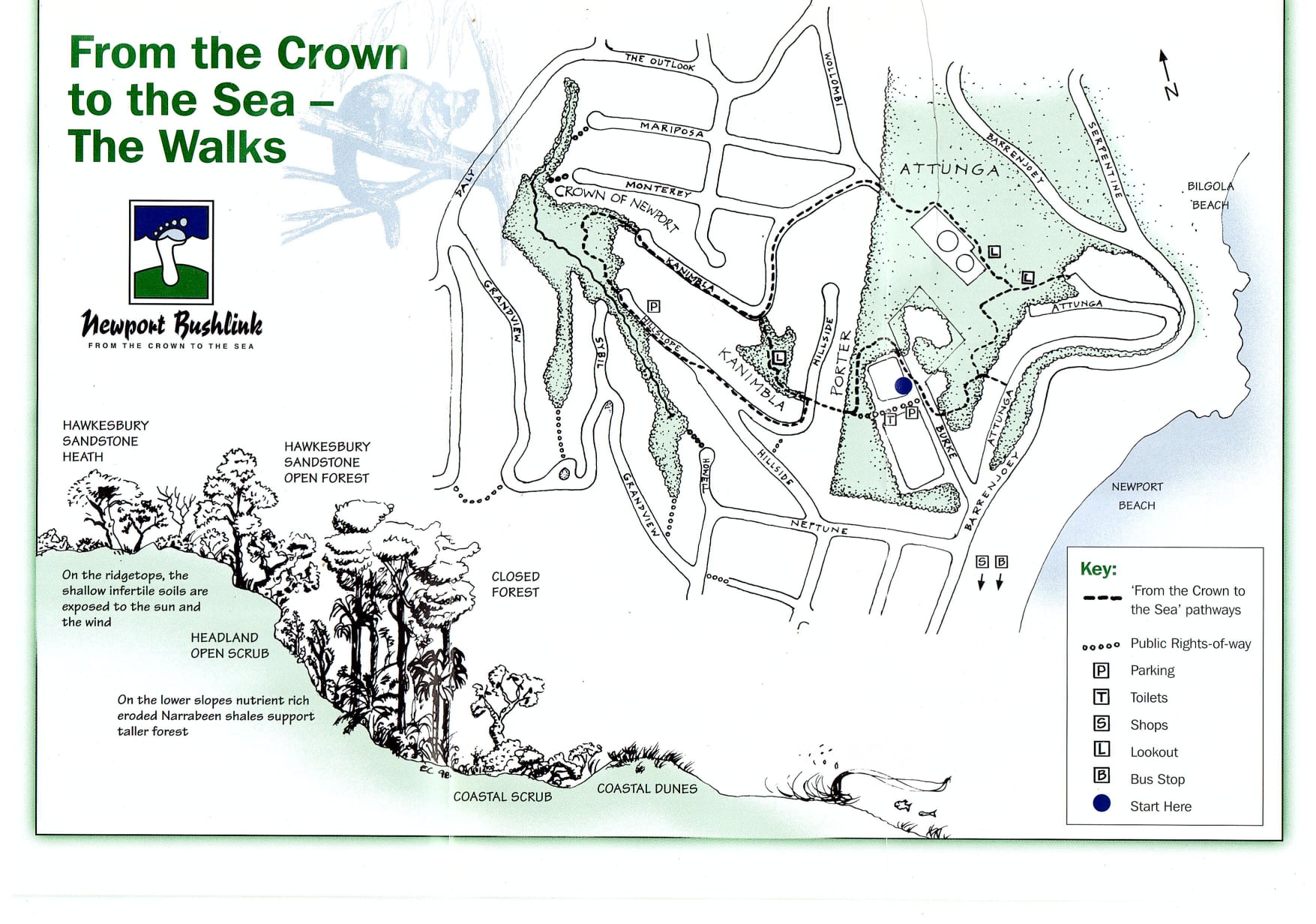
Pittwater Natural Heritage Association (PNHA): What’s This Plant? + Microbat
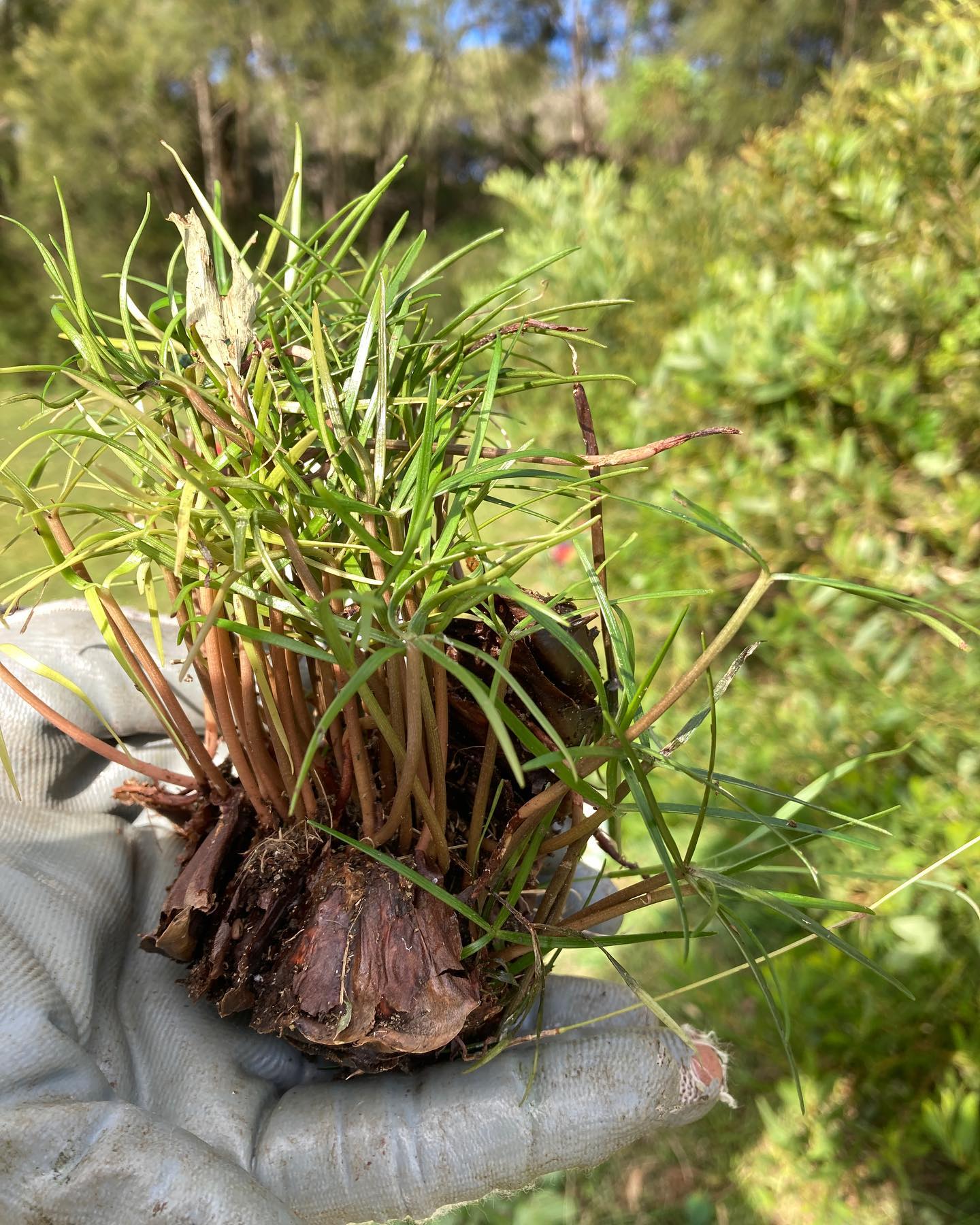
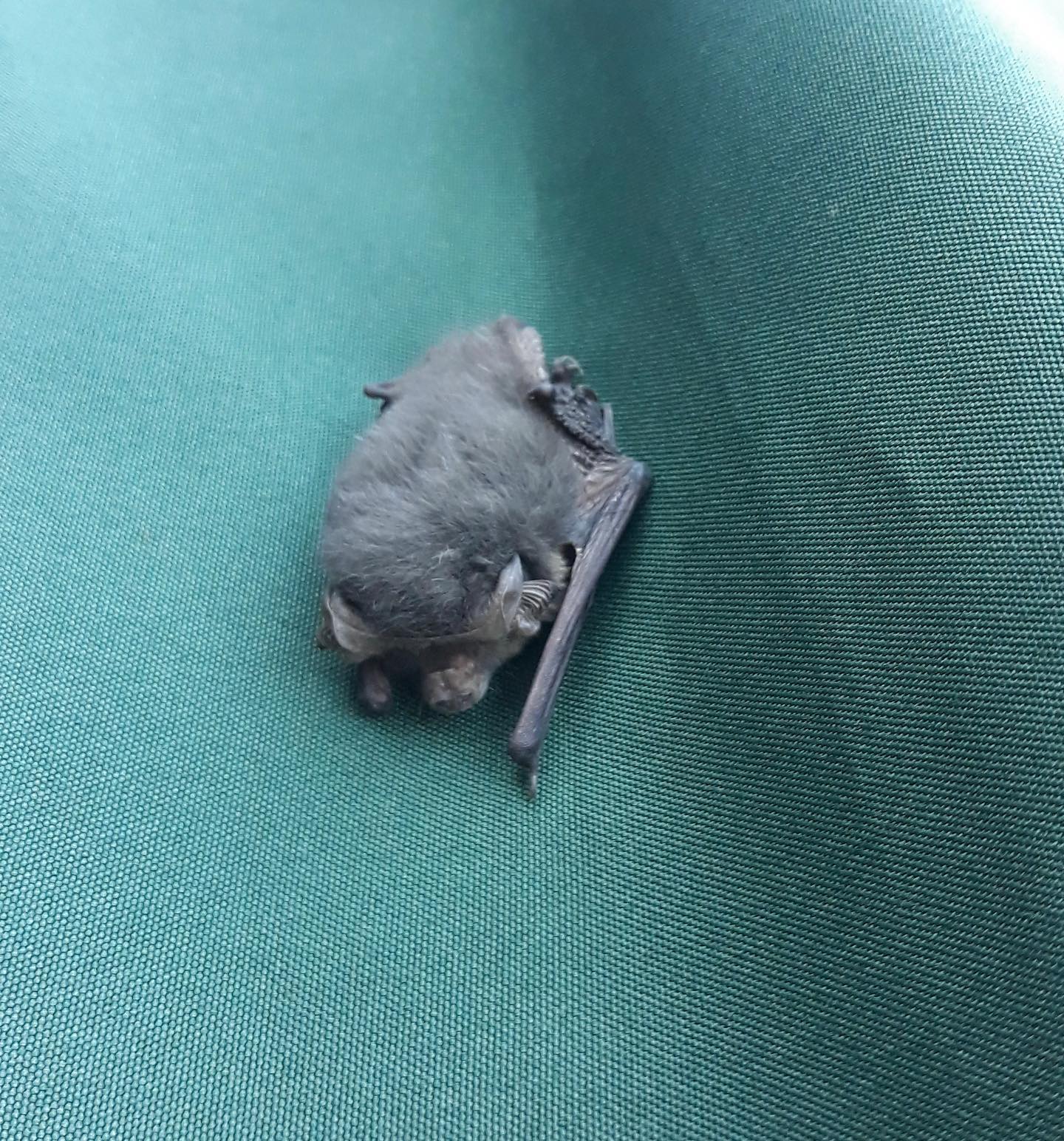
Microbats Of Sydney
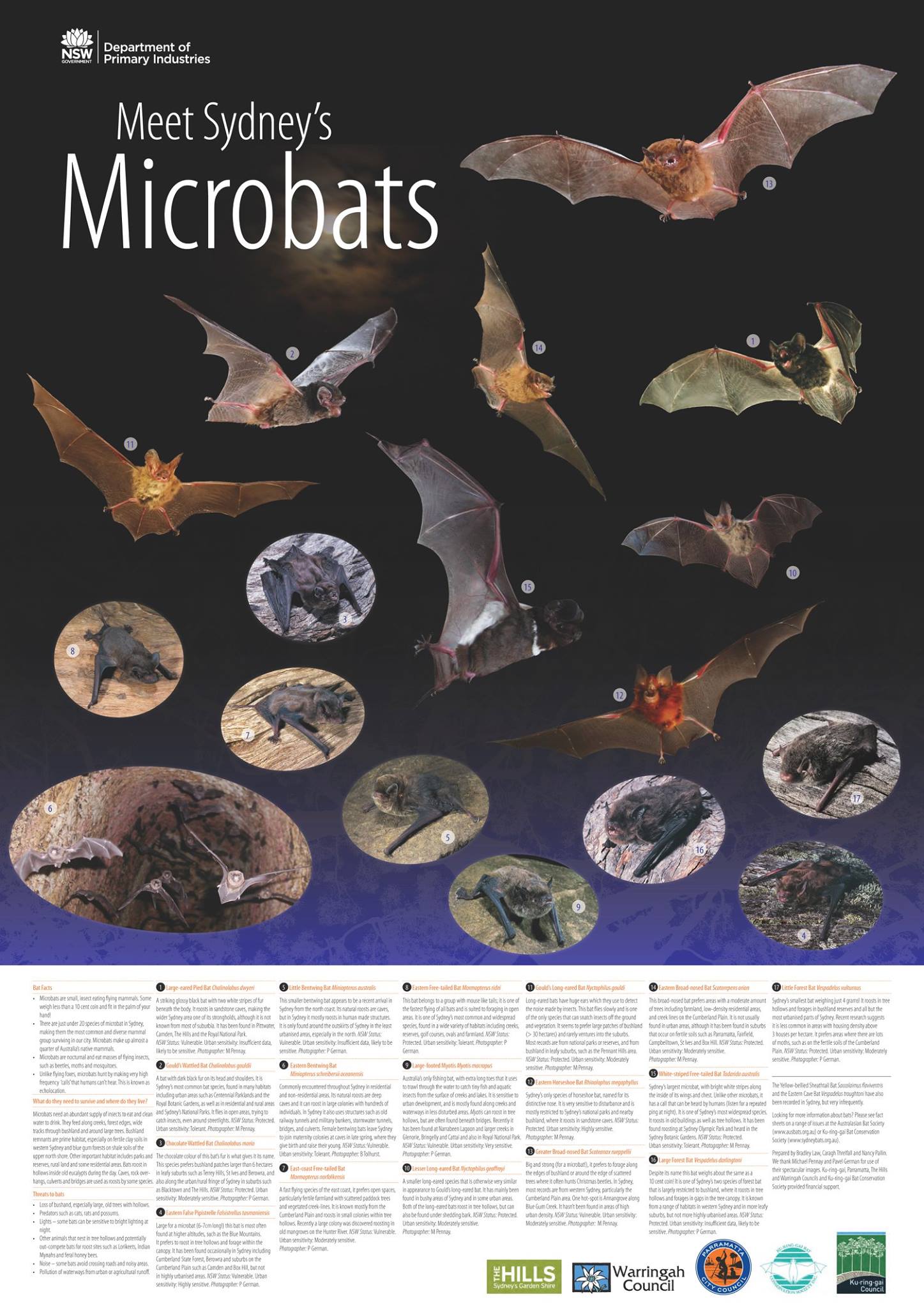
Chemical Clean Out: June 2022 At Mona Vale
Living Ocean Traditional Welcome To Country For The Southern Humpback Whale Migration: June 24
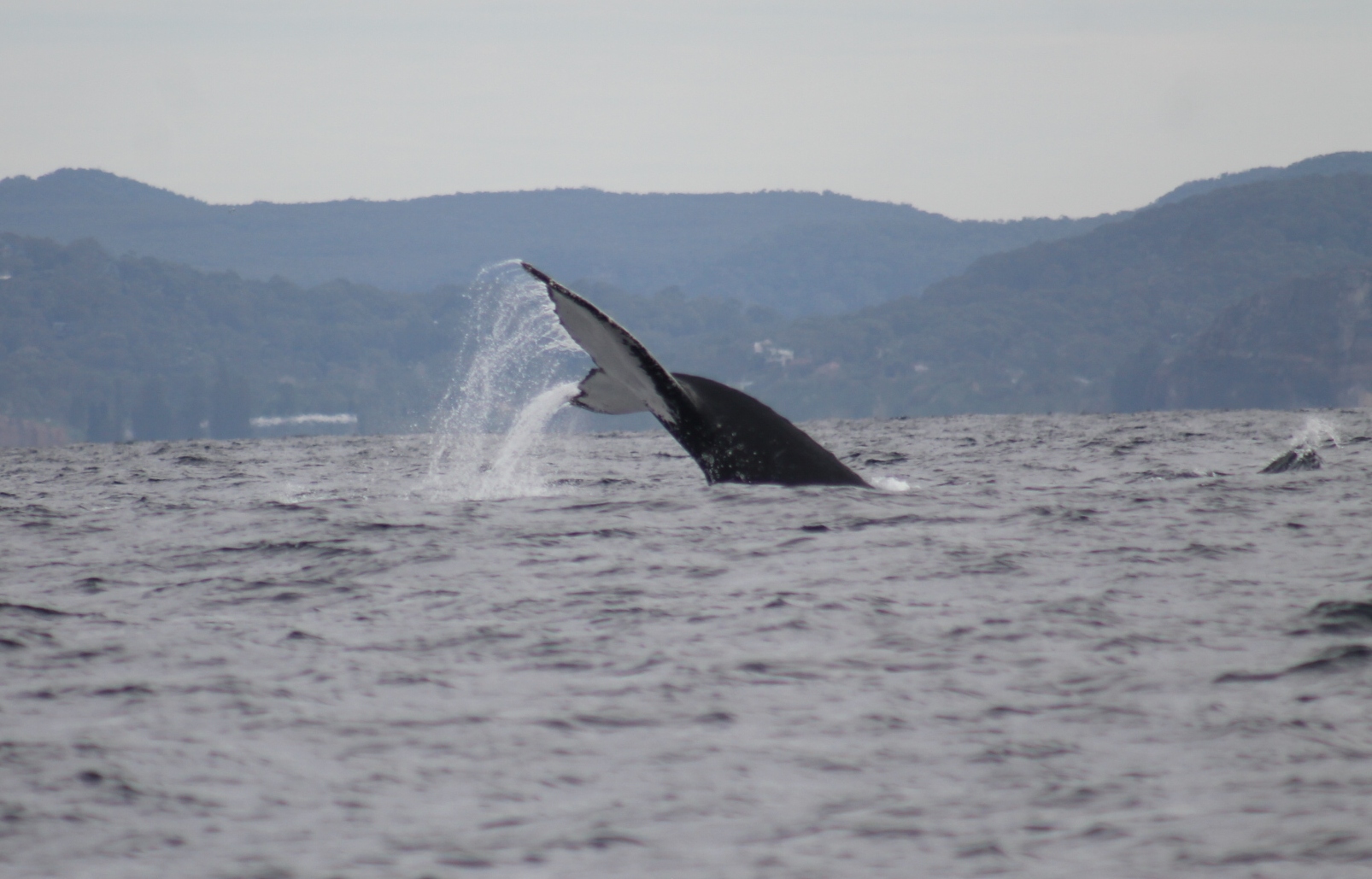
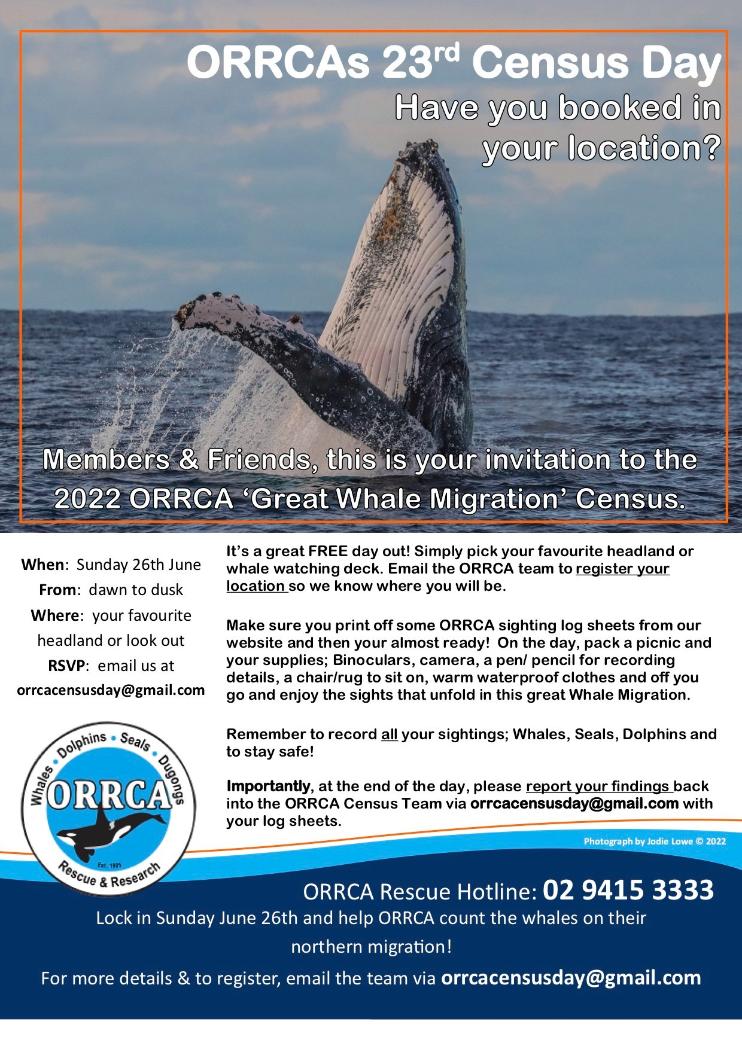
Northern Beaches Clean Up Crew: Narrabeen - June 26
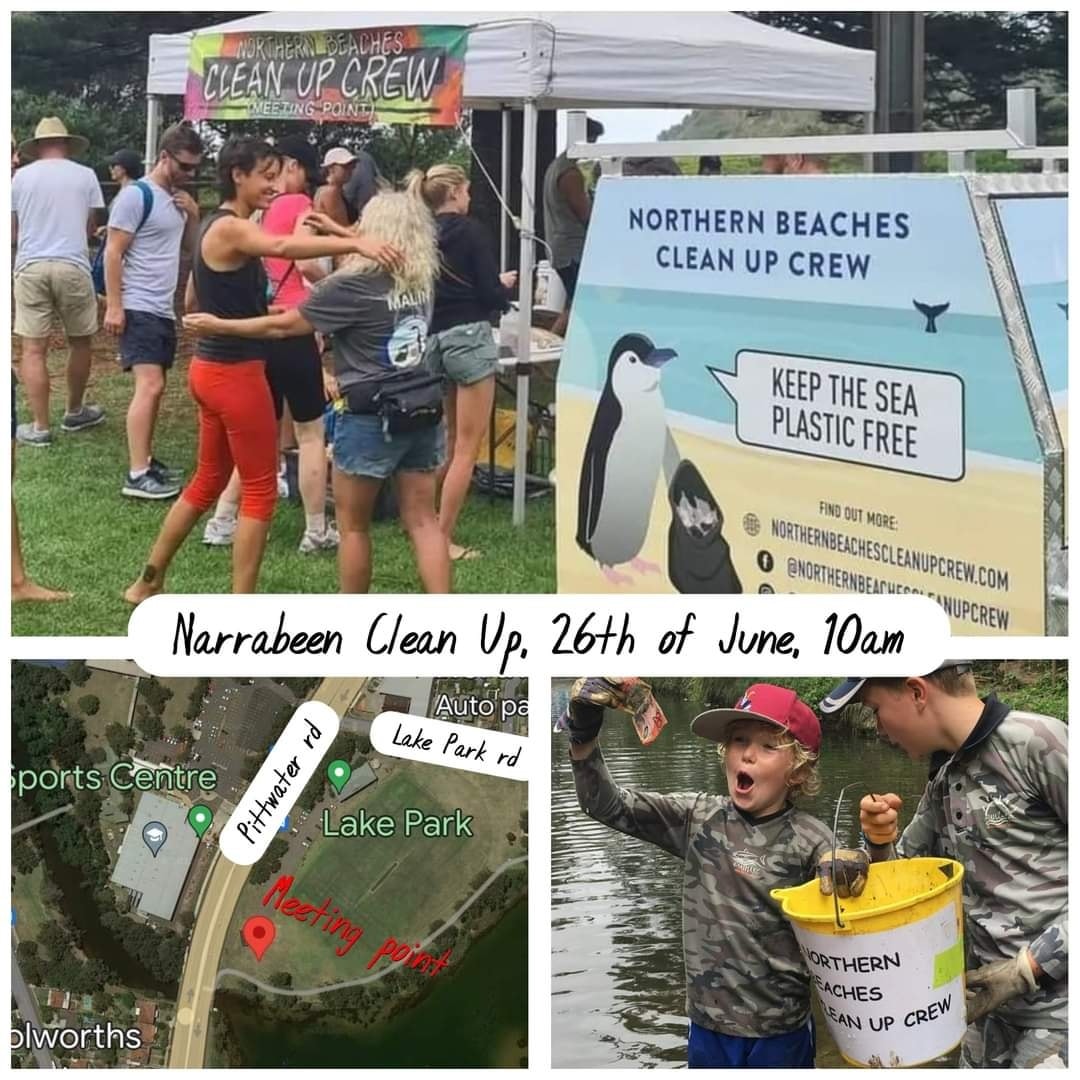
Barrenjoey Lighthouse Tours
Local Wildlife Rescuers And Carers State That Ongoing Heavy Rains Are Tough For Us But Can Be Tougher For Our Wildlife:
- Birds and possums can be washed out of trees, or the tree comes down, nests can disintegrate or hollows fill with water
- Ground dwelling animals can be flooded out of their burrows or hiding places and they need to seek higher ground
- They are at risk crossing roads as people can't see them and sudden braking causes accidents
- The food may disappear - insects, seeds and pollens are washed away, nectar is diluted and animals can be starving
- They are vulnerable in open areas to predators, including our pets
- They can't dry out and may get hypothermia or pneumonia
- Animals may seek shelter in your home or garage.
You can help by:
- Keeping your pets indoors
- Assessing for wounds or parasites
- Putting out towels or shelters like boxes to provide a place to hide
- Drive to conditions and call a rescue group if you see an animal hit (or do a pouch check or get to a vet if you can stop)
- If you are concerned take a photo and talk to a rescue group or wildlife carer
There are 2 rescue groups in the Northern Beaches:
Sydney Wildlife: 9413 4300
WIRES: 1300 094 737
Please be patient as there could be a few enquiries regarding the wildlife.
Generally Sydney Wildlife do not recommend offering food but it may help in some cases. Please ensure you know what they generally eat and any offerings will not make them sick. You can read more on feeding wildlife here
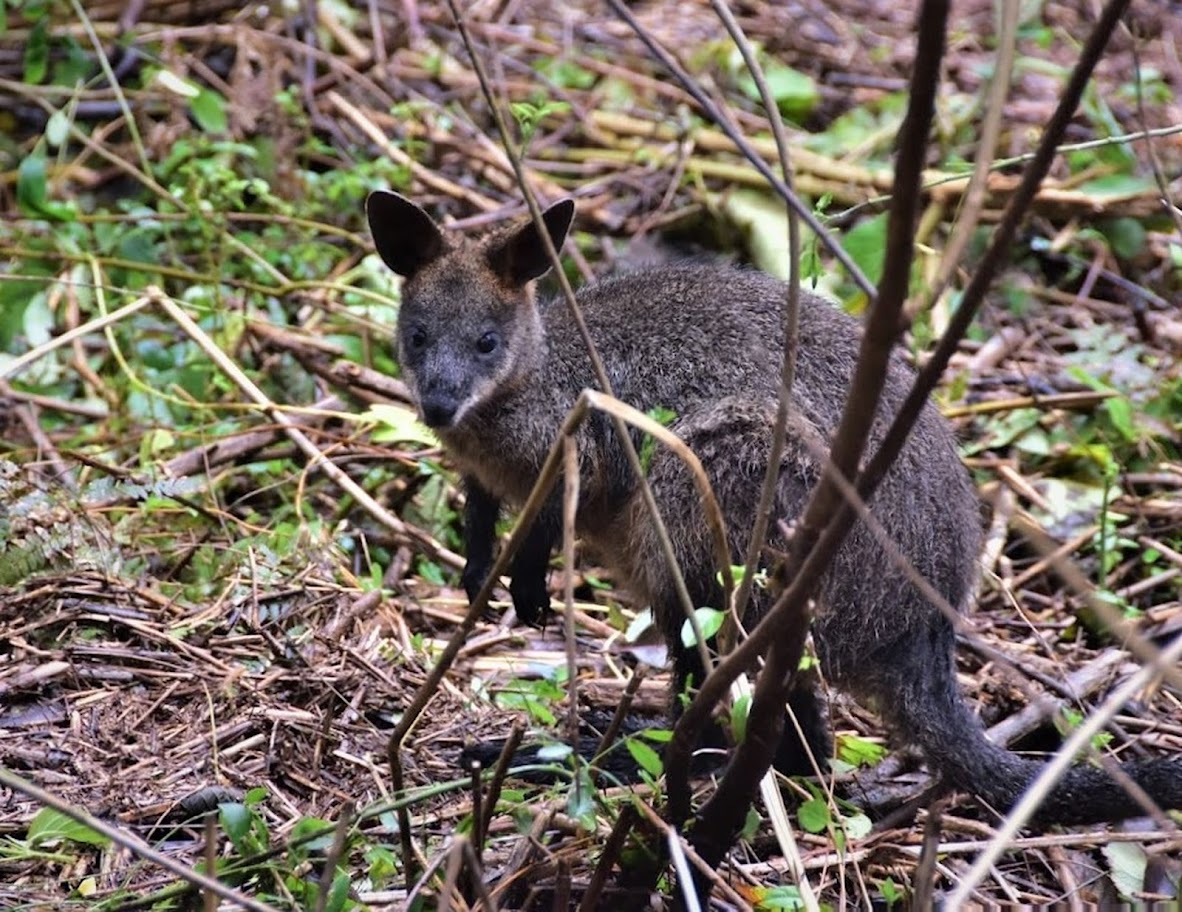
Information courtesy Ed Laginestra, Sydney Wildlife volunteer. Photo: Warriewood Wetlands Wallaby by Kevin Murray, March 2022.
Aviaries + Possum Release Sites Needed

Sydney Wildlife Rescue: Helpers Needed
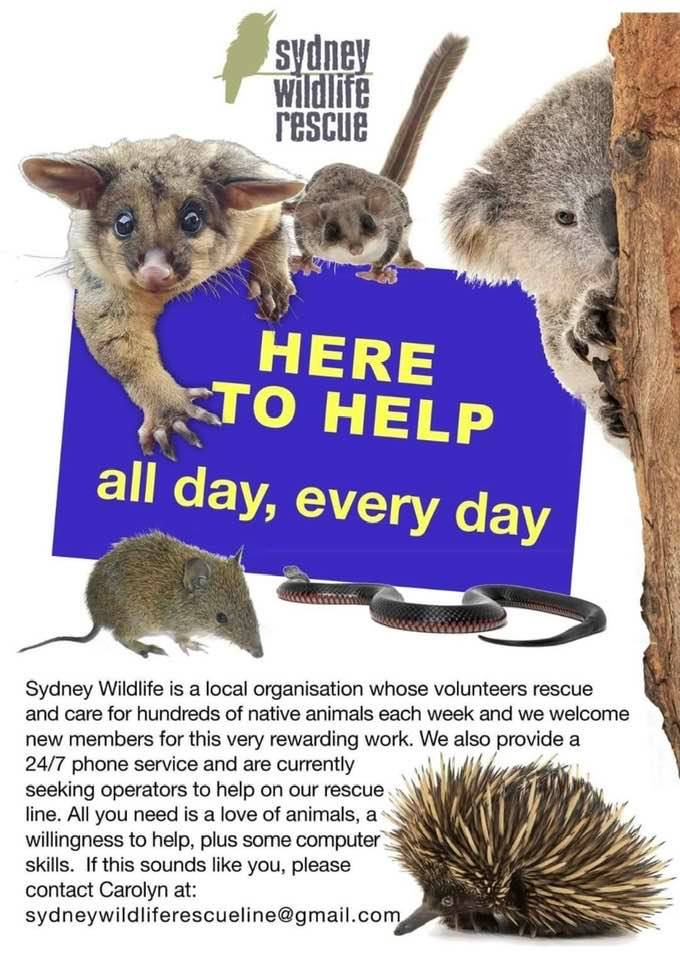
Avalon Golf Course Bushcare Needs You
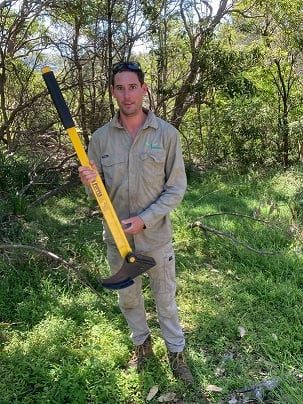
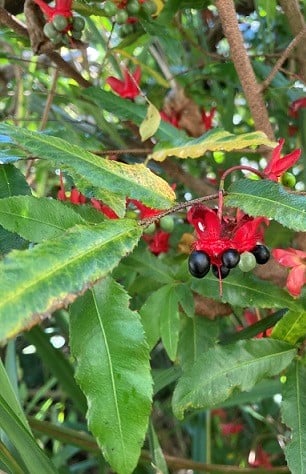
Bushcare In Pittwater
Where we work Which day What time
Avalon
Angophora Reserve 3rd Sunday 8:30 - 11:30am
Avalon Dunes 1st Sunday 8:30 - 11:30am
Avalon Golf Course 2nd Wednesday 3 - 5:30pm
Careel Creek 4th Saturday 8:30 - 11:30am
Toongari Reserve 3rd Saturday 9 - 12noon (8 - 11am in summer)
Bangalley Headland 2nd Sunday 9 to 12noon
Bayview
Winnererremy Bay 4th Sunday 9 to 12noon
Bilgola
North Bilgola Beach 3rd Monday 9 - 12noon
Algona Reserve 1st Saturday 9 - 12noon
Plateau Park 1st Friday 8:30 - 11:30am
Church Point
Browns Bay Reserve 1st Tuesday 9 - 12noon
McCarrs Creek Reserve Contact Bushcare Officer To be confirmed
Clareville
Old Wharf Reserve 3rd Saturday 8 - 11am
Elanora
Kundibah Reserve 4th Sunday 8:30 - 11:30am
 Mona Vale
Mona Vale Mona Vale Beach Basin 1st Saturday 8 - 11am
Mona Vale Dunes 2nd Saturday +3rd Thursday 8:30 - 11:30am
Newport
Bungan Beach 4th Sunday 9 - 12noon
Crescent Reserve 3rd Sunday 9 - 12noon
North Newport Beach 4th Saturday 8:30 - 11:30am
Porter Reserve 2nd Saturday 8 - 11am
North Narrabeen
Irrawong Reserve 2nd Saturday 2 - 5pm
Palm Beach
North Palm Beach Dunes 3rd Saturday 9 - 12noon
Scotland Island
Catherine Park 2nd Sunday 10 - 12:30pm
Elizabeth Park 1st Saturday 9 - 12noon
Pathilda Reserve 3rd Saturday 9 - 12noon
Warriewood
Warriewood Wetlands 1st Sunday 8:30 - 11:30am
Whale Beach
Norma Park 1st Friday 9 - 12noon
Western Foreshores
Coopers Point, Elvina Bay 2nd Sunday 10 - 1pm
Rocky Point, Elvina Bay 1st Monday 9 - 12noon
Gardens And Environment Groups And Organisations In Pittwater
New Report Lets Rip On Australia’s Problem With Gassy Coal Mines
- Australia is the world’s 6th largest coal mine methane emitter and on track to become the 3rd worst. Despite this, the government has not signed the Global Methane Pledge and has continued to approve new and expanding coal mines at a rate only behind China and Russia.
- Methane’s short-term climate impact is 82.5 times that of carbon dioxide, making the methane released by coal mines equivalent to 74.3 million tonnes of CO2. This is greater than the 44 million tonnes of CO2 emitted by cars each year.
- But the International Energy Agency estimates that direct methane emissions from Australian coal mines in 2019 were double the reported amount. This would mean coal mines are releasing equivalent to 149Mt of CO2-e.
- Even the IEA’s figure is likely to be conservative, with state of the art satellite data showing some coal mines are releasing ten times the amount officially recorded.
Dendrobium Mine Extension Project: Have Your Say (Again)
Political Stitch Up Over Dendrobium Abandons Community, Climate, And Water, Favours Coal Mining Company Residents State
Golden Re-Entry To NSW National Parks For Extinct Bandicoots
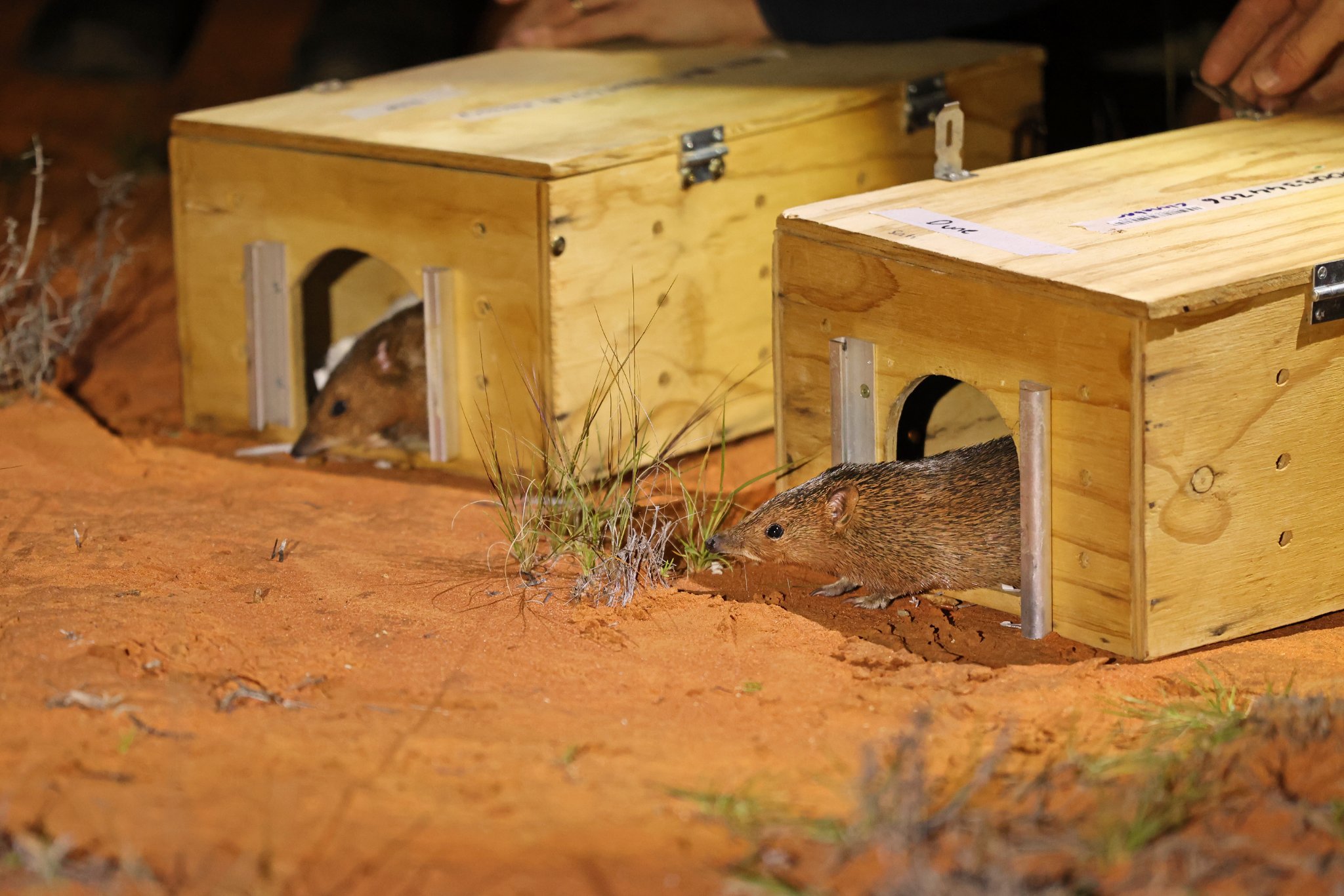
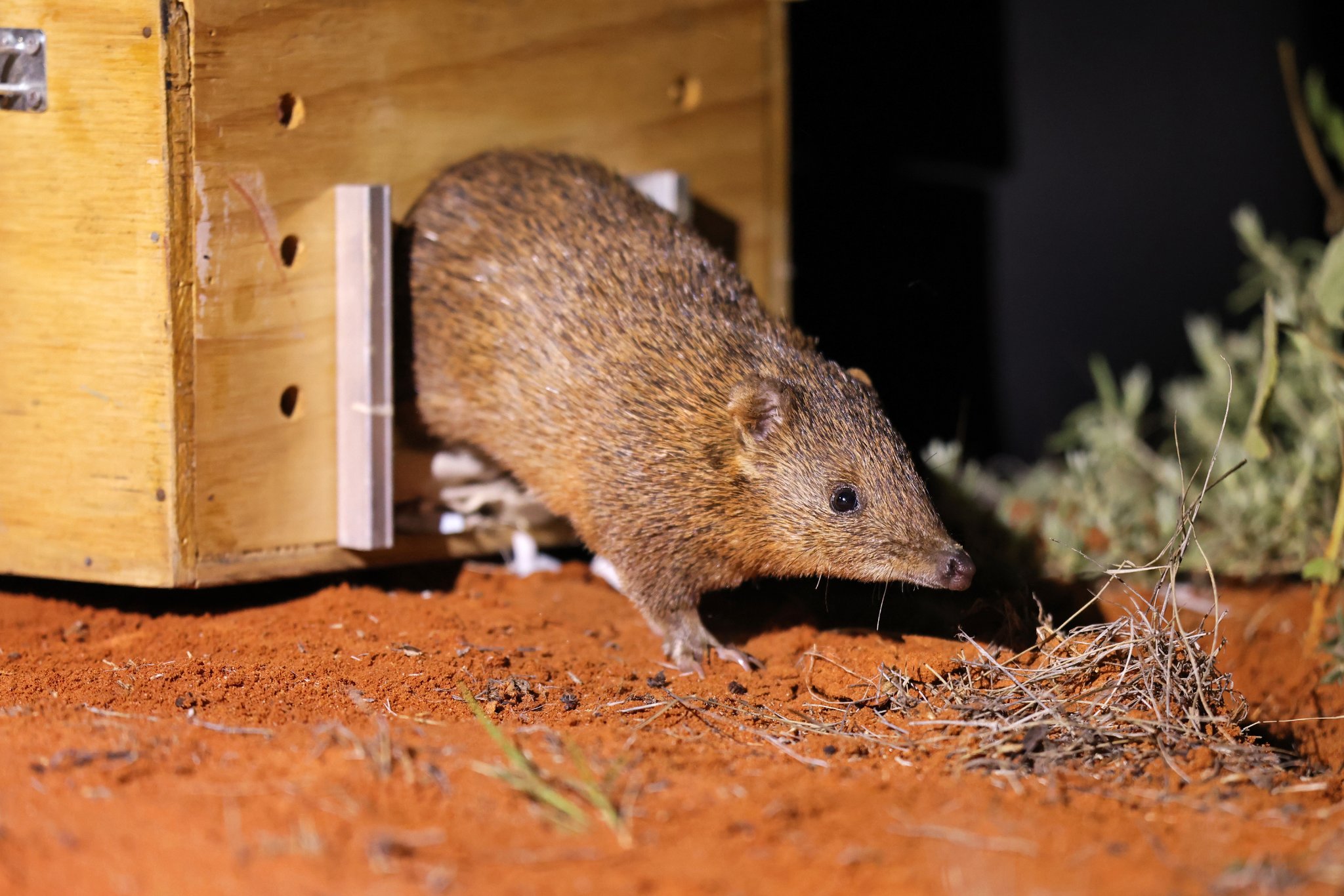
Stunning New Walk Opens In The Snowies
Important Koala Population Discovered In Kosciuszko National Park
How Australia’s expanding environmental movement is breaking the climate action deadlock in politics
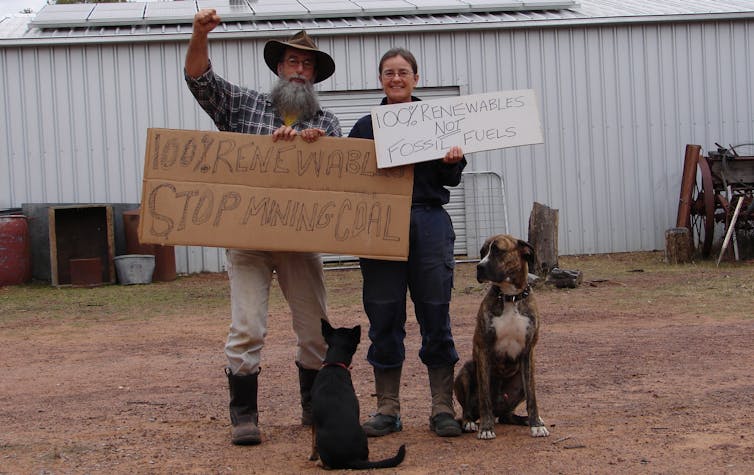
The federal election saw voters’ growing concern about Australia’s laggardly response to climate change finally addressed, with teal independents garnering seats in Liberal heartland and record votes for Greens candidates.
But what caused this seismic shift in Australia’s political landscape? And why now? We believe the rapid growth and diversification of Australia’s environmental movement since 2015 played an important role.
For example, almost a million Australians volunteered for an environmental charity in 2019, whether by planting trees, organising candidate forums or joining a climate strike.
The environmental movement is also increasingly crossing into traditionally conservative areas, with the emergence of groups such as the Coalition for Conservation and Farmers for Climate Action, which has united 7,000 farmers and 1,200 agriculture industry supporters.
Much of this work remains invisible and takes time, despite being punctuated by highly visible uprisings. And after many years, it may be finally precipitating the end of the climate wars.
Challenging Stereotypes
Many Australians will already be familiar with iconic environmental campaigns such as the Franklin Blockade in Tasmania in the early 1980s, which was pivotal in the evolution of Australia’s environmental movement.
More recently, the Extinction Rebellion and School Strike 4 Climate protests have gained substantial public attention in Australia.
Behind these well-known protests is a diversifying and rapidly expanding environmental movement. In recent years, hundreds of new groups have appeared, and many are actively challenging the activist stereotype characterised by labels such as hippies, extremists, or zealots.
Groups such as First Nations Clean Energy Network, Emergency Leaders for Climate Action, and the Investor Group on Climate Change have normalised calls for climate action in new industry sectors, and across regional and remote communities.
Many of these groups are using innovative methods to bring about change. Market Forces, for example, applies financial levers to challenge corporate support for the fossil fuel industry.
Wangan and Jagalingou Traditional Owners have established a sovereignty camp inside the Adani coal mining lease after their native title rights were extinguished.
And Next Economy canvassed regional communities, discovering a strong desire for clear and well-resourced transition plans for a zero emissions economy.
Meanwhile, philanthropic organisations are increasingly prioritising funding for climate activism. Other organisations offer research services, resources, training and fellowships for people demanding social and environmental change.
Building Consensus On Climate Action
Tactics we’ve seen activists use to demand climate action include the 2019 street blockades, die-ins and mass strikes by Extinction Rebellion and School Strike 4 Climate.
These actions put climate change onto the public agenda by generating widespread media attention. But they represent just a fraction of environmental movement activities.
Most environmental movement activity seeks to build consensus on climate change with those who share different values and worldviews.
Our extensive empirical analysis published last year found between 2010 and 2019, environmental groups advertised more than 24,000 events on Facebook alone, such as film screenings, seminars and clean-ups.
Many Australians have now felt impacts of the climate crisis. The 2019-2020 bushfires affected 80% of Australians whether directly or indirectly. Tens of thousands of people were displaced by the recent floods in New South Wales and Queensland.
By sharing heart-wrenching accounts of climate change-related harm, groups such as Bushfire Survivors for Climate Action are able to influence peoples’ opinions and beliefs on climate change .
The diversification of groups has also increased calls for climate action from conservative voices, which have been closely tied to climate scepticism in Australia.
But research from 2021 shows how amplifying these voices within the environmental movement can help normalise climate action within conservative ideology. Conservatives are also more likely to support messages delivered by other conservatives.
We can see these processes playing out in groups such as Farmers for Climate Action. Farmers, traditionally represented by conservative politicians famous for questioning climate science, have become increasingly frustrated about climate inaction.
By championing the economic opportunities and food security benefits delivered by strong climate policy, Farmers for Climate Action have helped connect farmers’ identity to environmental stewardship, while preserving conservative values and outlooks.
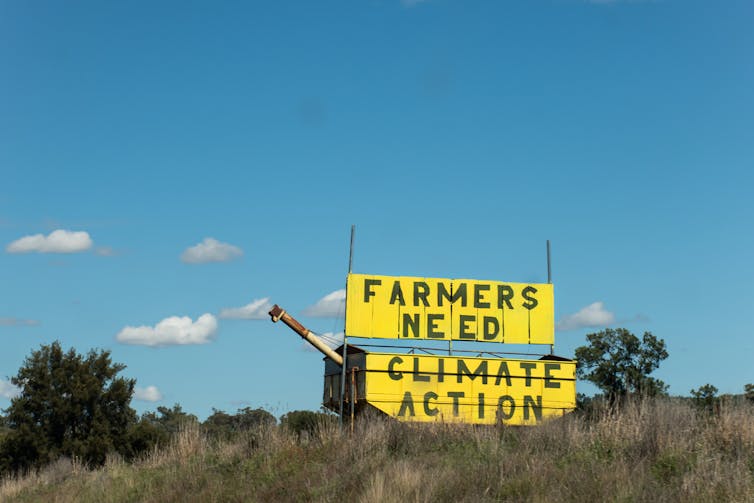
More Than One Goal
For many groups, the election is only one way of creating change to adequately tackle climate change in Australia. They continue to take action in different ways.
Some, such as Australian Parents for Climate Action, are building community groups working on local issues. This includes installing solar panels and batteries in schools and early childhood centres.
Original Power, a community-focused Aboriginal organisation, seeks self-determination and recognition that Indigenous rights go hand in hand with climate crisis solutions.
And Better Futures is building an alliance of public and private sector leaders to showcase individual and collaborative climate action across industry sectors and communities.
Groups such as these are organising hundreds of new campaigns every year from local to national scale, many of which are achieving their goals.
What Does This Mean For The New Government?
Entrenched interests seeking to maintain the fossil fuel industry and media-supported climate denial have propped up political inaction on climate change, and perpetuated Australia’s relentless climate wars for decades.
While the Albanese government has set a stronger emissions reduction target and promises to inject more renewables into the grid, it insists on continuing to support the emissions-intensive gas industry.
This year’s election offers a chance for the federal government to chart a new way forward. Whether politicians grasp this opportunity remains to be seen.
Will the government heed the call that voters expect greater climate action? Will Labor forge a path beyond fossil fuels, one that doesn’t leave coal and gas communities behind? And how far will the Greens and teal independents push Labor to rise to the challenge?
The environmental movement is now tightly woven into communities across Australia and its demands are clear. It has achieved demonstrable impact and wields considerable power to affect change. Politicians ignore it at their peril.![]()
Robyn Gulliver, Postdoctoral Research Fellow, The University of Queensland
This article is republished from The Conversation under a Creative Commons license. Read the original article.
Ice world: Antarctica’s riskiest glacier is under assault from below and losing its grip
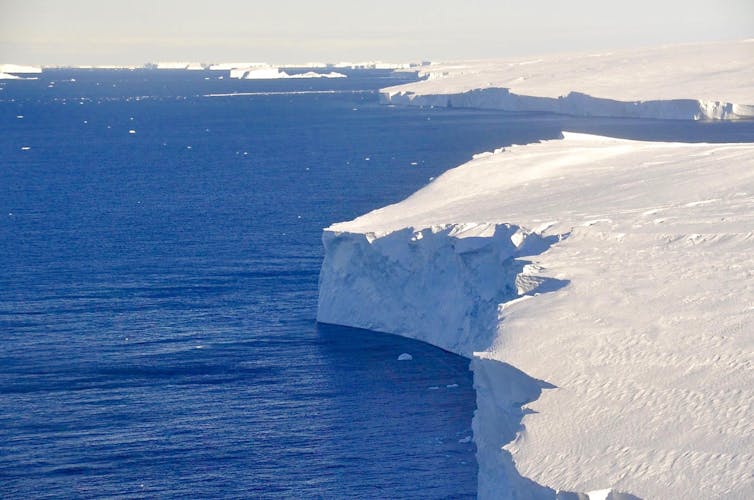
Flying over Antarctica, it’s hard to see what all the fuss is about. Like a gigantic wedding cake, the frosting of snow on top of the world’s largest ice sheet looks smooth and unblemished, beautiful and perfectly white. Little swirls of snow dunes cover the surface.
But as you approach the edge of the ice sheet, a sense of tremendous underlying power emerges. Cracks appear in the surface, sometimes organized like a washboard, and sometimes a complete chaos of spires and ridges, revealing the pale blue crystalline heart of the ice below.
As the plane flies lower, the scale of these breaks steadily grows. These are not just cracks, but canyons large enough to swallow a jetliner, or spires the size of monuments. Cliffs and tears, rips in the white blanket emerge, indicating a force that can toss city blocks of ice around like so many wrecked cars in a pileup. It’s a twisted, torn, wrenched landscape. A sense of movement also emerges, in a way that no ice-free part of the Earth can convey – the entire landscape is in motion, and seemingly not very happy about it.
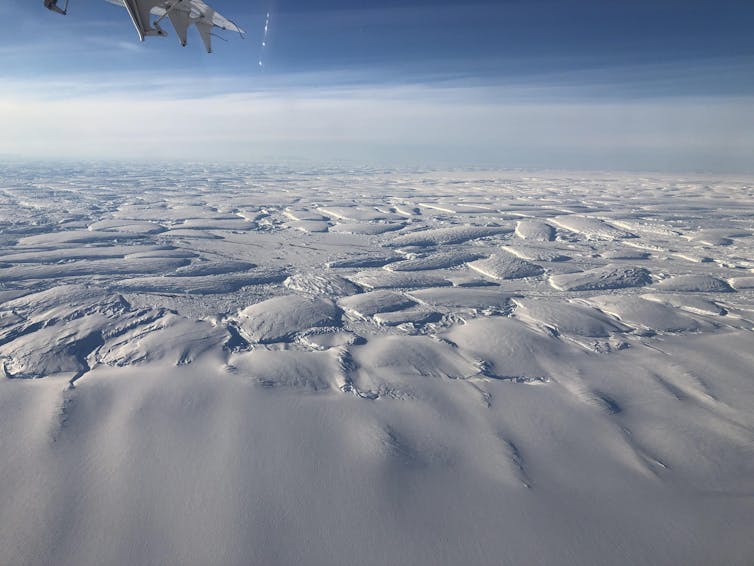
Antarctica is a continent comprising several large islands, one of them the size of Australia, all buried under a 10,000-foot-thick layer of ice. The ice holds enough fresh water to raise sea level by nearly 200 feet.
Its glaciers have always been in motion, but beneath the ice, changes are taking place that are having profound effects on the future of the ice sheet – and on the future of coastal communities around the world.
Breaking, Thinning, Melting, Collapsing
Antarctica is where I work. As a polar scientist I’ve visited most areas of the ice sheet in more than 20 trips to the continent, bringing sensors and weather stations, trekking across glaciers, or measuring the speed, thickness and structure of the ice.
Currently, I’m the U.S. coordinating scientist for a major international research effort on Antarctica’s riskiest glacier – more on that in a moment. I have gingerly crossed crevasses, trodden carefully on hard blue windswept ice, and driven for days over the most monotonous landscape you can imagine.
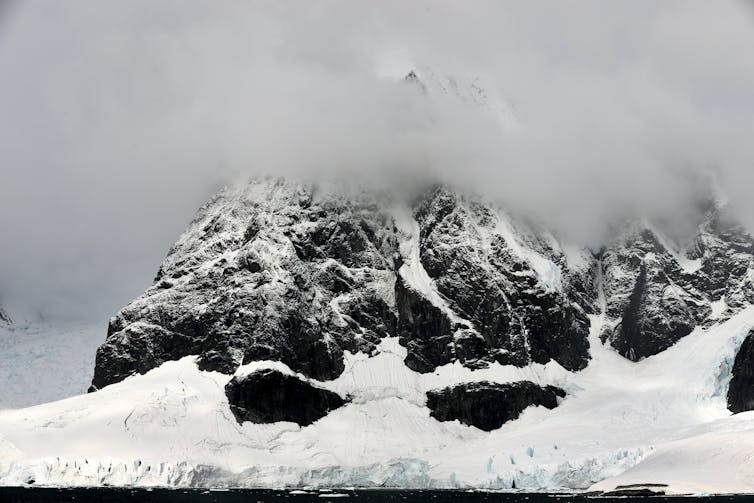
For most of the past few centuries, the ice sheet has been stable, as far as polar science can tell. Our ability to track how much ice flows out each year, and how much snow falls on top, extends back just a handful of decades, but what we see is an ice sheet that was nearly in balance as recently as the 1980s.
Early on, changes in the ice happened slowly. Icebergs would break away, but the ice was replaced by new outflow. Total snowfall had not changed much in centuries – this we knew from looking at ice cores – and in general the flow of ice and the elevation of the ice sheet seemed so constant that a main goal of early ice research in Antarctica was finding a place, any place, that had changed dramatically.
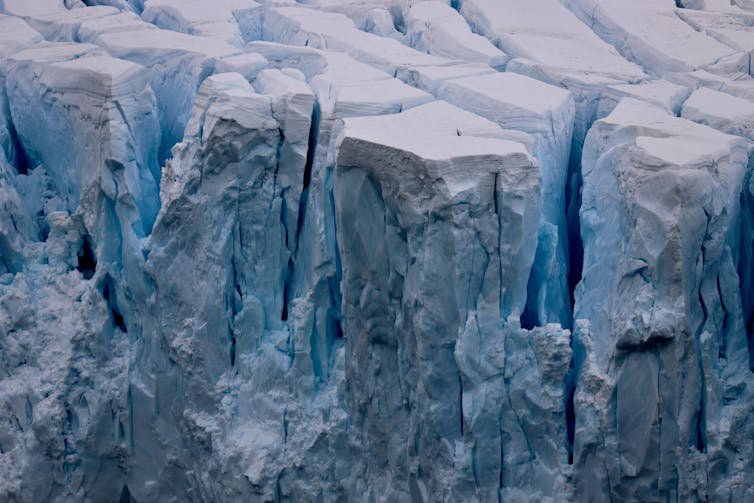
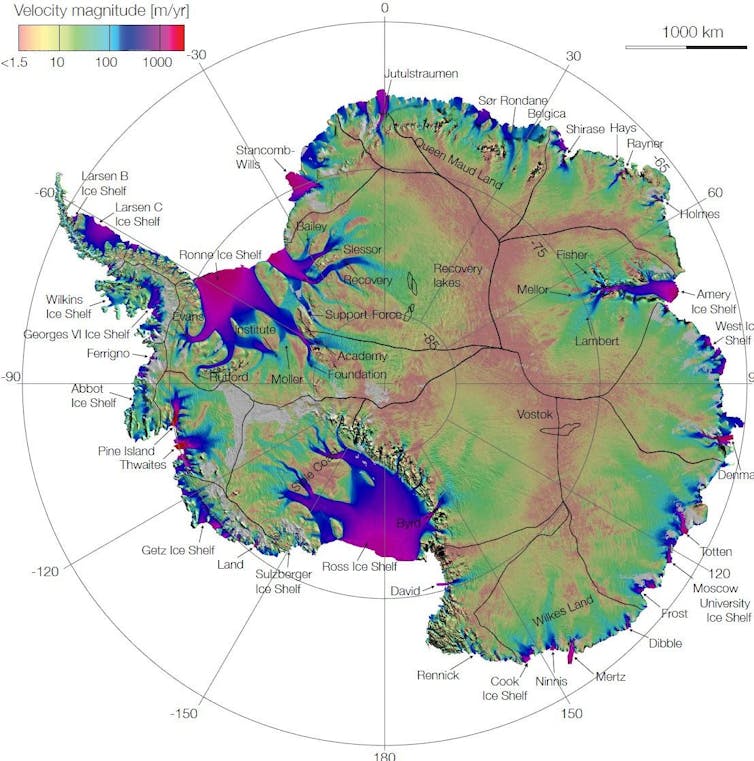
But now, as the surrounding air and ocean warm, areas of the Antarctic ice sheet that had been stable for thousands of years are breaking, thinning, melting, or in some cases collapsing in a heap. As these edges of the ice react, they send a powerful reminder: If even a small part of the ice sheet were to completely crumble into the sea, the impact for the world’s coasts would be severe.
Like many geoscientists, I think about how the Earth looks below the part that we can see. For Antarctica, that means thinking about the landscape below the ice. What does the buried continent look like – and how does that rocky basement shape the future of the ice in a warming world?
Visualizing The World Below The Ice
Recent efforts to combine data from hundreds of airplane and ground-based studies have given us a kind of map of the continent below the ice. It reveals two very different landscapes, divided by the Transantarctic Mountains.
In East Antarctica, the part closer to Australia, the continent is rugged and furrowed, with several small mountain ranges. Some of these have alpine valleys, cut by the very first glaciers that formed on Antarctica 30 million years ago, when its climate resembled Alberta’s or Patagonia’s. Most of East Antarctica’s bedrock sits above sea level. This is where the city-size Conger ice shelf collapsed amid an unusually intense heat wave in March 2022.
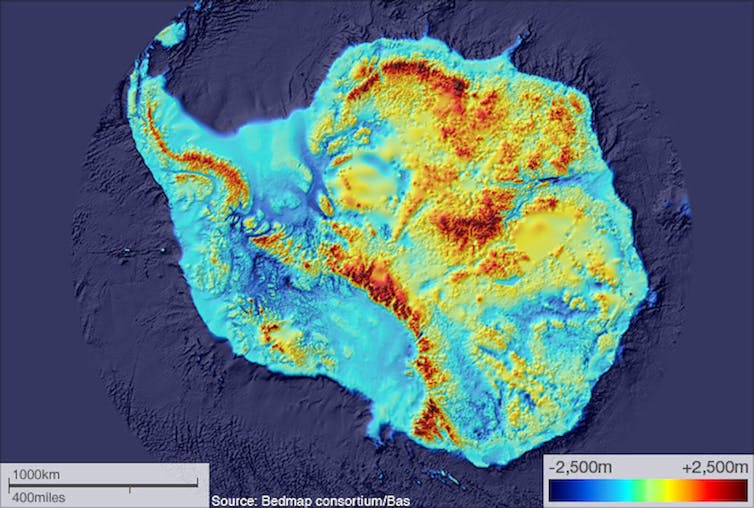
In West Antarctica the bedrock is far different, with parts that are far deeper. This area was once the ocean bottom, a region where the continent was stretched and broken into smaller blocks with deep seabed between. Large islands made of volcanic mountain ranges are linked together by the thick blanket of ice. But the ice here is warmer, and moving faster.
As recently as 120,000 years ago, this area was probably an open ocean – and definitely so in the past 2 million years. This is important because our climate today is fast approaching temperatures like those of a few million years ago.
The realization that the West Antarctic ice sheet was gone in the past is the cause of great concern in the global warming era.
Early Stages Of A Large-Scale Retreat
Toward the coast of West Antarctica is a large area of ice called Thwaites Glacier. This is the widest glacier on earth, at 70 miles across, draining an area nearly as large as Idaho.
Satellite data tell us that it is in the early stages of a large-scale retreat. The height of the surface has been dropping by up to 3 feet each year. Huge cracks have formed at the coast, and many large icebergs have been set adrift. The glacier is flowing at over a mile per year, and this speed has nearly doubled in the past three decades.
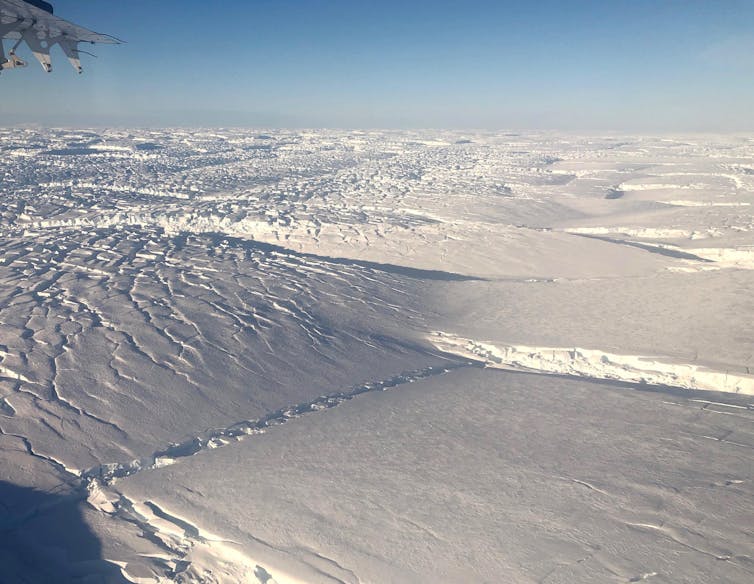
This area was noted early on as a place where the ice could lose its grip on the bedrock. The region was termed the “weak underbelly” of the ice sheet.
Some of the first measurements of the ice depth, using radio echo-sounding, showed that the center of West Antarctica had bedrock up to a mile and a half below sea level. The coastal area was shallower, with a few mountains and some higher ground; but a wide gap between the mountains lay near the coast. This is where Thwaites Glacier meets the sea.
This pattern, with deeper ice piled high near the center of an ice sheet, and shallower but still low bedrock near the coast, is a recipe for disaster – albeit a very slow-moving disaster.
Ice flows under its own weight – something we learned in high school earth science, but give it a thought now. With very tall and very deep ice near Antarctica’s center, a tremendous potential for faster flow exists. By being shallower near the edges, the flow is held back – grinding on the bedrock as it tries to leave, and having a shorter column of ice at the coast squeezing it outward.

If the ice were to step back far enough, the retreating front would go from “thin” ice – still nearly 3,000 feet thick – to thicker ice toward the center of the continent. At the retreating edge, the ice would flow faster, because the ice is thicker now. By flowing faster, the glacier pulls down the ice behind it, allowing it to float, causing more retreat. This is what’s known as a positive feedback loop – retreat leading to thicker ice at the front of the glacier, making for faster flow, leading to more retreat.
Warming Water: The Assault From Below
But how would this retreat begin? Until recently, Thwaites had not changed a lot since it was first mapped in the 1940s. Early on, scientists thought a retreat would be a result of warmer air and surface melting. But the cause of the changes at Thwaites seen in satellite data is not so easy to spot from the surface.
Beneath the ice, however, at the point where the ice sheet first lifts off the continent and begins to jut out over the ocean as a floating ice shelf, the cause of the retreat becomes evident. Here, ocean water well above the melting point is eroding the base of the ice, erasing it as an ice cube would disappear bobbing in a glass of water.
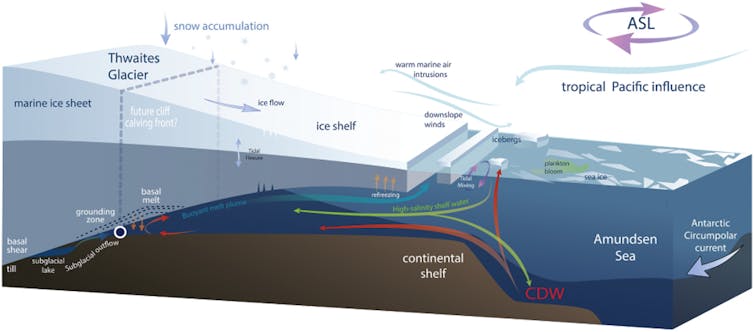
Water that is capable of melting as much as 50 to 100 feet of ice every year meets the edge of the ice sheet here. This erosion lets the ice flow faster, pushing against the floating ice shelf.
The ice shelf is one of the restraining forces holding the ice sheet back. But pressure from the land ice is slowly breaking this ice plate. Like a board splintering under too much weight, it is developing huge cracks. When it gives way – and mapping of the fractures and speed of flow suggests this is just a few years away – it will be another step that allows the ice to flow faster, feeding the feedback loop.
Up To 10 Feet Of Sea Level Rise
Looking back at the ice-covered continent from our camp this year, it is a sobering view. A huge glacier, flowing toward the coast, and stretching from horizon to horizon, rises up to the middle of the West Antarctic Ice Sheet. There is a palpable feeling that the ice is bearing down on the coast.
Ice is still ice – it doesn’t move that fast no matter what is driving it; but this giant area called West Antarctica could soon begin a multicentury decline that would add up to 10 feet to sea level. In the process, the rate of sea level rise would increase severalfold, posing large challenges for people with a stake in coastal cities. Which is pretty much all of us.![]()
Ted Scambos, Senior Research Scientist, CIRES, University of Colorado Boulder
This article is republished from The Conversation under a Creative Commons license. Read the original article.
Shifting seasons: using Indigenous knowledge and western science to help address climate change impacts
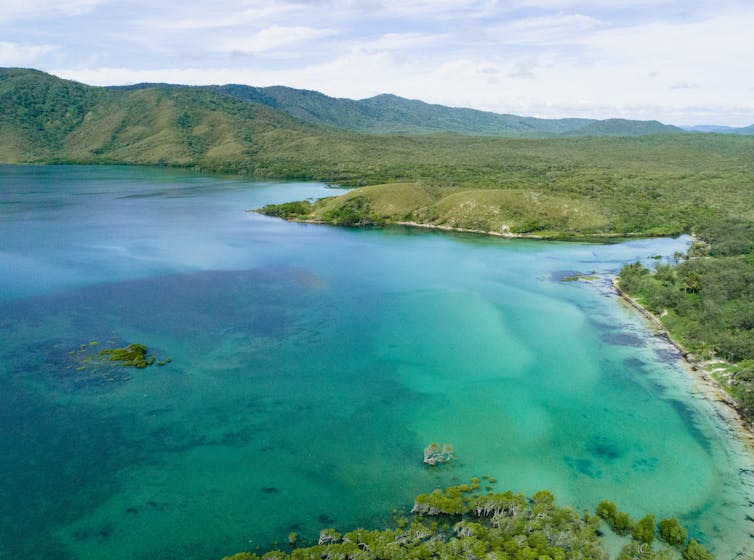
Traditional Owners in Australia are the creators of millennia worth of traditional ecological knowledge – an understanding of how to live amid changing environmental conditions. Seasonal calendars are one of the forms of this knowledge best known by non-Indigenous Australians. But as the climate changes, these calendars are being disrupted.
How? Take the example of wattle trees that flower at a specific time of year. That previously indicated the start of the fishing season for particular species. Climate change is causing these plants to flower later. In response, Traditional Owners on Yuku Baja Muliku (YBM) Country near Cooktown are having to adapt their calendars and make new links.
That’s not all. The seasonal timing of cultural burning practices is changing in some areas. Changes to rainfall and temperature alter when high intensity (hot) burns and low intensity (cool) burns are undertaken.
Seasonal connections vital to Traditional Owners’ culture are decoupling.
To systematically document changes, co-author Larissa Hale and her community worked with western scientists to pioneer a Traditional Owner-centred approach to climate impacts on cultural values. This process, published last week, could also help Traditional Owners elsewhere to develop adaptive management for their Indigenous heritage.
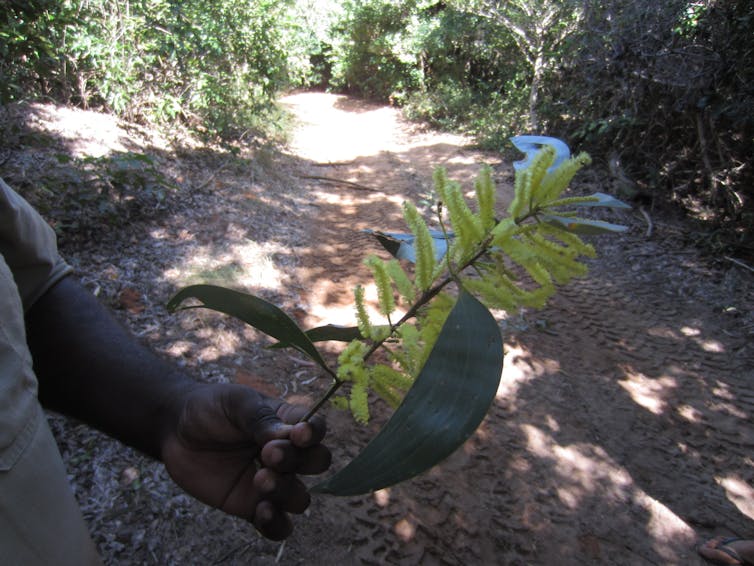
Climate Change Threatens First Nations - Their Perspectives Must Be Heard
Australia’s First Nations people face many threats from climate change, ranging from impacts on food availability to health. For instance, rising seas are already flooding islands in the Torres Strait with devastating consequences.
The most recent Intergovernmental Panel on Climate Change report on impacts and adaption noted in the Australasia chapter that climate-related impacts on Aboriginal and Torres Strait Islander peoples, their country and cultures are “pervasive, complex and compounding.”
While it is important these impacts are recorded, the dominant source of the data is academic literature based on western science. Impacts and pressures Traditional Owners are seeing and managing on their country must be assessed and managed from their unique perspective.
Traditional Owners have survived and adapted to climatic shifts during their 60,000+ years in Australia. This includes sea-level rise that flooded the area that is now the Great Barrier Reef and extreme rainfall variability. As a result, they have developed a fine-tuned sense of nature’s variability over time.
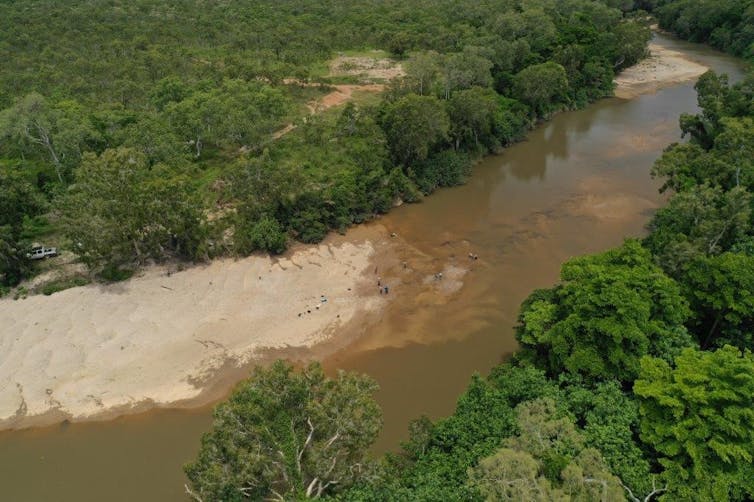
So What Did We Do?
Worried about the changes they were seeing on their Land and Sea Country around Archer Point in North Queensland, the YBM people worked with scientists from James Cook University to create a new way to assess impacts on cultural values.
To do this, we drew on the values-based, science-driven, and community-focused approach of the climate vulnerability index. It was the first time this index had been used to assess values of significance for Indigenous people.
YBM people responded to key prompts to assess changes to their values, including:
- What did the value look like 100 years ago?
- What does it look like now?
- What do you expect it will look like in the climate future around 2050?
- What management practices relate to that value and will they change?
We then discussed what issues have emerged from these climatic changes.
Using this process, we were able to single out issues directly affecting how YBM people live. For instance, traditional food sources can be affected by climate change. In the past, freshwater mussels in the Annan River were easy to access and collect. Extreme temperature events in the last 10 years have contributed to mass die-offs. Now mussels are much smaller in size and tend to be far fewer in number.
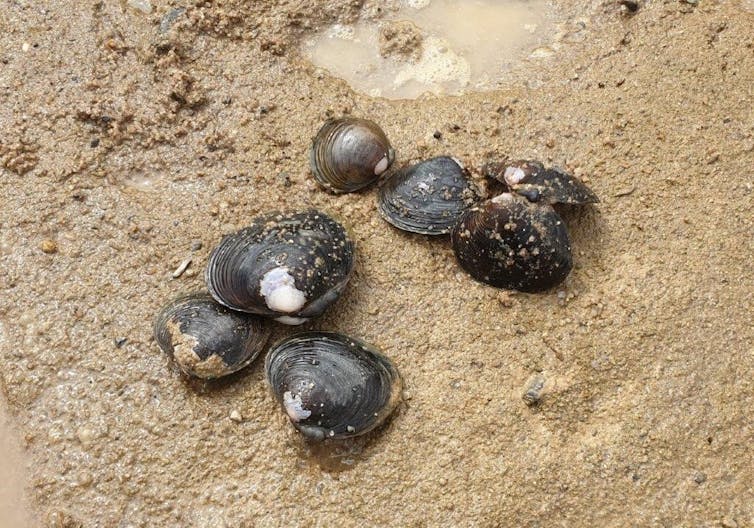
Through the process we also documented that changes to rainfall and temperature have altered the time when some plant foods appear. This is particularly true for plants that depend upon cultural burns to flower or put up shoots. This in turn has meant that the timing of collecting and harvesting has changed.
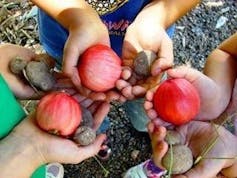
These climate-linked changes challenge existing bodies of traditional knowledge, altering connections between different species, ecosystems and weather patterns across Land and Sea Country.
A key part of this process was developing a mutually beneficial partnership between traditional ecological knowledge holders and western scientists. It was critical to establish a relationship built on trust and respect.
Walking the country first – seeing rivers, mangroves, beaches, headlands, bush, wetlands, and looking out at Sea Country – helped researchers understand the perspectives of Traditional Owners. Honouring experience and knowledge (especially that held by Elders and Indigenous rangers) was important. Indigenous cultural and intellectual property protocols were recognised and respected throughout the assessment.
Respecting and working collaboratively with Traditional Owners as expert scientists in their own knowledge system was critical for success. Any effort to incorporate traditional ecological knowledge in climate change assessments must protect sensitive traditional knowledge.
As climate change will continue and accelerate, we must work together to minimise resulting impacts on the cultural heritage of First Nations peoples.![]()
Karin Gerhardt, PhD student, James Cook University; Jon C. Day, PSM, Adjunct Senior Research Fellow, ARC Centre of Excellence for Coral Reef Studies, James Cook University; Larissa Hale, Yuku Baja Muliku Traditional Owner, Indigenous Knowledge, and Scott F. Heron, Associate Professor in Physics, James Cook University
This article is republished from The Conversation under a Creative Commons license. Read the original article.
A huge Atlantic ocean current is slowing down. If it collapses, La Niña could become the norm for Australia
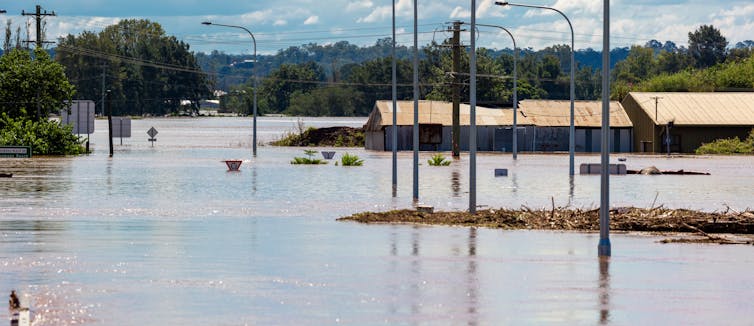
Climate change is slowing down the conveyor belt of ocean currents that brings warm water from the tropics up to the North Atlantic. Our research, published today in Nature Climate Change, looks at the profound consequences to global climate if this Atlantic conveyor collapses entirely.
We found the collapse of this system – called the Atlantic meridional overturning circulation – would shift the Earth’s climate to a more La Niña-like state. This would mean more flooding rains over eastern Australia and worse droughts and bushfire seasons over southwest United States.
East-coast Australians know what unrelenting La Niña feels like. Climate change has loaded our atmosphere with moister air, while two summers of La Niña warmed the ocean north of Australia. Both contributed to some of the wettest conditions ever experienced, with record-breaking floods in New South Wales and Queensland.
Meanwhile, over the southwest of North America, a record drought and severe bushfires have put a huge strain on emergency services and agriculture, with the 2021 fires alone estimated to have cost at least US$70 billion.
Earth’s climate is dynamic, variable, and ever-changing. But our current trajectory of unabated greenhouse gas emissions is giving the whole system a giant kick that’ll have uncertain consequences – consequences that’ll rewrite our textbook description of the planet’s ocean circulation and its impact.
What Is The Atlantic Overturning Meridional Circulation?
The Atlantic overturning circulation comprises a massive flow of warm tropical water to the North Atlantic that helps keep European climate mild, while allowing the tropics a chance to lose excess heat. An equivalent overturning of Antarctic waters can be found in the Southern Hemisphere.
Climate records reaching back 120,000 years reveal the Atlantic overturning circulation has switched off, or dramatically slowed, during ice ages. It switches on and placates European climate during so-called “interglacial periods”, when the Earth’s climate is warmer.
Since human civilisation began around 5,000 years ago, the Atlantic overturning has been relatively stable. But over the past few decades a slowdown has been detected, and this has scientists worried.
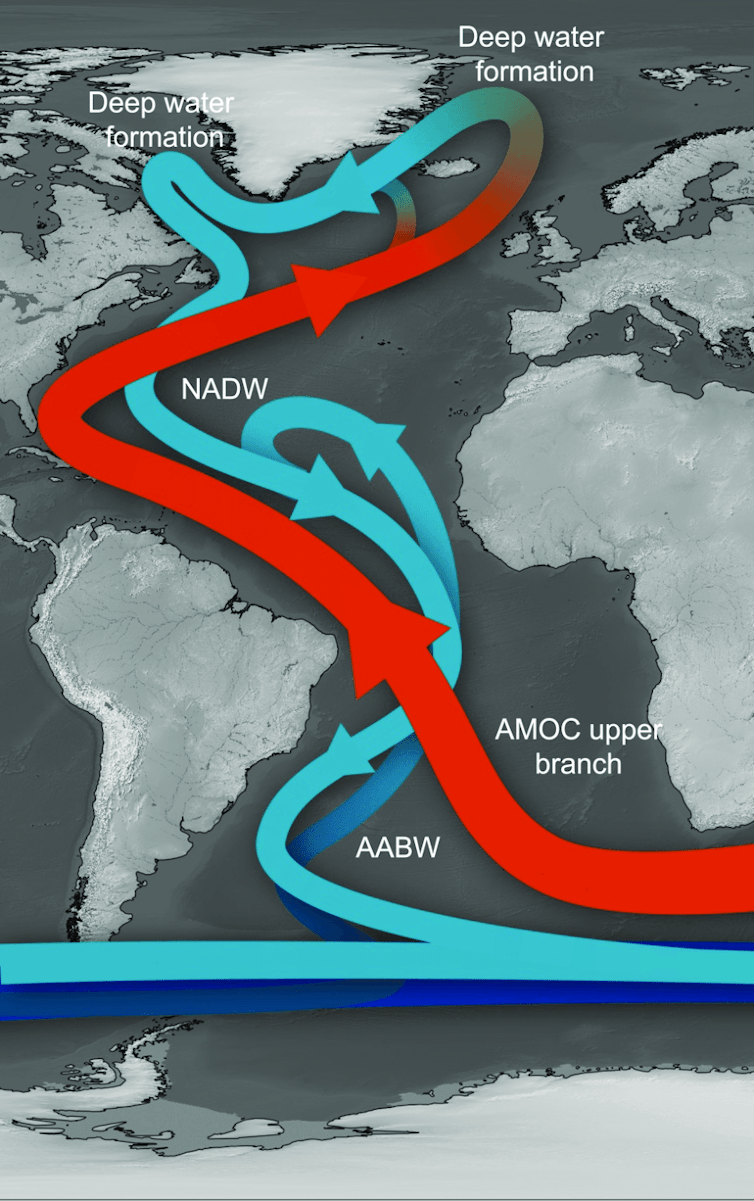
Why the slowdown? One unambiguous consequence of global warming is the melting of polar ice caps in Greenland and Antarctica. When these icecaps melt they dump massive amounts of freshwater into the oceans, making water more buoyant and reducing the sinking of dense water at high latitudes.
Around Greenland alone, a massive 5 trillion tonnes of ice has melted in the past 20 years. That’s equivalent to 10,000 Sydney Harbours worth of freshwater. This melt rate is set to increase over the coming decades if global warming continues unabated.
A collapse of the North Atlantic and Antarctic overturning circulations would profoundly alter the anatomy of the world’s oceans. It would make them fresher at depth, deplete them of oxygen, and starve the upper ocean of the upwelling of nutrients provided when deep waters resurface from the ocean abyss. The implications for marine ecosystems would be profound.
With Greenland ice melt already well underway, scientists estimate the Atlantic overturning is at its weakest for at least the last millennium, with predictions of a future collapse on the cards in coming centuries if greenhouse gas emissions go unchecked.
The Ramifications Of A Slowdown
In our study, we used a comprehensive global model to examine what Earth’s climate would look like under such a collapse. We switched the Atlantic overturning off by applying a massive meltwater anomaly to the North Atlantic, and then compared this to an equivalent run with no meltwater applied.
Our focus was to look beyond the well-known regional impacts around Europe and North America, and to check how Earth’s climate would change in remote locations, as far south as Antarctica.
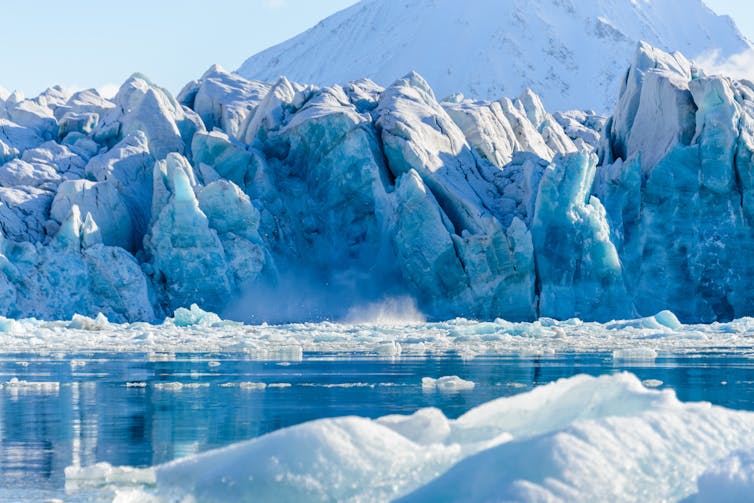
The first thing the model simulations revealed was that without the Atlantic overturning, a massive pile up of heat builds up just south of the Equator.
This excess of tropical Atlantic heat pushes more warm moist air into the upper troposphere (around 10 kilometres into the atmosphere), causing dry air to descend over the east Pacific.
The descending air then strengthens trade winds, which pushes warm water towards the Indonesian seas. And this helps put the tropical Pacific into a La Niña-like state.
Australians may think of La Niña summers as cool and wet. But under the long-term warming trend of climate change, their worst impacts will be flooding rain, especially over the east.
We also show an Atlantic overturning shutdown would be felt as far south as Antarctica. Rising warm air over the West Pacific would trigger wind changes that propagate south to Antarctica. This would deepen the atmospheric low pressure system over the Amundsen Sea, which sits off west Antarctica.
This low pressure system is known to influence ice sheet and ice shelf melt, as well as ocean circulation and sea-ice extent as far west as the Ross Sea.
A New World Order
At no time in Earth’s history, giant meteorites and super-volcanos aside, has our climate system been jolted by changes in atmospheric gas composition like what we are imposing today by our unabated burning of fossil fuels.
The oceans are the flywheel of Earth’s climate, slowing the pace of change by absorbing heat and carbon in vast quantities. But there is payback, with sea level rise, ice melt, and a significant slowdown of the Atlantic overturning circulation projected for this century.
Now we know this slowdown will not just affect the North Atlantic region, but as far away as Australia and Antarctica.
We can prevent these changes from happening by growing a new low-carbon economy. Doing so will change, for the second time in less than a century, the course of Earth’s climate history – this time for the better.![]()
Matthew England, Scientia Professor and Deputy Director of the ARC Australian Centre for Excellence in Antarctic Science (ACEAS), UNSW Sydney; Andréa S. Taschetto, Associate Professor, UNSW Sydney, and Bryam Orihuela-Pinto, PhD Candidate, UNSW Sydney
This article is republished from The Conversation under a Creative Commons license. Read the original article.
Australia has overshot three planetary boundaries based on how we use land
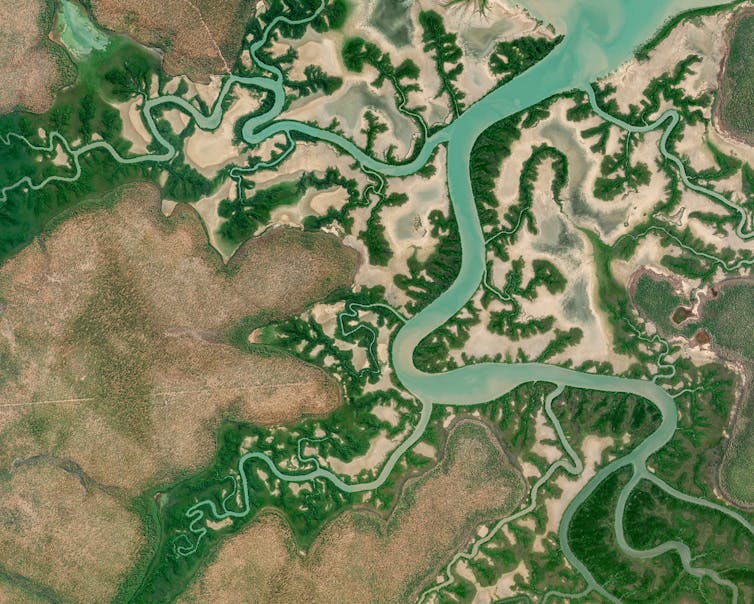
We used to believe the world’s resources were almost limitless. But as we spread out across the planet, we consumed more and more of these resources. For decades, scientists have warned we are approaching the limits of what the environment can tolerate.
In 2009, the influential Stockholm Resilience Centre first published its planetary boundaries framework. The idea is simple: outline the global environmental limits within which humanity could develop and thrive. This concept has become popular as a way to grasp our impact on nature.
For the first time, we have taken these boundaries – which can be hard to visualise on a global scale – and applied them to Australia. We found Australia has already overshot three of these: biodiversity, land-system change and nitrogen and phosphorus flows. We’re also approaching the boundaries for freshwater use and climate change.
The nation’s land use is a key contributor to these trends, with natural systems under increasing pressure as a result of many land management practices. Luckily, we already know many of the solutions for living within our limits, such as waste management, conservation and restoration of natural lands in conjunction with agriculture, and shifts in food production.
What Are Planetary Boundaries?
In 2015, scientists took stock of how humanity was tracking, warning four of nine boundaries had already been crossed.
While such warnings make global headlines, they can also leave people wondering, “What does this actually mean for me?”
This is the question we have sought to answer for Australia and its land use sector. We took five of these global boundaries and calculated what Australia’s “share” of those would be in our new technical report.
We then went one step further, breaking down what these boundaries mean for Australia’s land use industries, such as agriculture and forestry.
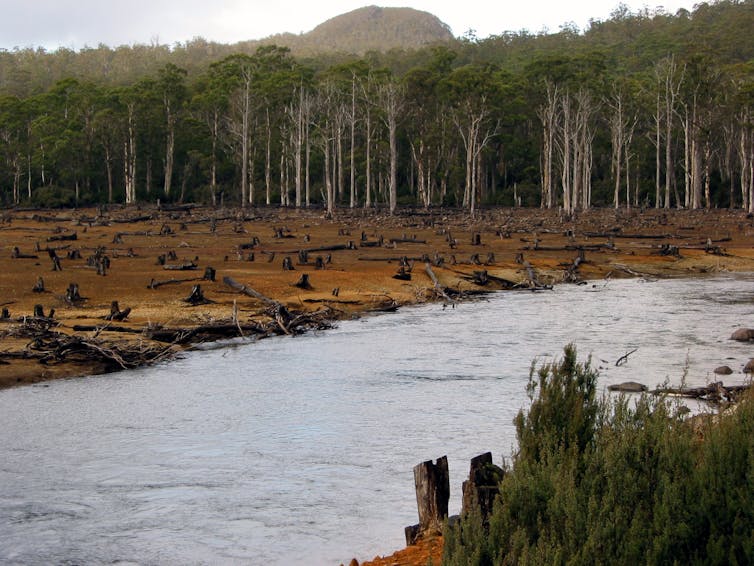
These Limits Are Not Abstractions – They’re Real
These are real-world limits. Pushing past them has real-world consequences.
Take nitrogen and phosphorus flows, which refers to the levels of these chemicals in the nation’s waterways.
In around 50% of our river catchments, we already have concentrations of nitrogen and phosphorus past the safe level for the health of the environment. These chemicals are applied as fertiliser to cropland and pasture. If there’s too much, it can run off into waterways. Once in our rivers, these chemicals can fuel dangerous algal blooms which can force the closure of popular recreational areas, fill lakes with weeds and hurt fish and other wildlife.
Tackling one environmental issue often has benefits for others. Improving water quality has benefits for biodiversity, because the plants and animals supported by those rivers have better water to live off and in.
Why does biodiversity matter? The diversity of life on our continent plays a critical role in keeping ecosystems stable and sustaining vital services – such as fresh air and water – they provide to wildlife and to us.
It’s well known areas with lower numbers of species and lower genetic diversity prove generally less resilient to shocks. That means these environments are at higher risk of tipping into a state where they can no longer provide the services vital to life.
Different species occupy different niches within ecosystems, meaning the loss of one or two can erode the functioning of the system as a whole.
Protecting and restoring biodiversity is therefore critical to achieving planetary health. Unfortunately, biodiversity is among the boundaries Australia has already overshot. The number of species threatened by our activities is growing, and many of our endangered animals are at risk of extinction.
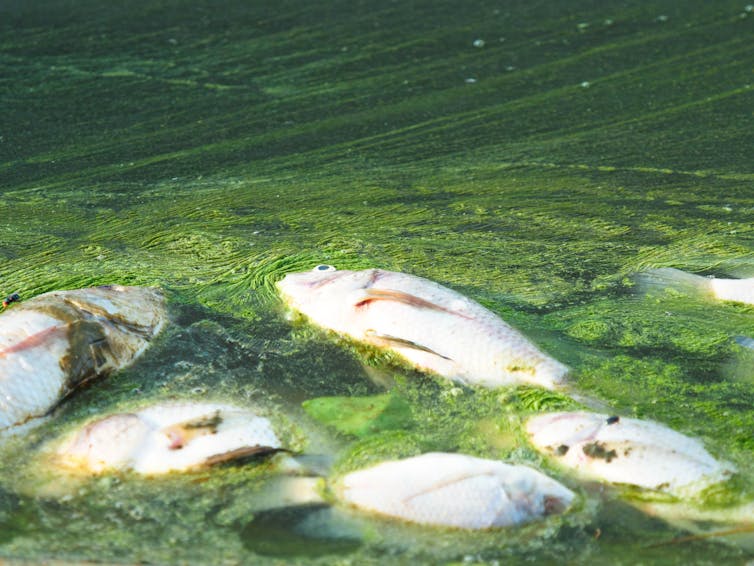
We Know What We Need To Do
With this report, we contribute to the national conversation about how Australia can stay within its fair share of planetary limits and contribute to the global effort for sustainable development.
Agriculture, forestry and other land use industries also have a critical role to play in reducing emissions and sequestering carbon. But the land use sector is under increasing pressure from growing populations, the impacts of climate change and extreme weather events.
Understanding what sustainability means in practical, measurable terms for Australia’s land use sector is vital to enable humanity to continue to prosper.![]()
Romy Zyngier, Senior Research Manager, Climateworks Centre
This article is republished from The Conversation under a Creative Commons license. Read the original article.
Get out and go fungal: why it’s a bumper time to spot our native fungi
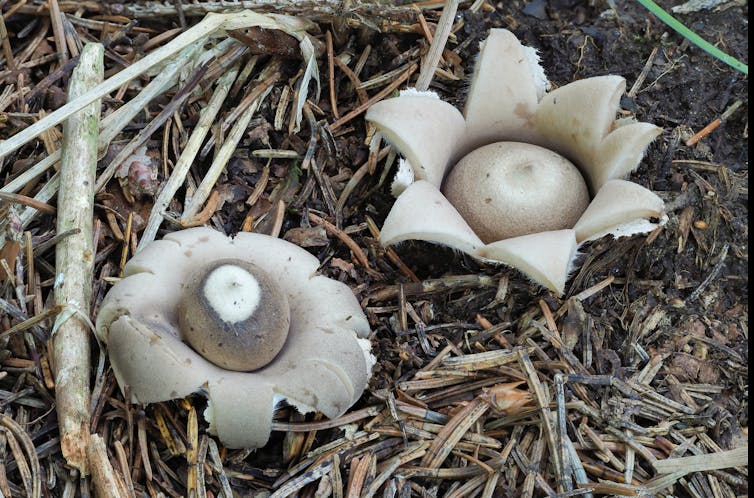
When COVID forced Melburnians to isolate during large parts of 2020 and 2021, many took the opportunity to walk around parks, creeks or remnant bush.
In your walks, you may have noticed the wonderful and diverse range of fungal fruiting bodies on display. Victoria’s display of puff balls, bracket fungi and fairy rings has been nothing short of splendid.
The fun’s not over, either. This year has been a particularly good one for fungus too, and here’s why. As you may recall, the harsh 2019-20 summer dried our soils, stressed much of our vegetation and led to major bushfires. In 2021, this switched abruptly to one of the wettest starts to a year on record in many places, courtesy of the La Niña climate pattern.
With the rains, the weather became ideal for fungal reproduction. We had warm, very moist soils and lovely warm and sunny autumnal days, perfect for fungi to send up their reproductive structures (you might know these as mushrooms and toadstools) and spread their spores. Conditions this good may not occur again for years so seize the opportunity to see them.

What You Can See In A Walk In The Park
Fungi are not just for adults. Oh no! They can entertain children for hours.
In 2020, our family group took a walk in Brimbank Park, in Melbourne’s northwest. The five year old leader waved his lucky stick/sword/wand in the air as we entered, declaring, “today we hunt fungus!” He was still doing so two hours later, closely followed by his younger brother.
Their first findings were puff balls, some brown and others like little white pebbles. If you squeeze these puff balls, a fine dust of spores can emerge like a mist. You don’t want to breathe them in but at a distance they are mostly harmless.
We spotted some like ordinary field mushrooms, but when you scratched their light tan surface a bright yellow colour emerged. If you were to eat these yellow-staining mushrooms you would be sick and potentially seriously ill. Some contain very powerful toxins and can prove to be deadly if eaten. Unless you know exactly what fungus you have, don’t even think of eating them. It’s advisable to wash hands well after handling any kind of fungi.
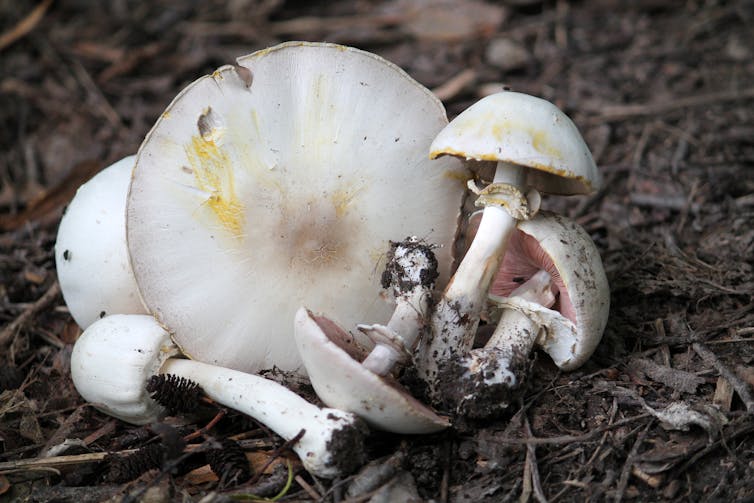
Spores are the means by which fungi reproduce themselves. Most are tiny but they can be dry like powder, damp and sticky, dull or brightly coloured, plain or ornately decorated and sometimes quite smelly. The dry spores can easily be dispersed by even a gentle breeze, but the sticky ones often adhere to an unsuspecting passer-by such as a bird, rabbit, dog or human sock.
We gave the little ones extra points if they looked at the fungus but left it intact, even if they couldn’t resist giving one or two a poke. Their next discovery gained even more points because you had to look up: it was a bracket fungus growing on a dead branch. Some of these are snowy white, but others are yellow or bright orange, almost like traffic lights. Some have an almost velvety outer texture while others appear to be made of woody rings like the tree upon which they are growing.
On dead trees, bracket fungi have the role of recycling old dead wood. Some don’t even wait until the tree dies. They gain access to the old wood at the tree’s centre and begin the decay process while the tree is still living. The fruiting bodies of these fungi look like little shelves on the trunk of the tree and can persist for decades. On some trees, multiple brackets form a veritable stairway to heaven. If you have a large bracket fungus on a large old branch or tree, it’s a good idea to get arboricultural advice about the safety of the tree.
Fairy Rings, Basket Fungus And Symbiotic Relationships
Our little posse of fungal hunters had travelled 100 metres into the park, but in the zigzag pattern of explorers, it had taken us an hour. A brown dried star-like structure was revealed as a dried puff ball, its spores well and truly blown and what was once a ball had peeled back as it dried into a near perfect star. In a section of mown grass, we come across the delicate mushrooms of a fairy ring. Excitement ensues.
Why is it a ring? Where are the fairies? Can you eat them? Not the fairies, the mushrooms! The fairies of course heard us coming and so they are hiding. No, you can’t eat them because they might be poisonous and make you sick.
Fairy rings form into a circle because they came from a single starting point and expanded outward from the centre at more or less the same rate.
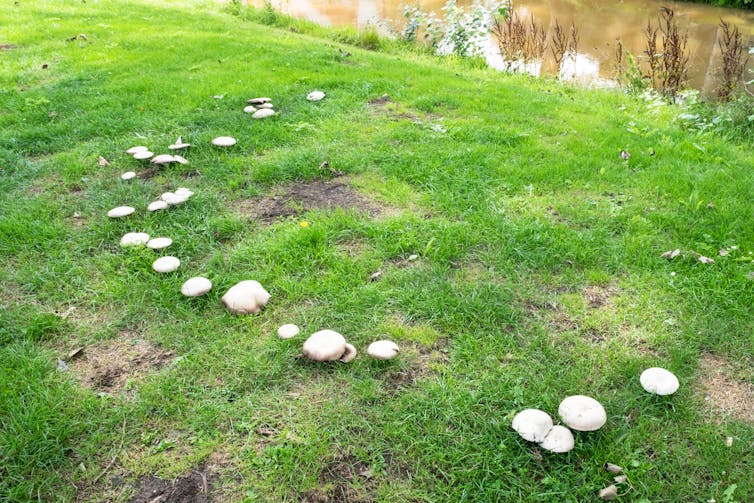
Is that a pebble? No it’s a fungus doing a brilliant impression of a pebble. We were camouflage experts now, and it couldn’t hide from us. Then a squeal. What is that? A soccer ball? No, old plastic. No, a dome. It’s a magnificent white basket fungus shaped like an intricate geodesic sphere. We left it for others to discover. With the mighty stick/sword/wand high in the air, we head for home.
Fungi are always there in our soils. Their fine thread structures, called hyphae, lie underfoot all year, but their fruiting bodies only appear under the right conditions. Many of these fungi entwine around the roots of specific plants and in many cases into the plant root cells themselves. The fungus offers water and nutrients to the plants and in return the plants give the fungus some of the carbohydrates they produce from photosynthesis. It’s a marvellously beneficial relationship.

We went a-hunting several more times, and the young ones never tired of the sport. Interacting closely with plants and fungi meets basic physical, mental and psychological needs hailing back to our early travel through natural ecosystems.
Finding and poring over plants and fungi engages all our senses – sight, hearing, smell, touch – and for experts only, taste. It’s no wonder all of us in the hunt feel the better for this purposeful forest bathing.
Spotting fungi above ground is a rare treat. If the weather gets too chilly, or if La Niña gives way to hot and dry El Niño, the fungi will vanish. But if we get a mild, wet winter, the fungal season can just roll on. That’s the thing about fungi, you can never be sure. They play by their own rules. ![]()
Gregory Moore, Doctor of Botany, The University of Melbourne
This article is republished from The Conversation under a Creative Commons license. Read the original article.
Our new environment super-department sounds great in theory. But one department for two ministers is risky
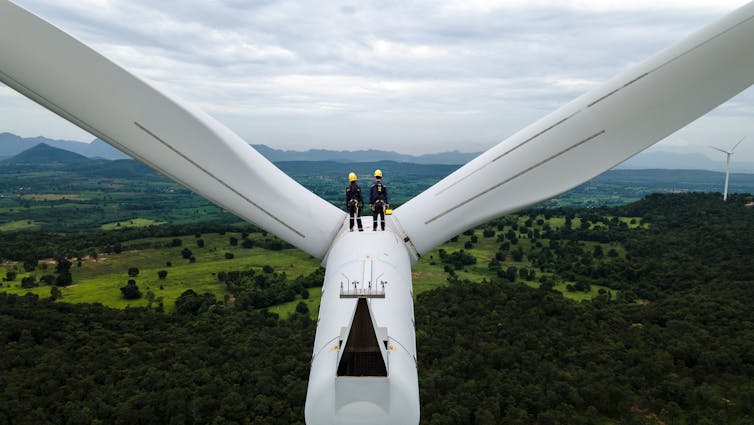
Good news, Australia – the environment is back. Our new government has introduced a new super-department covering climate change, energy, the environment and water.
But while the ministry move sounds great in theory, it’s risky in practice. Having one super-department supporting two ministers – Tanya Plibersek in environment and water, and Chris Bowen for climate change and energy – is likely to stretch the public service too far.
If a policy area is important enough to warrant its own cabinet minister, it also warrants a dedicated secretary and department. This is especially true for the shrunken environment department, which has to rebuild staff and know-how after having over a third of its budget slashed in the early Coalition years.
Supporting two cabinet ministers stretches department secretaries too thinly. It makes it hard for them to engage in the kind of deep policy development we need in such a difficult and fast-moving policy environment.
What Are The Politics Behind This Move?
Tanya Plibersek’s appointment last week as minister for the environment and water was the surprise of the new ministerial lineup.
Even if Plibersek’s move from education in opposition to environment in government was a political demotion for her, as some have suggested, placing the environment portfolio in the hands of someone so senior and well-regarded is a boon for the environment.
Having the environment in the broadest sense represented in Cabinet by two experienced and capable ministers is doubly welcome. It signifies a return to the main stage for our ailing natural world after years of relative neglect under the Coalition government.
It also makes good political sense, given the significant electoral gains made by the Greens on Labor’s left flank. While ‘climate’ rather than ‘environment’ was the word on everybody’s lips, other major environmental issues need urgent attention. Threatened species and declining biodiversity are only one disaster or controversy away from high political urgency.
When released at last, the 2021 State of the Environment Report will make environmental bad news public. Former environment minister Sussan Ley sat on the report for five months, leaving it for her successor to release it.
Now Comes The Avalanche Of Policy
Both ministers have a packed policy agenda, courtesy of Labor’s last minute commitment to creating an environmental protection agency, as well as responding to the urgent calls for change in the sweeping [2020 review] of Australia’s national environmental law (https://epbcactreview.environment.gov.au/resources/final-report).
That’s not half of it. Bowen is also tasked with delivering the government’s high-profile 43% emissions cuts within eight years, which includes the Rewiring the Nation effort to modernise our grid. He will also lead Australia’s bid to host the world’s climate summit, COP29, in 2024, alongside Pacific countries.
Plibersek also has to tackle major water reforms in the Murray Darling basin and develop new Indigenous heritage laws to respond to the parliamentary inquiry into the destruction of ancient rock art site Juukan Gorge by Rio Tinto.
Can One Big Department Cope With This Workload?
Creating a super-department is a bad idea. That’s because the agenda for both ministers is large and challenging. It will be a nightmare job for the department secretary tasked with supporting two ministers. It’s no comfort that the problem will be worse elsewhere, with the infrastructure department supporting four cabinet ministers.
Giving departmental secretaries wide responsibilities crossing lines of ministerial responsibility encourages them to reconcile policy tensions internally rather than putting them up to ministers, as they should.
The tension between large renewable energy projects and threatened species is a prime example of what can go wrong. Last year, environment minister Sussan Ley ruled a $50 billion renewable megaproject in the Pilbara could not proceed because of ‘clearly unacceptable’ impacts on internationally recognised wetlands south of Broome.
Ley’s ‘clearly unacceptable’ finding stopped the project at the first environmental hurdle. That’s despite the fact the very same project was awarded ‘major project’ status by the federal government in 2020.
The problem here is what might have been the right answer on a narrow environmental basis was the wrong answer more broadly.
If Australia is to achieve its potential as a clean energy superpower and as other renewable energy megaprojects move forward, we will need more sophisticated ways of avoiding such conflicts. This will require resolution of deep policy tensions – and that’s best done between ministers rather than between duelling deputy secretaries.
Super-departments also struggle to maintain coherence across the different programs they run. While large departments bring economies of scale, these benefits are more than offset by coordination and culture issues.
An early task for Glyn Davis, the new head of the prime minister’s department, will be to recommend a secretary for this new super-department of climate change, energy, the environment and water. In addition to the ability to absorb a punishing workload, the successful appointee will need high level juggling skills to support Plibersek and Bowen simultaneously.
Ironically, in dividing time between two ministers, she or he will be the least able to accept Plibersek’s call for staff of her new department to be ‘all in’ in turning her decisions into action.![]()
Peter Burnett, Honorary Associate Professor, ANU College of Law, Australian National University
This article is republished from The Conversation under a Creative Commons license. Read the original article.
This mosquito species from Papua New Guinea was lost for 90 years – until a photographer snapped a picture of it in Australia
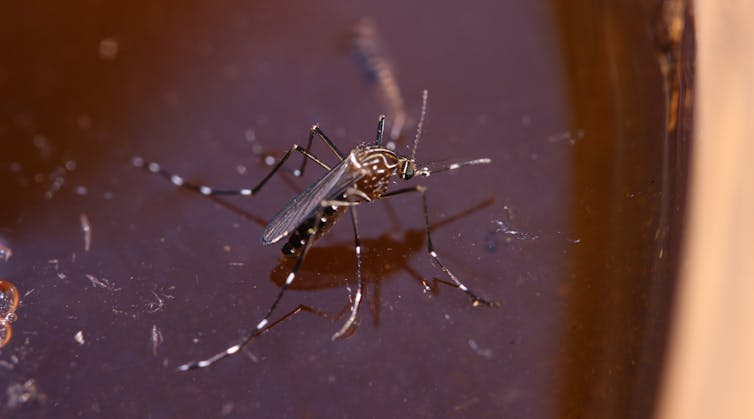
There are already plenty of mosquitoes in Australia. They bring pest and public health risks to many parts of the country.
Now a new species of mosquito, Aedes shehzadae, has been discovered 90 years after the first (and only other observation) of it in Papua New Guinea – and it’s thanks to citizen science.
Mosquitoes And Their Health Threats
Mosquitoes are simple creatures, but they pose complex health risks. The recent widespread arrival of Japanese encephalitis virus, which caused dozens of cases of disease and five deaths, is a reminder of the threat mosquitoes pose in Australia.
To address this threat, there are mosquito and mosquito-borne pathogen surveillance programs in states and territories around the country. Our borders are checked by the Department of Agriculture Water and Environment for the arrival of invasive mosquitoes with international travellers, their belongings, or freight.
These programs collect valuable information on local and invasive mosquitoes. But they can’t be everywhere – which is where citizen science can step in.
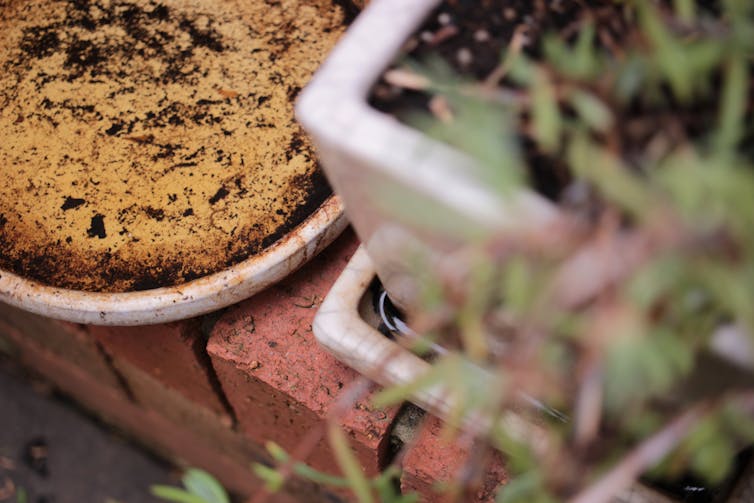
We can learn more about mosquitoes, and their spread across the country, with the help of volunteer “citizen scientists”. Individuals or groups can participate in projects such as Zika Mozzie Seeker or Mozzie Monitors. Mozzie Monitors has expanded in recent years to become the only national program, primarily focused around the annual Mozzie Month.
Citizen scientists can also upload photographs of mosquitoes to online platforms such as iNaturalist, which provides opportunities to observe the insects in nature. An analysis of more than 2,000 mosquito observations uploaded to iNaturalist revealed an astonishing 57 species observed across Australia.
And one of the most remarkable observations uploaded to iNaturalist in recent years has been a mysterious and distinctive mosquito, Aedes shehzadae.
A Discovery 90 Years In The Making
Aedes shehzadae was first captured in Australia by photographer John Lenagan in 2021, while on the lookout for moths in the Kutini-Payamu National Park (Iron Range) in Queensland’s Cape York.
The photo kicked off a cascade of investigations into mosquito collections held in research institutes and museums across Australia. They even stretched as far as the Natural History Museum in London.
We and our colleagues have detailed the circumstances around this unique discovery in this month’s edition of the Journal of Vector Ecology.
Lenagan’s photo wasn’t just the first time Aedes shehzadae was observed in Australia – it was also only the second time this mosquito had ever been formally recorded. The discovery may have gone unnoticed, had the photograph not been uploaded to iNaturalist and sparked interest.
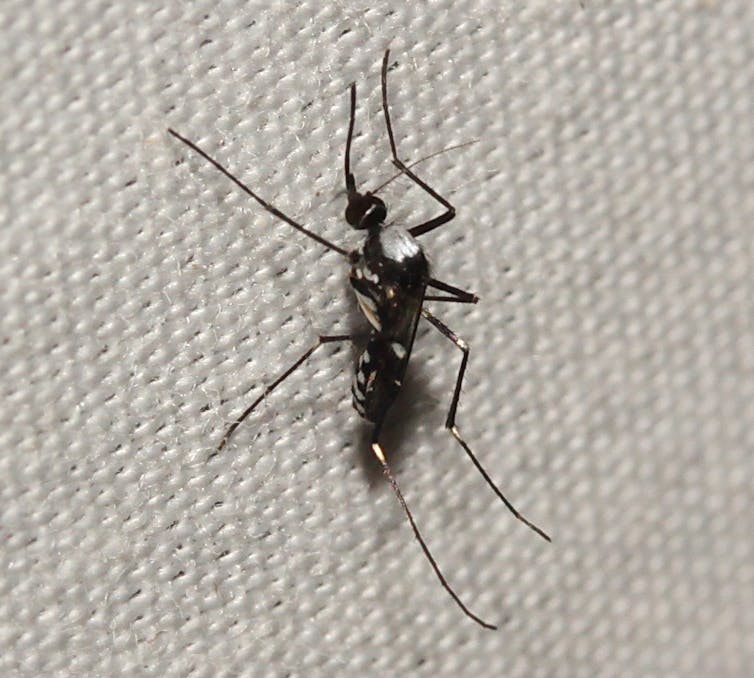
The only other specimen of this mosquito was collected in Papua New Guinea in 1934, almost 90 years ago. It was collected by a remarkable unpaid entomologist named Lucy Evelyn Cheesman, and stored in the Natural History Museum, until being formally described in 1972 by the Malaria Institute of Pakistan entomologist M. Qutubiddin (first name unconfirmed). He named the mosquito after his daughter.
Cheesman was a tenacious naturalist who collected around 70,000 specimens of insects, plants, and other animals for the Natural History Museum – many during expeditions to the South West Pacific.
We don’t know much about Aedes shehzadae. We’re not even sure whether it’s a new arrival in Australia, or if it had simply not been observed before. In all likelihood it won’t pose a significant threat to our backyards.
But that can’t be said for other exotic and invasive mosquitoes knocking on our door. Mosquitoes such as Aedes albopictus, or the “tiger mosquito”, could be a game-changer for mosquito-borne disease in Australia.
Community Assistance
Much has been said about the potential for citizen science to help health authorities identify exotic and invasive mosquitoes. This has been the case in Europe. And these programs may well be instrumental in tracking newly arrived mosquitoes that have hitched a ride with travellers or freight to the backyards and bushland of Australia.
We’re used to female mosquitoes biting us for blood, but we’re less aware of the flowers they visit to help pollination. We also don’t know a lot about the animals that eat mosquitoes, so perhaps some photographs of them caught in spider webs would be useful too.
There’s no doubt participants in citizen science projects can contribute to our understanding of native and invasive species distribution in meaningful ways. If Aedes shehzadae is anything to go by, anyone with a camera and some curiosity can be the discoverer of a new species, or new mosquito arrival.![]()
Cameron Webb, Clinical Associate Professor and Principal Hospital Scientist, University of Sydney; Craig Williams, Professor and Dean of Programs (Pharmacy and Biomedical Sciences), University of South Australia; Larissa Braz Sousa, PhD candidate on citizen science and public health, University of South Australia, and Marlene Walter, Masters of Research Student, Walter and Eliza Hall Institute
This article is republished from The Conversation under a Creative Commons license. Read the original article.
3 key measures in the suite of new reforms to deal with Australia’s energy crisis
Tim Nelson, Griffith University and Joel Gilmore, Griffith UniversityWith electricity prices surging to previously unimaginable levels, state and federal energy ministers met yesterday to consider how to respond to Australia’s energy crisis.
The market is pricing electricity at over A$300 per megawatt hour, more than three times what it traded at the beginning of this year.
In yesterday’s meeting, ministers agreed on 11 actions for lowering gas bills and to ensure a crisis like this doesn’t happen again. Here we take a closer look at three key ones.
None will address prices immediately, so all consumers should look for the best deal on electricity through excellent comparison sites, such as the Energy Made Easy website.
Three Important Measures On The Table
Power bills are set to remain high for months to come. Wholesale electricity makes up one third of a typical household retail bill, and the Australian Energy Regulator recently approved household electricity price rises of up to 20%.
If wholesale prices stay at current levels, Australians will have to pay even more for their electricity during the second half of the year.
So what key measures have the ministers proposed to address this? First, the ministers will allow the market operator to purchase gas and hold it in reserve.
If done well, holding reserves to release in times of supply shortage could smooth out extreme prices. Holding reserves of gas won’t be costless, but the cost of that insurance may be worth it to taxpayers. It will be important to see the detail of how this will be implemented.
The second action is to develop a national plan for growth in renewables, hydrogen, and transmission.
Accelerating new renewables will be key to reducing our exposure to fuel prices. A new wind or solar project can provide energy for $50-80 per megawatt hour, compared to $300-500 per megawatt hour from fossil fuel plants today.
Having a clear plan is a good start, but ministers will need to work out how to deliver it. Expanding the national Renewable Energy Target would be a good first step.
This target, legislated by the Rudd government, currently requires roughly 20% of electricity to come from new renewable energy. This could be increased significantly.
Indeed, state targets in place now could be more efficiently delivered if they were amalgamated into a stronger national target. Ministers could also consider similar targets for green gas or hydrogen.
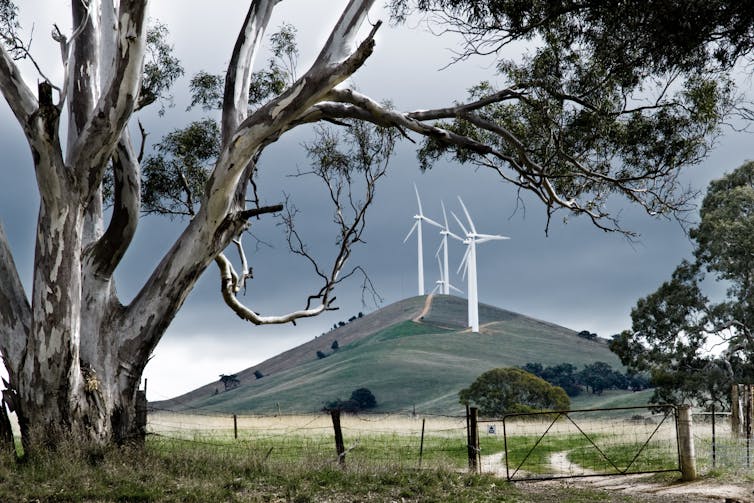
The third action is the most contested. Ministers have recommended implementing a capacity mechanism that would pay units to be available even if they’re not used, which may be similar to a capacity market. It’s not clear what this proposal will look like in detail or how this proposal would address the current crisis.
The communique doesn’t explicitly rule out coal. But there are reasons to be hopeful that what ministers have actually asked for is a capacity reserve, which will facilitate more renewables accompanied by modern technologies such as battery storage.
What Is A Capacity Market And Why Should It Exclude Coal?
A traditional capacity market is designed to pay all power stations (including existing coal) for being available, even if they’re not used.
This sort of capacity market won’t build the type of capacity we urgently need. Our grid requires generation that can turn on and off quickly, adjusting to consumers’ increasing appetite for installing their own solar panels.
A traditional capacity market that pays inflexible capacity such as coal will delay investment in new flexible capacity such as hydro, batteries, and hydrogen-ready gas peakers. Coal is considered inflexible because it takes hours to ramp up to full production, whereas “flexible” capacity can ramp to full production in seconds or minutes.
Locking in existing inflexible generation can reduce the reliability of the grid, a risk now possible in Western Australia.
Paying coal power stations to stay around longer also exposes Australia to fuel price spikes as we’ve seen recently, as well as continued shortfalls of capacity. This is because, as federal Energy Minister Chris Bowen pointed out, the current crisis is due to an unexpected shortage of coal, not gas.
Paying coal power stations twice – once for their capacity, and again for their energy – means it’s harder to build new, flexible capacity. A capacity market like this wouldn’t have avoided our current crisis or reduced consumers’ bills: the cost of coal and gas would still be high.
Coal is also increasingly unreliable. Currently up to 25% of coal is offline for maintenance, and unplanned outages are rising. Ironically, some coal generators are simultaneously asking to be paid to close their power stations.
Governments also need to consider the very significant financial assistance already paid to coal-fired generators when the Clean Energy Future package was introduced in 2012 and repealed only two years later.
None of the over $5 billion in assistance provided to coal-fired generators was paid back to taxpayers. Asking consumers to pay again for these power stations to “stay in the market” via a capacity market payment doesn’t seem fair or equitable.
So What Should Ministers Do?
Our current market already provides strong signals for investment in the right mix of capacity.
The market operator says there are around 1.2 gigawatts (GW) of new gas, 1.2 GW of battery, and 2.3 GW of hydro projects entering the market in coming years. Total new capacity entering the market is over 11 GW.
With electricity prices as high as they are, investors such as Snowy Hydro say it’s simply incorrect that the existing market doesn’t incentivise new storage such as batteries and pumped hydro.
However, a well designed “capacity reserve” would smooth out the market. New capacity, such as batteries and pumped hydro, could be brought into a “waiting room” and held until it’s needed.
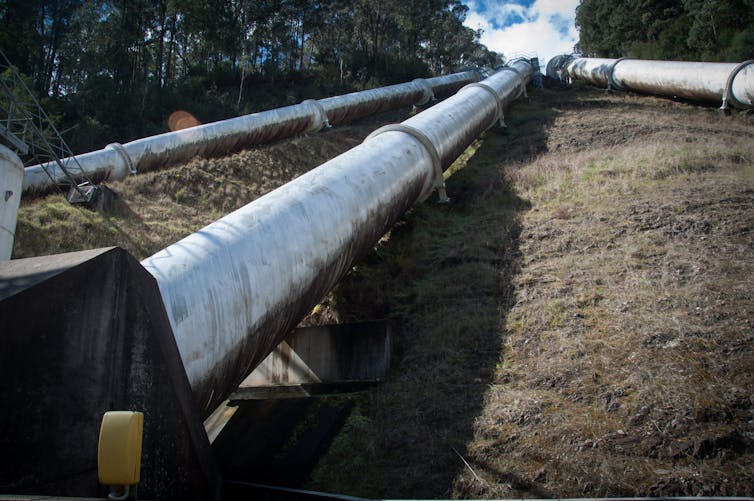
This could be implemented very quickly. The New South Wales roadmap provides a somewhat similar approach - underwriting new investments to ensure they’re built sooner rather than later.
Importantly, ministers make it clear in their communique that they’re only really wanting the mechanism to support new investment in fast-start zero emissions technologies. As such, it may be that the “capacity mechanism” they have in mind is actually more akin to the “capacity reserve” we have articulated here.
In the near-term, governments need to ensure all energy companies are doing their fair share to address costs and reliability.
The government has asked the ACCC to consider this, as we suggested last week.
But for now, the best option to keep warm this winter without breaking the bank is to shop around for the best electricity deals.![]()
Tim Nelson, Associate Professor of Economics, Griffith University and Joel Gilmore, Associate Professor, Griffith University
This article is republished from The Conversation under a Creative Commons license. Read the original article.
How to make your lawn wildlife friendly all year round – tips from an ecologist
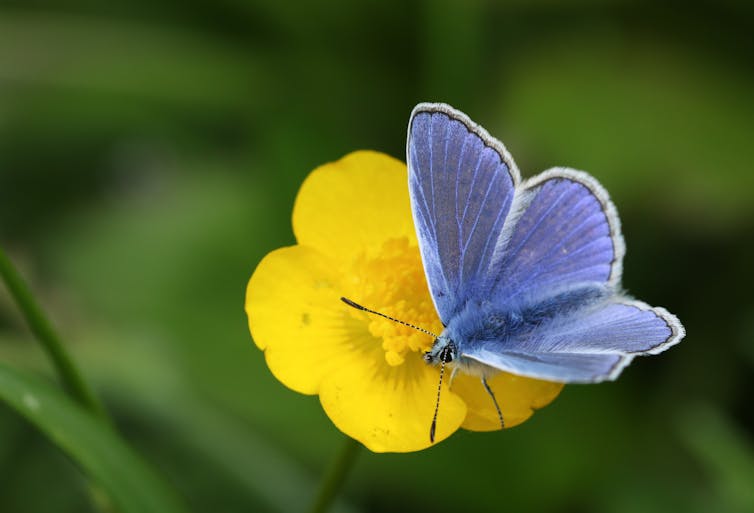
Alongside the worrying current fad for plastic grass, a growing number of people are choosing to let their lawns grow wild in order to encourage a more diverse range of plants and insects to live in them.
You may not be convinced of the beauty of a wild and unruly garden, but there is a sweet spot to be found between a rewilded jungle and a sterile green desert which not only looks good but provides a haven for wildlife. This is especially important in the UK, where 97% of semi-natural grassland has been destroyed over the last 80 years.
I’m an ecologist specialised in the study of this kind of habitat, and I want to help you get the most out of it. One simple compromise you can make is to put off when you first get the lawn mower out each year. A campaign by conservation charity Plantlife called #NoMowMay asks people with lawns to hold off the first cut until June, which allows grasses and herbs time to flower and set seed.
But if you want to maintain a wildlife-friendly lawn throughout the year, without letting your garden become completely overgrown, here’s some advice for what else you can do.
To find a happy medium, some mowing may be necessary. This halts the ecological processes which would otherwise transform a grass lawn into a woodland over time. By varying the height at which you mow different areas of your lawn and how often you do it (simulating the effect of different herbivores grazing in the wild), you can create a mix of conditions which benefit a variety of species.
Areas cut short will favour daisies, which flower in profusion and offer a nectar buffet to bees and butterflies. Unkempt areas left uncut for a year suit a wider variety of flowers, tempting a diverse cast of bugs and other creatures into your garden.
In experiments on his own garden in Kent, Charles Darwin recorded that refraining from mowing turf for too long resulted in fewer species overall, because:
the more vigorous plants gradually kill the less vigorous … thus out of 20 species growing on a little plot of turf (three feet by four) nine species perished from the other species being allowed to grow up freely.
Another key thing to think about is the level of nutrients the lawn receives. Even if you have never succumbed to the lawn feed products heavily promoted in most garden centres, your lawn will get a sufficient dose of fertiliser from reactive nitrogen carried on the wind.
The purpose of mowing in a natural grassland should be to mimic grazing by animals. And to do that, you have to remove the clippings otherwise the nutrients they carry will soak back into the soil.
Fungi and bacteria decompose dead plant material and return those nutrients to plants in a lawn through networks of mycorrhizal fungi in the soil. Regular mows which dump the cuttings and overload the soil with nutrients drive a stick through the spokes of this cycle by devaluing the currency of the nitrogen and phosphorus fungi deliver. Clumps of cut grass can also smother small seedlings.
At unnaturally high soil nutrient levels (common in lawns mown and topped with the clippings regularly), the vegetation is dominated by a small number of fast-growing, weedy species. As Darwin found, this prevents a rich community of wildflowers from taking shape. Soil with low nutrient levels favours not only more species, but also healthy soil food webs.
At the Rothamsted Park Grass experiment in Hertfordshire, scientists have studied the effects of annual haycutting since 1860, making it the oldest field experiment in the world. When fertiliser was evenly applied to some plots, it reduced the number of plant species from 40 to fewer than five.
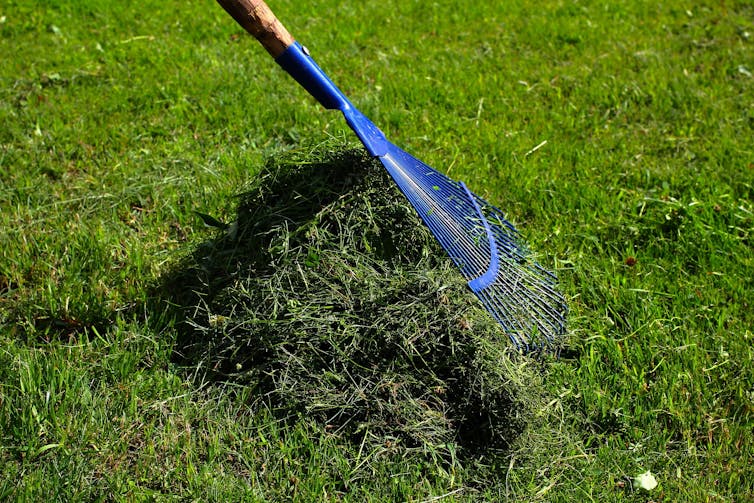
Autumn Fruiting
You also want to consider the time of year. Mow sparingly and leave grass long in summer to create diverse plant and insect communities in the warmest months. A lawn left uncut until late July, as in a traditional hay meadow, will favour the greatest variety of flowers. But cut it short in autumn to foster conditions for mushrooms fruiting as the year winds down.
Soil organisms and their hidden lives are badly neglected in nature conservation. Among the most overlooked are grassland macrofungi, so named because they are large enough to be visible to the naked eye. My favourites are the brightly coloured waxcaps. These film stars of the fungal world are restricted to undisturbed grasslands where soil nutrient concentrations are low.
The British Isles is a global hotspot for these fungi, but they are threatened by habitat loss. 11 species found in the UK were assessed by international experts as vulnerable – the same extinction risk faced by the panda and snow leopard.
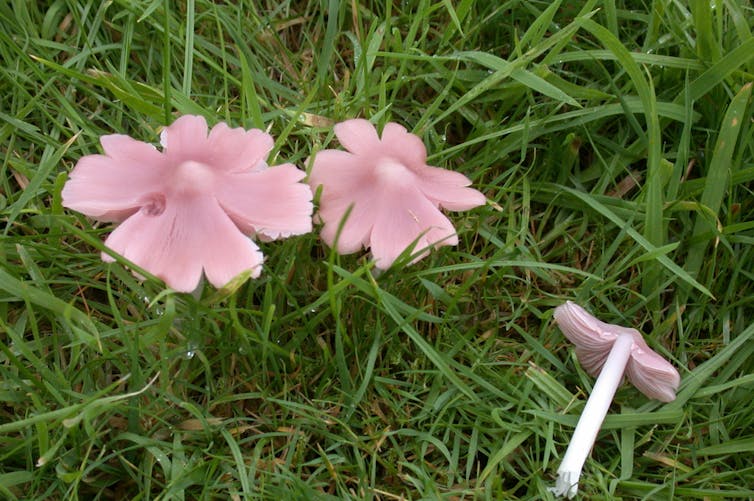
A study by my research group showed that waxcaps need the turf to be short (8cm tall at most) in the autumn, but that their most prolific fruiting occurred when the grass was left uncut until mid-July. Waxcaps grow slowly and are long-lived, but with late cuts and the removal of clippings to lower soil nutrient levels, it is likely that the first waxcaps will return within a decade.
To sum up, delay mowing until midsummer, keep your lawn free of clippings and leave patches more unkempt for longer to please butterflies and bees. But give it regular trims from August onwards to encourage globally rare mushrooms. You’ll then see that grasslands are diverse and dynamic habitats just waiting to be unleashed.![]()
Gareth Griffith, Professor of Fungal Ecology, Aberystwyth University
This article is republished from The Conversation under a Creative Commons license. Read the original article.
Making room for wildlife: 4 essential reads
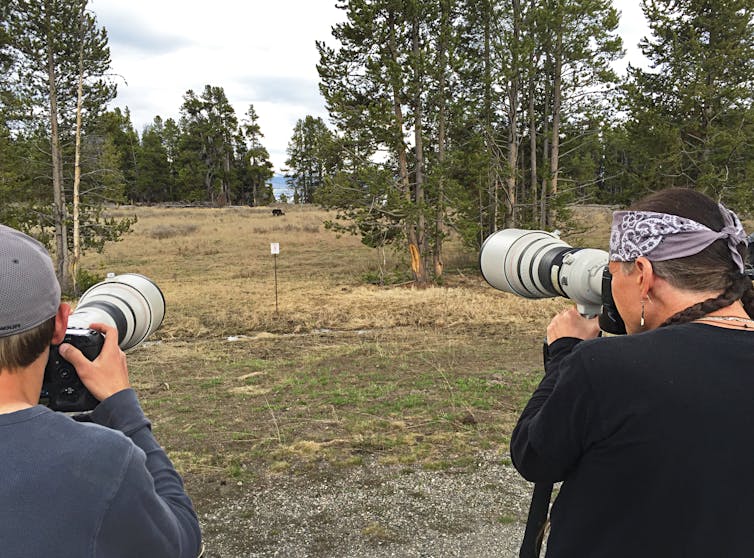
Millions of Americans enjoy observing and photographing wildlife near their homes or on trips. But when people get too close to wild animals, they risk serious injury or even death. It happens regularly, despite the threat of jail time and thousands of dollars in fines.
These four articles from The Conversation’s archive offer insights into how wild animals view humans and how our presence affects nearby animals and birds – plus a scientist’s perspective on what’s wrong with wildlife selfies.
1. They’re Just Not That Into You
In some parts of North America, wild animals that once were hunted to near-extinction have rebounded in recent decades. Wild turkeys, white-tailed deer, beavers and black bears are examples of wild species that have returned to large swaths of their pre-settlement ranges. As human development expands, people and animals are finding themselves in close quarters.
How do the animals react? Conservation researcher Kathy Zeller and her colleagues radio-collared black bears in central and western Massachusetts and found that the bears avoided populated areas, except when their natural food sources were less abundant in spring and fall. During those lean seasons, the bears would visit food sources in developed areas, such as bird feeders and garbage cans – but they foraged at night, contrary to their usual habits, to avoid contact with humans.
“Wild animals are increasing their nocturnal activity in response to development and other human activities, such as hiking, biking and farming,” Zeller reports. “And people who are scared of bears may be comforted to know that most of the time, black bears are just as scared of them.”

2. Wild Animals Turn Up In Unexpected Places
When a recovering species shows up on its old turf or in its former waters, humans aren’t always happy to make room for it. Ecologist Veronica Frans studied sea lions in New Zealand, a formerly endangered species that moves inland from the coast to breed, often showing up on local roads or in backyards.
Frans and her colleagues created a database that they used to find and map potential breeding grounds for sea lions all over the New Zealand mainland. They also identified potential challenges for the animals, such as roads and fences that could block their inland movement.
“When wild species enter new areas, they inevitably will have to adapt, and often will have new kinds of interactions with humans,” Frans writes. “I believe that when communities understand the changes and are involved in planning for them, they can prepare for the unexpected, with coexistence in mind.”

3. Your Presence Has A Big Impact
How close to wildlife is too close? Guidelines vary, but as a starting point, the U.S. National Park Service recommends staying at least 25 yards (23 meters) away from wild animals, and 100 yards (91 meters) from predators such as bears or wolves.
In a review of hundreds of studies, conservation scholars Jeremy Dertien, Courtney Larson and Sarah Reed found that human presence may affect many wild species’ behavior at much longer distances.
“Animals may flee from nearby people, decrease the time they feed and abandon nests or dens,” they report. “Other effects are harder to see, but can have serious consequences for animals’ health and survival. Wild animals that detect humans can experience physiological changes, such as increased heart rates and elevated levels of stress hormones.”
The scholars’ review found that the distance at which human presence starts to affect wildlife varies by species, although large animals generally need more distance. Small mammals and birds may change their behavior when people come within 300 feet (91 meters), while large mammals like elk and moose can be affected by humans up to 3,300 feet (1,006 meters) away – more than half a mile.
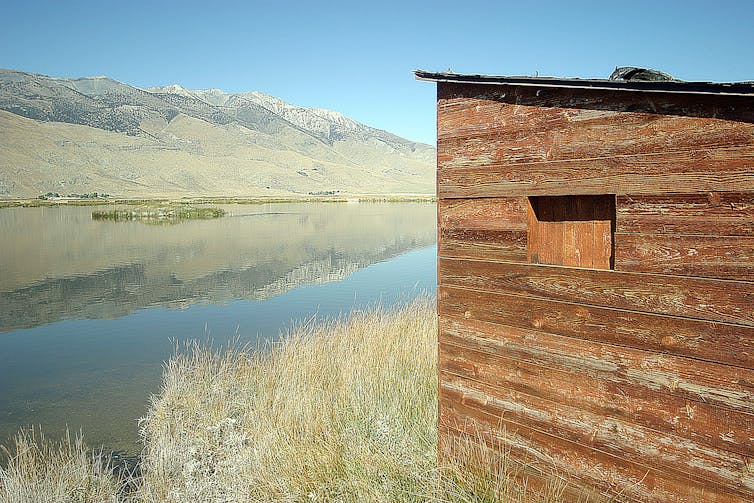
4. Don’t Take Wildlife Selfies, Even If You’re A Scientist
There are stories from around the world of people dying in the act of taking selfies. Some involve wildlife, such as a traveler in India who was mauled by an injured bear in 2018 when he stopped to photograph himself with the animal.
Tourists are often the culprits, but they’re not alone. As ocean scientist Christine Ward-Paige explains, scientists who have special permission to handle wild animals as part of their field research sometimes use this opportunity to take personal photos with their subjects.
“I have witnessed the making of many researcher-animal selfies, including photos with restrained animals during scientific study,” Ward-Paige recounts. “In most cases, the animal was only held for an extra fraction of a second while vigilant researchers simply glanced up and smiled for the camera already pointing in their direction.”
“But some incidents have been more intrusive. In one instance, researchers had tied a large shark to a boat with ropes across its tail and gills so that they could measure, biopsy and tag it. Then they kept it restrained for an extra 10 minutes while the scientists took turns hugging it for photos.”
In Ward-Paige’s view, legitimizing wildlife selfies in this way encourages people who don’t have scientific training or understand animal behavior to think that taking them is OK. That undercuts warnings from agencies like the National Park Service and puts both people and animals in danger.
Instead, she urges fellow scientists to “work to show the vulnerability of our animal subjects more clearly” and help guide the public to observe wildlife safely and responsibly.![]()
Jennifer Weeks, Senior Environment + Energy Editor, The Conversation
This article is republished from The Conversation under a Creative Commons license. Read the original article.
50 years of UN environmental diplomacy: What’s worked and the trends ahead
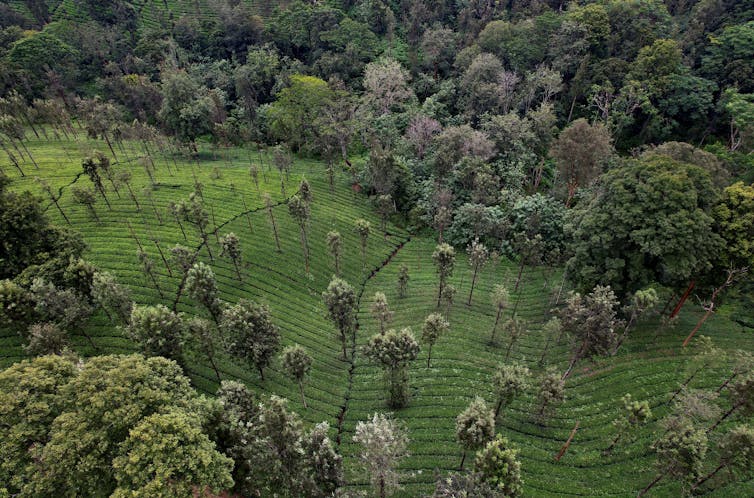
In 1972, acid rain was destroying trees. Birds were dying from DDT poisoning, and countries were contending with oil spills, contamination from nuclear weapons testing and the environmental harm of the Vietnam War. Air pollution was crossing borders and harming neighboring countries.
At Sweden’s urging, the United Nations brought together representatives from countries around the world to find solutions. That summit – the U.N. Conference on the Human Environment, held in Stockholm 50 years ago on June 5-16, 1972 – marked the first global effort to treat the environment as a worldwide policy issue and define the core principles for its management.
The Stockholm Conference was a turning point in how countries thought about the natural world and the resources that all nations share, like the air.
It led to the creation of the U.N. Environment Program to monitor the state of the environment and coordinate responses to the major environmental problems. It also raised questions that continue to challenge international negotiations to this day, such as who is responsible for cleaning up environmental damage, and how much poorer countries can be expected to do.

On the 50th anniversary of the Stockholm Conference, let’s look at where half a century of environmental diplomacy has led and the issues emerging for the coming decades.
The Stockholm Conference, 1972
From a diplomacy perspective, the Stockholm Conference was a major accomplishment.
It pushed the boundaries for a U.N. system that relied on the concept of state sovereignty and emphasized the importance of joint action for the common good. The conference gathered representatives from 113 countries, as well as from U.N. agencies, and created a tradition of including nonstate actors, such as environmental advocacy groups. It produced a declaration that included principles to guide global environmental management going forward.
The declaration explicitly acknowledged states’ “sovereign right to exploit their own resources pursuant to their own environmental policies, and the responsibility to ensure that activities within their jurisdiction or control do not cause damage to the environment of other States or of areas beyond the limits of national jurisdiction.” An action plan strengthened the U.N.’s role in protecting the environment and established UNEP as the global authority for the environment.
The Stockholm Conference also put global inequality in the spotlight. Indian Prime Minister Indira Gandhi questioned the urgency of prioritizing environmental protection when so many people lived in poverty. Other developing countries shared India’s concerns: Would this new environmental movement prevent impoverished people from using the environment and reinforce their deprivation? And would rich countries that contributed to the environmental damage provide funding and technical assistance?
The Earth Summit, 1992
Twenty years later, the 1992 U.N. Conference on Environment and Development – the Earth Summit – in Rio de Janeiro provided an answer. It embraced sustainable development – development that meets the needs of the present without compromising the ability of future generations to meet their own needs. That paved the way for political consensus in several ways.
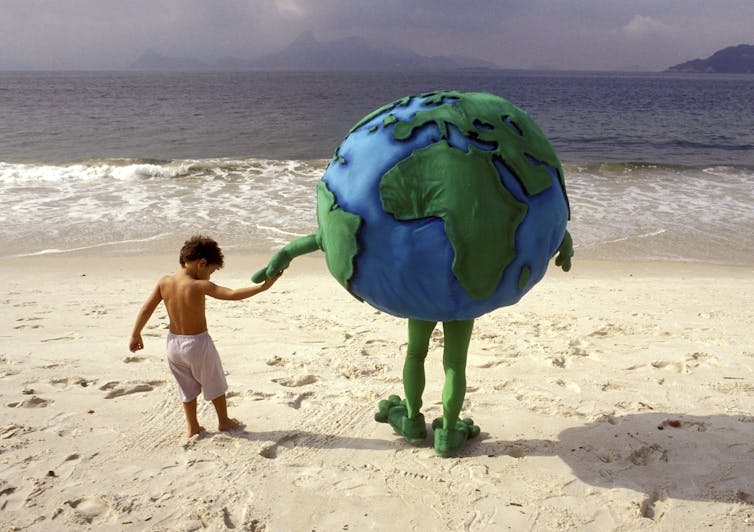
First, climate change was making it clear that human activities can permanently alter the planet, so the stakes were high for everyone. The imperative was to establish a new global partnership mobilizing states, key sectors of societies and people to protect and restore the health of the Earth’s ecosystems.
Second, economic development, environmental protection and social development were treated as interdependent.
Finally, while all countries were expected to pursue sustainable development, it was acknowledged that developed countries had more capacity to do so and that their societies placed greater pressures on the environment.

The Earth Summit produced the U.N. Framework Convention on Climate Change, laying the foundation for global climate negotiations that continue today; the Convention on Biological Diversity; nonbinding Forest Principles; and an overarching action plan to transition to sustainability.
Progress, But Major Challenges Ahead
The increasing awareness of environmental challenges over the past 50 years has led to the spread of national environmental agencies and the growth of global environmental law.
The world has pulled together to stop the destruction of the ozone layer, phase out leaded gasoline and curb the pollutants from burning fossil fuels that create acid rain. In 2015, U.N. member countries adopted 17 Sustainable Development Goals with measurable targets and signed the Paris climate agreement. Countries in 2022 committed to develop a treaty to reduce pollution from plastics. Climate change and sustainable resource use have also become higher priorities in foreign policymaking, international organizations and corporate boardrooms.
But while environmental diplomacy has demonstrated that progress is possible, the challenges the world still faces are immense.
Greenhouse gas concentrations are still increasing, and rising temperatures are fueling devastating wildfires, heat waves and other disasters. More than a million plant and animal species are threatened with extinction, potentially leading toward the worst loss of life on the planet since the time of dinosaurs. And 99% of the global population breathes air that exceeds World Health Organization guidelines for pollutants.
The Next 50 Years: Trends To Watch
As environmental diplomacy heads into its next 50 years, climate change, biodiversity and effects on human health are high on the agenda. Here are a few newer trends that also bear watching.
The idea of a circular economy is gaining interest. People produce, consume and throw away billions of tons of materials every year, while recycling or reusing only a small percentage. Ongoing efforts to create a more circular economy, which eliminates waste and keeps materials in use, can help mitigate climate change and restore natural systems.
Advocacy for rights of nature and animal rights is becoming more prominent in environmental diplomacy.
Outer space is another theme, as it increasingly becomes a domain of human exploration and settlement ambitions with the growth of private space travel. Space junk is accumulating and threatening Earth’s orbital space, and Mars exploration raises new questions about protecting space ecosystems.
The 50th anniversary of the Stockholm Conference is an important opportunity to think about development rights and responsibilities for the future while using environmental diplomacy today to preserve and regenerate the Earth.![]()
Mihaela Papa, Adjunct Assistant Professor in Sustainable Development and Global Governance, The Fletcher School, Tufts University
This article is republished from The Conversation under a Creative Commons license. Read the original article.
Pittwater Reserves: Histories + Notes + Pictorial Walks
A History Of The Campaign For Preservation Of The Warriewood Escarpment by David Palmer OAM and Angus Gordon OAM
America Bay Track Walk - photos by Joe Mills
Angophora Reserve - Angophora Reserve Flowers
Annie Wyatt Reserve - A Pictorial
Avalon's Village Green: Avalon Park Becomes Dunbar Park - Some History + Toongari Reserve and Catalpa Reserve
Bairne Walking Track Ku-Ring-Gai Chase NP by Kevin Murray
Bangalley Headland Bangalley Mid Winter
Banksias of Pittwater
Barrenjoey Boathouse In Governor Phillip Park Part Of Our Community For 75 Years: Photos From The Collection Of Russell Walton, Son Of Victor Walton
Barrenjoey Headland: Spring flowers
Barrenjoey Headland after fire
Bayview Baths
Bayview Wetlands
Beeby Park
Bilgola Beach
Botham Beach by Barbara Davies
Bungan Beach Bush Care
Careel Bay Saltmarsh plants
Careel Bay Birds
Careel Bay Clean Up day
Careel Bay Playing Fields History and Current
Careel Creek
Careel Creek - If you rebuild it they will come
Centre trail in Ku-ring-gai Chase National Park
Chiltern Track- Ingleside by Marita Macrae
Clareville Beach
Clareville/Long Beach Reserve + some History
Coastal Stability Series: Cabbage Tree Bay To Barrenjoey To Observation Point by John Illingsworth, Pittwater Pathways, and Dr. Peter Mitchell OAM
Cowan Track by Kevin Murray
Curl Curl To Freshwater Walk: October 2021 by Kevin Murray and Joe Mills
Currawong and Palm Beach Views - Winter 2018
Currawong-Mackerel-The Basin A Stroll In Early November 2021 - photos by Selena Griffith
Currawong State Park Currawong Beach + Currawong Creek
Deep Creek To Warriewood Walk photos by Joe Mills
Drone Gives A New View On Coastal Stability; Bungan: Bungan Headland To Newport Beach + Bilgola: North Newport Beach To Avalon + Bangalley: Avalon Headland To Palm Beach
Duck Holes: McCarrs Creek by Joe Mills
Dunbar Park - Some History + Toongari Reserve and Catalpa Reserve
Dundundra Falls Reserve: August 2020 photos by Selena Griffith - Listed in 1935
Elsie Track, Scotland Island
Elvina Track in Late Winter 2019 by Penny Gleen
Elvina Bay Walking Track: Spring 2020 photos by Joe Mills
Elvina Bay-Lovett Bay Loop Spring 2020 by Kevin Murray and Joe Mills
Fern Creek - Ingleside Escarpment To Warriewood Walk + Some History photos by Joe Mills
Iluka Park, Woorak Park, Pittwater Park, Sand Point Reserve, Snapperman Beach Reserve - Palm Beach: Some History
Ingleside
Ingleside Wildflowers August 2013
Irrawong - Ingleside Escarpment Trail Walk Spring 2020 photos by Joe Mills
Irrawong - Mullet Creek Restoration
Katandra Bushland Sanctuary - Ingleside
Lucinda Park, Palm Beach: Some History + 2022 Pictures
McCarrs Creek
McCarr's Creek to Church Point to Bayview Waterfront Path
McKay Reserve
Mona Vale Beach - A Stroll Along, Spring 2021 by Kevin Murray
Mona Vale Headland, Basin and Beach Restoration
Mount Murray Anderson Walking Track by Kevin Murray and Joe Mills
Mullet Creek
Narrabeen Creek
Narrabeen Lagoon Catchment: Past Notes Present Photos by Margaret Woods
Narrabeen Lagoon State Park
Narrabeen Lagoon State Park Expansion
Narrabeen Rockshelf Aquatic Reserve
Nerang Track, Terrey Hills by Bea Pierce
Newport Bushlink - the Crown of the Hill Linked Reserves
Newport Community Garden - Woolcott Reserve
Newport to Bilgola Bushlink 'From The Crown To The Sea' Paths: Founded In 1956 - A Tip and Quarry Becomes Green Space For People and Wildlife
Pittwater spring: waterbirds return to Wetlands
Pittwater's Lone Rangers - 120 Years of Ku-Ring-Gai Chase and the Men of Flowers Inspired by Eccleston Du Faur
Pittwater's Parallel Estuary - The Cowan 'Creek
Resolute Track at West Head by Kevin Murray
Resolute Track Stroll by Joe Mills
Riddle Reserve, Bayview
Salvation Loop Trail, Ku-Ring-Gai Chase National Park- Spring 2020 - by Selena Griffith
Stapleton Reserve
Stapleton Park Reserve In Spring 2020: An Urban Ark Of Plants Found Nowhere Else
The Chiltern Track
The Resolute Beach Loop Track At West Head In Ku-Ring-Gai Chase National Park by Kevin Murray
Towlers Bay Walking Track by Joe Mills
Trafalgar Square, Newport: A 'Commons' Park Dedicated By Private Landholders - The Green Heart Of This Community
Tranquil Turimetta Beach, April 2022 by Joe Mills
Turimetta Beach Reserve by Joe Mills, Bea Pierce and Lesley
Turimetta Beach Reserve: Old & New Images (by Kevin Murray) + Some History
Turimetta Headland
Warriewood Wetlands and Irrawong Reserve
Whale Beach Ocean Reserve: 'The Strand' - Some History On Another Great Protected Pittwater Reserve
Wilshire Park Palm Beach: Some History + Photos From May 2022
Winji Jimmi - Water Maze

New Shorebirds WingThing For Youngsters Available To Download
A Shorebirds WingThing educational brochure for kids (A5) helps children learn about shorebirds, their life and journey. The 2021 revised brochure version was published in February 2021 and is available now. You can download a file copy here.
If you would like a free print copy of this brochure, please send a self-addressed envelope with A$1.10 postage (or larger if you would like it unfolded) affixed to: BirdLife Australia, Shorebird WingThing Request, 2-05Shorebird WingThing/60 Leicester St, Carlton VIC 3053.

 Shorebird Identification Booklet
Shorebird Identification Booklet
The Migratory Shorebird Program has just released the third edition of its hugely popular Shorebird Identification Booklet. The team has thoroughly revised and updated this pocket-sized companion for all shorebird counters and interested birders, with lots of useful information on our most common shorebirds, key identification features, sighting distribution maps and short articles on some of BirdLife’s shorebird activities.
The booklet can be downloaded here in PDF file format: http://www.birdlife.org.au/documents/Shorebird_ID_Booklet_V3.pdf
Paper copies can be ordered as well, see http://www.birdlife.org.au/projects/shorebirds-2020/counter-resources for details.
Download BirdLife Australia's children’s education kit to help them learn more about our wading birdlife
Shorebirds are a group of wading birds that can be found feeding on swamps, tidal mudflats, estuaries, beaches and open country. For many people, shorebirds are just those brown birds feeding a long way out on the mud but they are actually a remarkably diverse collection of birds including stilts, sandpipers, snipe, curlews, godwits, plovers and oystercatchers. Each species is superbly adapted to suit its preferred habitat. The Red-necked Stint is as small as a sparrow, with relatively short legs and bill that it pecks food from the surface of the mud with, whereas the Eastern Curlew is over two feet long with a exceptionally long legs and a massively curved beak that it thrusts deep down into the mud to pull out crabs, worms and other creatures hidden below the surface.
Some shorebirds are fairly drab in plumage, especially when they are visiting Australia in their non-breeding season, but when they migrate to their Arctic nesting grounds, they develop a vibrant flush of bright colours to attract a mate. We have 37 types of shorebirds that annually migrate to Australia on some of the most lengthy and arduous journeys in the animal kingdom, but there are also 18 shorebirds that call Australia home all year round.
What all our shorebirds have in common—be they large or small, seasoned traveller or homebody, brightly coloured or in muted tones—is that each species needs adequate safe areas where they can successfully feed and breed.
The National Shorebird Monitoring Program is managed and supported by BirdLife Australia.
This project is supported by Glenelg Hopkins Catchment Management Authority and Hunter Local Land Services through funding from the Australian Government’s National Landcare Program. Funding from Helen Macpherson Smith Trust and Port Phillip Bay Fund is acknowledged.
The National Shorebird Monitoring Program is made possible with the help of over 1,600 volunteers working in coastal and inland habitats all over Australia.
The National Shorebird Monitoring program (started as the Shorebirds 2020 project initiated to re-invigorate monitoring around Australia) is raising awareness of how incredible shorebirds are, and actively engaging the community to participate in gathering information needed to conserve shorebirds.
In the short term, the destruction of tidal ecosystems will need to be stopped, and our program is designed to strengthen the case for protecting these important habitats.
In the long term, there will be a need to mitigate against the likely effects of climate change on a species that travels across the entire range of latitudes where impacts are likely.
The identification and protection of critical areas for shorebirds will need to continue in order to guard against the potential threats associated with habitats in close proximity to nearly half the human population.
Here in Australia, the place where these birds grow up and spend most of their lives, continued monitoring is necessary to inform the best management practice to maintain shorebird populations.
BirdLife Australia believe that we can help secure a brighter future for these remarkable birds by educating stakeholders, gathering information on how and why shorebird populations are changing, and working to grow the community of people who care about shorebirds.
To find out more visit: http://www.birdlife.org.au/projects/shorebirds-2020/shorebirds-2020-program
Aussie Bread Tags Collection Points

Public Health Alert: High-Dose MDMA (Ecstasy) Circulating In NSW

Free Training To Deliver In-Demand Winter Skills
 More than 1,500 fee-free training places are up for grabs as part of the NSW Government’s Winter Skills program, which aims to get people skilled for a bumper winter tourism and hospitality season.
More than 1,500 fee-free training places are up for grabs as part of the NSW Government’s Winter Skills program, which aims to get people skilled for a bumper winter tourism and hospitality season.HSC Artists In Virtual Exhibition
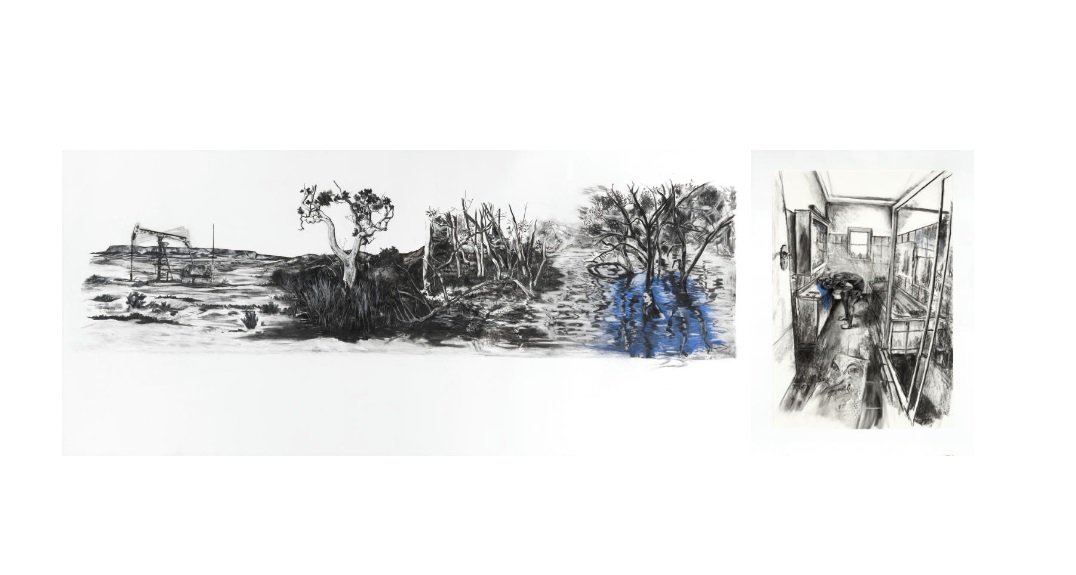
Students To Tour Hiroshima And Pearl Harbor
Dorothea Mackellar Poetry Awards 2022: Entries Close June 30th

There's also a special History page running this Issue for you - the Australian poet Dorothea Mackellar, after whom the Electorate of Mackellar is named, had a house here in Pittwater at Lovett Bay.
“Our poets are encouraged to take inspiration from wherever they may find it, however if they are looking for some direction, competition participants are invited to use this year’s optional theme to inspire their entries.”
In 2022, the Dorothea Mackellar Memorial Society has chosen the theme “In My Opinion.”
As always, it is an optional theme. The Society encourages students to write about topics and experiences that spark their poetic genius (in whatever form they choose.)
HOW TO ENTER
PLEASE SEE HERE FOR A DETAILED PDF ON ENTRY INSTRUCTIONS FOR TEACHERS AND PARENTS.
ONLINE SUBMISSION
Primary school and secondary school entries can be submitted anytime during the competition period. Visit: https://dorothea.com.au/how-to-enter/
Word Of The Week: Serendipity
- The Post-It Note, which emerged after 3M scientist Spencer Silver produced a weak adhesive, and a colleague used it to keep bookmarks in place on a church hymnal.
- Silly Putty, which came from a failed attempt at synthetic rubber.
- The microwave oven. Raytheon scientist Percy Spencer first patented the idea behind it after noticing that emissions from radar equipment had melted the candy in his pocket.
- The Velcro hook-and-loop fastener. George de Mestral came up with the idea after a bird hunting trip when he viewed cockleburs stuck to his pants under a microscope and saw that each burr was covered with tiny hooks.
- The Popsicle, whose origins go back to San Francisco where Frank Epperson, age 11, accidentally left a mix of water and soda powder outside to freeze overnight.
- The antibiotic penicillin, which was discovered by Sir Alexander Fleming after returning from a vacation to find that a Petri dish containing staphylococcus culture had been infected by a Penicillium mold, and no bacteria grew near it.
Spin Doctors - Two Princes (1991)
John Hiatt - Have A Little Faith In Me (1987)
Indigo Girls - Closer To Fine (1989)
Joni Mitchell Big Yellow Taxi + Both Sides Now (1966 - These Live BBC Editions From 1969)
Anything & Everything gives us a glance into the lives teenagers are constructing online

Review: Anything & Everything, Platform Arts, infinity ensemble for Rising.
Anything & Everything reminds me of a rite of passage we have all sailed through, in one way or another. That question we all ask: who am I?
The passage is quite different for the new generation. Anything & Everything, directed by Jackson Castiglione, is about the young people who navigate this question with social media embedded in their compass.
We are in a TV studio. Six amazing teenagers converse about how they look, who they are and what is expected of them while collaborating to film short videos of each other, constructing how they want to be seen by the world.
We see them throughout the hour simultaneously on stage and on a variety of screens. A production within a production. A play about identity construction, in which people learn to navigate the different layers of themselves.
You could ask how “real” these layers are.
Are the images on screen less real than what we see in real life (IRL)?
Does this reflection mean anything at all?
Or has it come to mean everything?

What If You Could See All Angles Of Yourself?
A metaphor repeatedly invoked throughout the show is the idea of having butterfly eyes – compound eyes of up to 17,000 lenses which, our cast says, could let them see everything all at once.
The performers ask each other what they would see if they could see themselves from all angles. One thinks about what it would mean to see herself from the back, rather than the front. Another speaks about how she could spy on everyone, knowing what they love and hate about themselves.
There is also an analogy between butterfly eyes and the digital technology we have today. One the one hand, technology gives us unprecedented power to see ourselves and others from many different perspectives, all at the same time. On the other, this power can be too much to handle – as one performer describes, it can be intimidating.

At the heart of Anything & Everything is the question of how young people find themselves in multiple realities, rather than a single overarching personality.
None of our teen protagonists say they would like to label themselves with a coherent and unified identity. As Richard Jenkins, a professor of sociology, writes in his book about social identity, identity is not a thing, but a process.
It is fascinating to listen to these young people’s stories about how they navigate this process.
For older audiences, it might be a little surreal to realise how much social media channels such as TikTok and Instagram are now an essential part of these journeys.
What Is Real?
Images on screen have often been perceived as a less authentic version of reality, with the potential for deception.
As screens become more ubiquitous, this perception is changing.
Throughout the show, the performers repeatedly discuss how they look and what they see, especially under the influence of digital technology. It is all about seeing. Visual culture has come to dominate our lives. The screens are all around us.
For these teenagers, the online/offline binary or hierarchy seems to no longer matter. They think of their images on screen as real as their physical bodies.
The screens are not lying to them.
The kids learn to negotiate when certain elements among these multiple realities appear contradictory.

Am I Different?
There are touching moments when the performers discuss how gender, racism and living with disabilities influence their sense of identity. Kids are not often expected to have a voice on these issues, and it might surprise some in the audience how much these young people can take in and reflect on.
Each story in the show speaks to the struggles we adults have been dealing with – often without talking to kids. We tend to think children should be protected from such problems.
It turns out they have their own stories: moving stories about fear, frustration, hope and courage. As the beautiful background music of the show says, “you don’t need to be afraid.” The kids are trying to be strong too, even without adults’ recognition.
Anything & Everything ends with an inspiring reflection from one of the ensemble members about identity as performance. Interestingly, they say the idea came to them from an infographic on Instagram.

Identifying as non-binary, they reveal how realising that everyone’s gender identity is a performance gave them the courage to choose their gender – rather than fit into a box.
But the show is about more than individual agency. It asks if social discourses can be changed, such as the way we raise our girls with certain unconscious assumptions and expectations.
In that sense, Anything & Everything leaves us rethinking about young people’s identities, as well as the technological and social forces that influence the process of discovering who we are.
Anything & Everything is at ACMI until June 12.![]()
Thuy Tran, PhD Candidate, The University of Melbourne
This article is republished from The Conversation under a Creative Commons license. Read the original article.
Young Australian voters helped swing the election – and could do it again next time

The 2022 federal election saw a significant move away from the two major parties, with a host of independent and Greens candidates taking seats from Labor and the Coalition.
Amid predictions about a “youthquake” before May 21, what role did young voters play in this radical electoral shift? And how important could they be by the next election?
The Trend Was There
Even before the election, researchers had noted major differences between younger and older voters.
Long-term voting patterns showed Labor was more likely to attract young voters. But surveys also showed how both the major parties have been losing their youth vote to the Greens.

As the Australian Election Study found after the 2019 election, 42% of voters under 24 did not vote for Labor or the Coalition. Of those aged 25 to 34, 35% did not vote for Labor or the Coalition. This compares to just 12% of those aged over 65.
We also know younger voters were more concerned about environmental issues and property prices than older voters. None of these were adequately addressed during the last term of parliament, which was marred by frightening bushfires, heat waves and floods, and saw inadequate action on climate change and rising intergenerational inequality.
Clear Wins On May 21
So it is not surprising that electorates with the highest rate of voters under 30 saw unprecedented support for Greens in 2022. An analysis of AEC enrolment data shows seats with four of the top five highest proportions of young voters (18-29 year-olds) went to the Greens. This includes:
- Melbourne with a youth vote of 26.9% (Greens retain)
- Brisbane with a youth vote of 25.7% (Greens gain from the Liberal Party)
- Griffith with a youth vote of 24.7% (Greens gain from Labor)
- Ryan with a youth vote of 22.5% (Greens gain from the Liberal Party)
Also in the top five was the seat of Canberra with a youth vote of 23.1%. This was an easy Labor retain. However, here the Greens primary vote was almost 25% and the Greens, not the Liberal Party, were used for the two-party-preferred calculations.
There were also a relatively high rate of youth enrolment in key seats likes Kooyong (20.8%, independent gain from Liberals) and Fowler (19.5%, independent gain from Labor). There were other Liberal-turned-teal seats with a relatively lower proportion of youth voters (Curtin 17.7%, Wentworth 17.1%, Goldstein 16.3%, North Sydney 16.3% and Mackellar 15.6%). But it is important to acknowledge the women’s vote may have been a stronger driving force in these seats.
So, what does this mean electorally going forward?
The Big Debate About Young Voters
Leading up to the election there was a lot of speculation about young people’s voting behaviour. As other countries recorded a worrying decline in youth electoral participation, I argued young Australians are different.
Still, there was concern the backdrop of COVID suffering, economic inequality, climate inaction and decaying trust in political leaders would culminate in youth political disengagement. Clearly, this did not happen.
Parties And Politicians Now Are On Notice
The election shows how the centre of gravity of Australian politics has shifted. The various swings away from the major parties revealed just how discerning voters can be. It also showed voters are likely to act based on policy concerns, rather than political allegiances.
The oldest millennial voters were 42 at this election, while first-time voters of 18 years of age included members of Generation Z. So, some of this can be attributed to generational replacement as the polls populate with more progressive, apartisan younger voters.

This trend is only going to increase. A basic analysis of current enrolments, plus expected future enrolments suggests that by the next election, millennial voters and younger (those under 45) will make up about 44% of the voting population. This is similar to this election – where they made up 43% – but significantly up from ten or 20 years ago. That means what we consider to be younger generations are replacing their older counterparts - and their more conservative values - over time in the electorate.
The 2022 election also sends a crucial political signal to the younger voters. The results show them the power of their actions to affect change in Australia’s democracy – and that the vote, in an aggregate sense, is an effective tool to do so. The 2022 federal election was one to restore young people’s hope and faith in the Australian democratic system.
Major parties need to acknowledge that younger voters do not like what they are offering, especially in response to climate change. If Labor is hoping to woo them back in 2025, it is interesting that “Minister for Youth” is not a cabinet position.
In the lead-up to their electoral success, the Greens worked hard in Brisbane – courting voters with young, personable candidates who went door-to-door to speak to voters directly. But they need to keep working. The Greens and teal victories were a virtue of issue-based voters, who will be watching whether these new MPs make change in Canberra.
Young voters in Australia can no longer be ignored.![]()
Intifar Chowdhury, Associate lecturer, Australian National University
This article is republished from The Conversation under a Creative Commons license. Read the original article.
Need to renew your passport? The weird history of Australian passports explains how they got so expensive
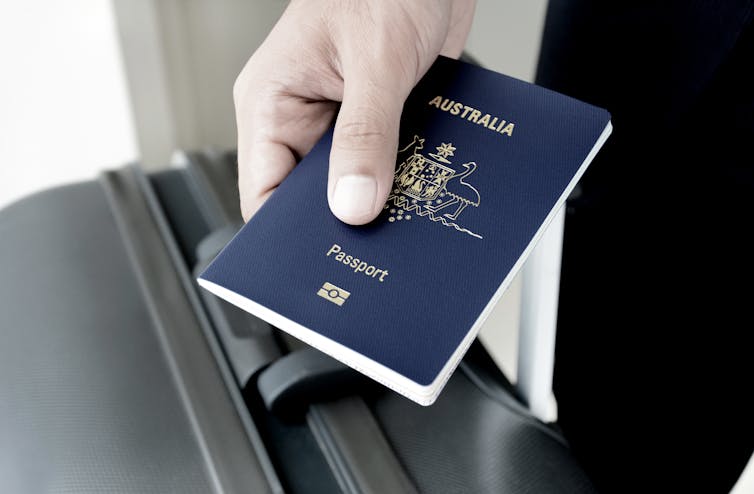
Now borders are open, Australians are applying for and renewing passports in droves. Wait times have doubled.
The cost of the Australian biometric passport and the rigour involved in obtaining one can be traced to Australia’s participation in an international passport system that evolved over the past century.
An Ancient Lineage
The passport has an ancient lineage and is mentioned in the Bible.
Deriving from the French words passer and port, it allows the bearer to transit a port or to enter or leave a territory. It is essentially a document asking a foreign ruler to let the bearer pass through his or her country unhindered.
But passports were generally not necessary to move across borders in the 19th century.
They were certainly not required to move within the British Empire. In Australia, the passport’s first appearance was as a document – known as a “ticket of leave” – allowing paroled convicts to move internally within colonies.

Wartime Changes
In the late 19th and early 20th centuries, the colonies (later the states) and the federal government issued passports to the relatively few Australians who travelled overseas and might need one to enter a non-British country.
The outbreak of the first world war made it crucial to monitor who was entering and leaving the country.
The British government soon made passports mandatory for people entering or leaving the British Isles. The Australian government followed suit, making passports mandatory and monopolising passport issuing under the War Precautions Act.
The Australian government, led by Billy Hughes, wanted to introduce conscription for overseas service. Making a passport compulsory for Australian travellers gave the government a tool to ensure men of age could not evade military service by heading overseas.

During the war, passport application interviews for Australian men became tantamount to an interrogation. One man certain he would be denied a passport was champion middleweight boxer Les Darcy. To evade conscription and travel to America to earn money for his family, he stowed away on a ship and entered the United States without a passport.
The passport system established in the first world war continued as a permanent system under the auspices of the League of Nations.
Australia gave its passport a legislative basis with the Passport Act 1920, which was revised in 1938 and again in 2005.
The Passport System After The Second World War
In the first half of the 20th century, passports were issued to British subjects or naturalised British subjects resident in Australia.
This “British” passport signified the bearer was a British subject who had available to him or her the diplomatic and consular network of the United Kingdom government.
After the second world war, the Chifley Labor government secured passage of the Nationality and Citizenship Act, which created the category of Australian citizen for the first time.
From 1948, passports attested to the bearer’s identity and that he or she was an Australian citizen (or British subject until the 1980s).
Australian citizens who requested a passport – by now a prerequisite for international travel – usually got one. Foreign countries would not admit you without one.
But there was no absolute right to an Australian passport. Australian law, as in most other countries, gave the government the right not to issue or to cancel passports in certain circumstances.

In the Cold War, many communists were denied passports. A celebrated instance was the communist war correspondent, Wilfred Burchett.
Burchett’s support for China and North Korea during the Korean War led some to accuse him of treason. The Australian government refused him a passport and he was forced to travel with a special class of travel document issued by the Cambodian and North Vietnamese governments (the laissez-passer).
The document was so large Burchett bound it in Moroccan leather. Despite not having a passport, the Australian government could not stop Burchett entering Australia. He eventually chartered a plane from Noumea, New Caledonia, to Brisbane and entered the country that way.
The Modern Passport System
The growth of international air travel saw Australian passport issues soar by the late 1980s. By 2019-20 the Australian government was issuing 1,745,340 passports – over 7,000 each business day.
With increasing travel came problems of identity. In the 1970s and 1980s, drug traffickers exploited the Australian passport system to get passports issued under aliases. One drug lord, Terrence John Clark, was arrested in 1978 holding passports under five different names.
In 1983, the Stewart Royal Commission into Drug Trafficking made sweeping recommendations for the passport system to curtail the drug trade.
The Fraser government did not accept Stewart’s recommendation for a national system based on fingerprinting to verify identity. But it accepted other recommendations.
From the 1980s onward, it was no longer acceptable for travel agents to procure passports for travellers. It became mandatory for applicants to attend an interview at post offices. Photocopied birth certificates and citizenship documents could not be used in an application.
The September 11 terrorist attacks in 2001 brought more significant change. The United States flagged its visa issuing would be dependent on foreign countries developing biometric means to identify people.
Australia was at the forefront of this change. Since 2005, the Australian government has stored a digitised photograph of an applicant’s face in a national database and on a computer chip embedded in the passport.
These added security measures make the Australian passport costly to produce; it is now among the most expensive in the world.![]()
David Lee, Associate Professor of History, UNSW Sydney
This article is republished from The Conversation under a Creative Commons license. Read the original article.
We’re told AI neural networks ‘learn’ the way humans do. A neuroscientist explains why that’s not the case

Recently developed artificial intelligence (AI) models are capable of many impressive feats, including recognising images and producing human-like language. But just because AI can perform human-like behaviours doesn’t mean it can think or understand like humans.
As a researcher studying how humans understand and reason about the world, I think it’s important to emphasise the way AI systems “think” and learn is fundamentally different to how humans do – and we have a long way to go before AI can truly think like us.
A Widespread Misconception
Developments in AI have produced systems that can perform very human-like behaviours. The language model GPT-3 can produce text that’s often indistinguishable from human speech. Another model, PaLM, can produce explanations for jokes it has never seen before.
Most recently, a general-purpose AI known as Gato has been developed which can perform hundreds of tasks, including captioning images, answering questions, playing Atari video games, and even controlling a robot arm to stack blocks. And DALL-E is a system which has been trained to produce modified images and artwork from a text description.
These breakthroughs have led to some bold claims about the capability of such AI, and what it can tell us about human intelligence.
For example Nando de Freitas, a researcher at Google’s AI company DeepMind, argues scaling up existing models will be enough to produce human-level artificial intelligence. Others have echoed this view.
In all the excitement, it’s easy to assume human-like behaviour means human-like understanding. But there are several key differences between how AI and humans think and learn.
Neural Nets Vs The Human Brain
Most recent AI is built from artificial neural networks, or “neural nets” for short. The term “neural” is used because these networks are inspired by the human brain, in which billions of cells called neurons form complex webs of connections with one another, processing information as they fire signals back and forth.
Neural nets are a highly simplified version of the biology. A real neuron is replaced with a simple node, and the strength of the connection between nodes is represented by a single number called a “weight”.
With enough connected nodes stacked into enough layers, neural nets can be trained to recognise patterns and even “generalise” to stimuli that are similar (but not identical) to what they’ve seen before. Simply, generalisation refers to an AI system’s ability to take what it has learnt from certain data and apply it to new data.
Being able to identify features, recognise patterns, and generalise from results lies at the heart of the success of neural nets – and mimics techniques humans use for such tasks. Yet there are important differences.
Neural nets are typically trained by “supervised learning”. So they’re presented with many examples of an input and the desired output, and then gradually the connection weights are adjusted until the network “learns” to produce the desired output.
To learn a language task, a neural net may be presented with a sentence one word at a time, and will slowly learns to predict the next word in the sequence.
This is very different from how humans typically learn. Most human learning is “unsupervised”, which means we’re not explicitly told what the “right” response is for a given stimulus. We have to work this out ourselves.
For instance, children aren’t given instructions on how to speak, but learn this through a complex process of exposure to adult speech, imitation, and feedback.

Another difference is the sheer scale of data used to train AI. The GPT-3 model was trained on 400 billion words, mostly taken from the internet. At a rate of 150 words per minute, it would take a human nearly 4,000 years to read this much text.
Such calculations show humans can’t possibly learn the same way AI does. We have to make more efficient use of smaller amounts of data.
Neural Nets Can Learn In Ways We Can’t
An even more fundamental difference concerns the way neural nets learn. In order to match up a stimulus with a desired response, neural nets use an algorithm called “backpropagation” to pass errors backward through the network, allowing the weights to be adjusted in just the right way.
However, it’s widely recognised by neuroscientists that backpropagation can’t be implemented in the brain, as it would require external signals that just don’t exist.
Some researchers have proposed variations of backpropagation could be used by the brain, but so far there is no evidence human brains can use such learning methods.
Instead, humans learn by making structured mental concepts, in which many different properties and associations are linked together. For instance, our concept of “banana” includes its shape, the colour yellow, knowledge of it being a fruit, how to hold it, and so forth.
As far as we know, AI systems do not form conceptual knowledge like this. They rely entirely on extracting complex statistical associations from their training data, and then applying these to similar contexts.
Efforts are underway to build AI that combines different types of input (such as images and text) – but it remains to be seen if this will be sufficient for these models to learn the same types of rich mental representations humans use to understand the world.
There’s still much we don’t know about how humans learn, understand and reason. However, what we do know indicates humans perform these tasks very differently to AI systems.
As such, many researchers believe we’ll need new approaches, and more fundamental insight into how the human brain works, before we can build machines that truly think and learn like humans.![]()
James Fodor, PhD Candidate in Cognitive Neuroscience, The University of Melbourne
This article is republished from The Conversation under a Creative Commons license. Read the original article.
Set in a 19th century Australian leper colony, Eleanor Limprecht’s The Coast depicts past cruelties, but has powerful things to say about the present
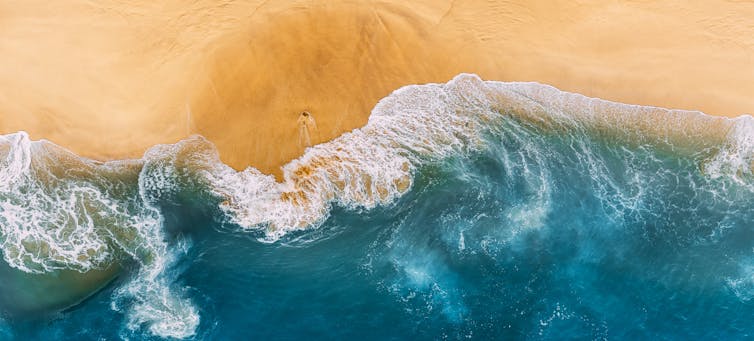
Eleanor Limprecht’s new historical novel The Coast recreates a lost world that was once damned to obscurity. Set in a formerly remote coastal area known as Little Bay, just outside of Sydney, her book imagines a series of characters forced into quarantine after being diagnosed with leprosy.
Review: The Coast – Eleanor Limprecht (Allen & Unwin).
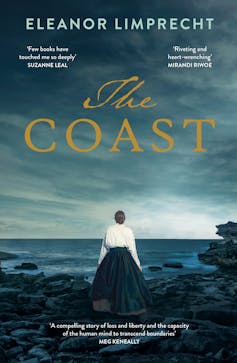
Established at the tail end of the 19th century, Sydney’s Little Bay “Coast Hospital” (known today as the Prince Henry Hospital Nursing and Medical Museum) hosted thousands of leprosy patients.
Yet this is a relatively unknown piece of Australian history. Perhaps the shame of locking up sick people and the cruelty of their seclusion (leprosy was never very contagious) needed to be suppressed?
Cleverly, Limprecht’s novel resists making any such judgements. Instead, it allows readers to gain an incremental knowledge of a “system”, its living conditions, and the various characters – patients, family members, nurses and doctors – who reside both within and beyond what is essentially a leper colony.
The style of the novel is polyvocal: each chapter begins with a character’s name, heralding their narrative point of view. This technique fosters a great deal of intimacy between readers and characters. We approach each chapter as one would an individual.
The writing is crisp, alternating between the first-person and third-person modes of address in its chronicle of intimate moments and uncharted worlds. It balances the expository dimension of prose with the lyricism of poetry:
What bound them together was too complex to unknit, too tangled to think the truth would smooth it.
Limprecht’s prose moves seamlessly from the lead protagonist Alice, the novel’s inaugurating first-person narrator, to other voices and perspectives, including that of Jack, a stolen generation youth, whose experience of loss and alienation is filtered through an omniscient narrator.
The mediation of Jack’s story through a third-person perspective emphasises his estrangement as a “half-caste” aboriginal boy who has been brutally removed from his home. Limprecht’s disturbing description of his relocation to a mission reveals a system designed to eradicate every vestige of his Indigeneity. The haunting scene of Jack washing away his encrusted “tracks of tears” suggests that no cleansing agent will ever heal the deep wound of his abduction.
Dialogues And Perspectives
There are many dialogues in this novel: between characters, within chapters, and across chapters. They take the form of conversations between different forms of isolation, revealing levels of confinement and incarceration. The overall effect is like that of a collage, in which there is a complex layering of experiences and perspectives.
This technique is evocative of Henry James, whose masterful late novels The Wings of the Dove (1902), The Ambassadors (1903) and The Golden Bowl (1904) convey information through myriad exchanges and internal musings.
Significant details are also divulged through conversation. For example, Alice’s leprosy, her blond hair, and her birth name “Hilda” are revealed through dialogue. In the case of Alice’s shifting appellation, James’s narrative obliquity is arguably taken a step further, as one ponders the fragility of identity when it is wedded to proper names.

The Coast’s shifting names and perspectives evoke a profound sense of loss. As Alice observes, there are “places we can never return because they only exist as memories”.
The lives of characters also coincide with specific years that occasionally headline chapters — 1926, 1905, 1910, 1892 and 1915, among others. These roving time periods signify dramatic and appalling moments in Australian history: the massacre of First Nations peoples, the dissolution of penal settlements, the unification of self-governing states at Federation, the forced removal of “mixed-race” Indigenous peoples that created the Stolen Generation, the White Australia Policy, and the first world war.
It is not coincidental that The Coast is organised around significant and shameful episodes in our history. The novel suggests that institutional maltreatment and racially driven government policies may not be all that historical. An epistolary newspaper clipping from the novel suggests this:
Scattered throughout the cities, town and villages, and remote out-back settlements, aliens may develop and spread the virus of the many strange Eastern diseases which they carry with them in their wanderings – and in a hundred other ways they come in close and intimate contact with our European population. From a hygienic point of view, as well as a racial one, the people are dangerous. Leprosy is the legacy of woe which their yellow, black and brown forerunners of the early ‘sixties’ left to Australia …
One is left to ponder if the “sixties” refers to the 1860s or the 1960s. Perhaps such an omission is deliberate: the colonial era and the mid 20th century were both periods that demonised non-European immigrants, especially the Chinese, who were racially vilified as the “yellow peril”.

Racism is not temporally bound. It lingers as a form of unconscious bias, as an overt prejudice, or even less subtly as a specific government policy like Australia’s modern day Operation Sovereign Borders. The Coast may conjure the past through its powerful representation of those exiled in a leper colony, but its depiction of isolation is deeply redolent of contemporary asylum seekers locked up in detention centres.
There is thus an important political and ethical dimension to Limprecht’s book. It educates us about the past, while asking us to contemplate a present in which the sick, the poor, the elderly and the homeless are exposed to institutional and governmental malpractice and incompetence.
Mapping The Past, The Present, And The Future
Displacement is another significant motif in The Coast. Readers are, for example, presented with a puzzle of pseudonyms and abbreviated names, only to discover that in some instances such identifiers are adopted monikers – sometimes freely chosen, sometimes not.
This operates as a reminder of the present day treatment of refugees in Australia, powerfully dramatised in Behrouz Boochani’s book No Friend But the Mountains (2018). Those who are in mandatory detention are dehumanised to the point of losing the “privilege” of having a “proper” name.
When Jack is relocated to the mission, he becomes a number: “122”. Such maltreatment encourages one to contemplate whether contemporary attitudes towards Indigenous peoples have changed. In light of what has gone on at the Northern Territory’s infamous Don Dale Youth Detention Centre, the answer would seem to be a resounding no.
Displacement is also depicted through arduous physical and psychological journeys, as characters are ripped from their homes after a leprosy diagnosis. The lengthy sea and land excursions from such far flung places as Jiggi, Lismore and Nimbin to Sydney’s lonely Little Bay enclave, evoke the vastness of a continent encircled by the sea.
Mandatory travel to a secluded coastal hospital captures the extreme trepidation and cultural stain of leprosy. The stigma of the disease is aligned with the racial slur of being “half-caste”, as both “conditions” lead to physical and psychological isolation.
There is also a biblical dimension to The Coast, as it invokes the ancient fear of leprosy. In his designated chapter, titled “Will”, Dr Stenger observes: “The Bible had not done the disease any favours.”
The Bildungsroman genre adds yet another layer, as the novel dramatises Alice’s development from childhood to adulthood. Charlotte Brontë’s famous coming of age novel Jane Eyre (1847) is particularly resonant. When Alice forges a friendship with 12 year old Greta, a tuberculosis patient, it parallels Jane Eyre’s bond with the consumptive Helen Burns, as these relationships develop while in captivity.
Again, Limprecht pushes the limits of 19th century fiction by unearthing taboo subjects, such as childhood sexuality. As Alice narrates:
I thought of Greta before I fell asleep at night and first thing when I woke in the morning … I thought of her skin, how smooth and unblemished it was.

Alice’s erotic feelings toward Greta make one ponder youthful relationships and whether same-sex desire was a dormant dimension in Brontë’s novel.
As a chronicle of loss, displacement, friendship, and even love, the profundity of The Coast often appears unexpectedly. Limprecht’s language accesses the most intimate regions of her characters’ minds, revealing truths that are anchored to a world of sound, sensation and touch.
The Coast may be about Australia’s past, but it is also very much a novel of the present in its powerful dramatisation of contamination fears and the dehumanising effect of such anxieties. One cannot but see parallels between leprosy and today’s COVID-19 epidemic.
But The Coast is also a novel of and for the future – a time that will no doubt test our ability to handle more infectious diseases. The question remains: do we have enough historical self-awareness to treat the sick and vulnerable with compassion?![]()
Suzie Gibson, Senior Lecturer in English Literature, Charles Sturt University
This article is republished from The Conversation under a Creative Commons license. Read the original article.
Louisa Lim’s ‘outstanding’ portrait of a dispossessed, defiant Hong Kong is the activist journalism we need

Indelible City is more than a book: it is a haunting testimonial to the intertwined vitality, tragedy and hope of Hong Kong.
Review: Indelible City: Dispossession and Defiance in Hong Kong by Louisa Lim (Text Publishing)

Louisa Lim weaves together three powerful narratives to tell this city’s story.
It’s a macro-level history of Hong Kong and its relationship with its two colonial masters: the United Kingdom and China. A micro-level history of a not-so-mentally-stable street calligrapher, the King of Kowloon, whose art and bearing embody the dispossession and defiance that frame the macro-level history. And Lim shares her own personal narrative of growing up in Hong Kong and witnessing the transformation of the city in recent decades.
It should really come as no surprise that Hong Kong’s “return to the motherland” since 1997 has been an unmitigated disaster. Hong Kong is after all a culturally diverse, socially complex, rule-of-law-conscious, and politically engaged community: all traits for which China’s post-1989 leaders have had little patience.
What should in fact shock us is that this community, as deserving as any of a say in its own fate, has nevertheless been perpetually denied it. Lim’s history narrates how this could happen.
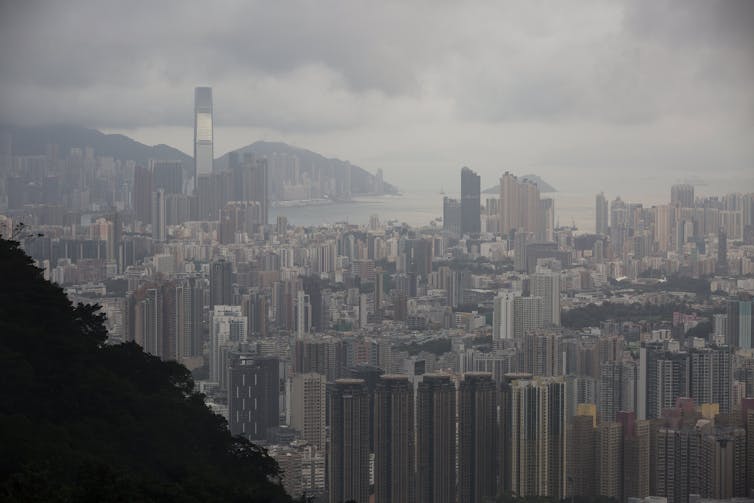
From British To Chinese Colonisation
Lim’s overview of the colonial era shows how British rule fostered the diverse, dynamic and mature society that we see today – but was structured around unforgivable exclusion and marginalisation. The latter, characteristic of the colonial experience, continued for Hong Kong in its process of supposed decolonisation.
Faced with the expiration of the 99-year lease on the New Territories in 1997, Great Britain pursued negotiations with China on the city’s future.
Lim brings us inside these negotiations and their often painful twists and turns, as the fate of millions was determined behind closed doors – with often quite inexplicable conclusions. Foremost among these was the diligent drafting of a supposedly legally binding agreement with China, a state that refuses to be bound by any law.
Tellingly, there was no seat at the negotiating table for a representative from Hong Kong. Lim shows how the concerns of excluded locals turned out to be prophetic.
One local official, excluded from the talks, expressed his worries that Hong Kong would not be genuinely autonomous, but rather controlled by Beijing; that Chinese officials charged with implementing policy would be unable to accept Hong Kong’s culture; and that future Chinese leaders might change their mind about promises made to Hong Kong. Few predictions of Hong Kong’s future could be more accurate.
The result of this deeply flawed process, as we can all see today, is a dynamic society muzzled under the so-called National Security Law. Although marketed as a law, the National Security Law is effectively the end of all law in Hong Kong. It strips away legally protected rights and due process, giving the government free rein to imprison anyone it pleases indefinitely for speech crimes.
The fate of Hong Kong today is a stain on Britain’s legacy and a reminder of the fundamental duplicity of the Chinese Communist Party leadership. Yet most importantly, for the people of Hong Kong, none of whom have remained untouched by this debacle, it is a genuine tragedy: recolonisation masquerading as decolonisation.
‘Guerrilla Street Calligrapher’ The King Of Kowloon
Woven into this rich history is a parallel micro-history of the King of Kowloon: Tsang Tsou-Choi, a trash collector with some fairly obvious mental issues who made a name for himself as a guerrilla street calligrapher. Lim’s narrative of Tsang, his life, and his rise to the status of media icon makes for unforgettable reading.

At some point in his life, Tsang came to the admittedly unlikely but symbolically telling conclusion that his family had once owned the Kowloon Penninsula and that this land had been taken from them illegally. Rather than seeking redress in the courts – long the preferred avenue for settling disputes in the city – Tsang opted to decorate the cityscape with calligraphic declarations of his family’s ownership of the penninsula and his own self-declared royal status.
Tsang’s choice here anticipated a broader shift from working within the system to resolve issues, to seeking new paths outside the system: a driving ethos of the protest movement of 2019. Here again, the streets of Hong Kong were covered in calligraphic declarations of dispossession and defiance, seeking redress (that would never arrive) beyond the stifling confines of the conventional.
Neutrality A ‘Corrupt Compromise’
The third narrative thread in the book is Lim’s own personal experiences, from growing up Eurasian in Hong Kong to observing the defining moments of the 2019 protests.
I particularly appreciated Lim’s frequently witty casual observations and offhand comments, which incorporate a touch of humour into the narrative: much needed, considering the gravity of its subject.

In her reflections on the events of 2019, Lim narrates a number of moments at which she crossed over from an observer of political developments to become a participant. This poses a pressing question for our time: how does one balance the ideal of journalistic or academic neutrality with activist participation?
The answer to this question is, in my reading, extremely clear. As the horrifying nature of Chinese Communist Party rule over its colonies – from Hong Kong to Tibet to Xinjiang – becomes increasingly apparent, the ideal of neutrality becomes a corrupt compromise with the fundamentally unjustifiable.
If academic or journalistic work on China in the age of the National Security Law, concentration camps and genocide is to have any meaning at all beyond its own vapid self-reproduction, it must embrace an activist ethos – of which Indelible City is an outstanding example.
Lim’s book concludes with details of a fascinating exchange with a curator and friend of the King of Kowloon, Joel Chung Yin-chai. Chung has ironically spent years carefully painting over the King’s calligraphy in public spaces, to preserve and protect these works from state-enforced erasure.
The King’s defiance thus lives on under a thin veneer of paint, unnoticed by tens of thousands of passersby every day, awaiting a moment when it can again see the light of day. This image is deeply evocative in the context of Hong Kong today.
Similarly, if we peer beneath the surface of the National Security Law’s unrelenting reign of terror, we can still see a politically engaged and dynamic civil society – as captured so memorably in Lim’s book. Hopefully awaiting the day when the thin, fragile and always fundamentally unsustainable veneer of repression can finally be chipped away, as history shows it always will be.
This will be the day when the people of Hong Kong will finally have a say in determining their own future, once and for all.![]()
Kevin Carrico, Senior Lecturer, Chinese Studies, Monash University
This article is republished from The Conversation under a Creative Commons license. Read the original article.
Running Up That Hill: How Stranger Things and TikTok pushed Kate Bush’s 1985 pop classic back to the top of the charts

Netflix’s nostalgia-laden thriller Stranger Things returned last month and with it came the revival of another classic from the 1980s, Running Up That Hill by Kate Bush. The song plays a prominent part in the narrative connected to one of the show’s leading teen cast members and is featured in a climatic, and visually stunning scene that has been making the rounds on the internet.
In a post shared to her website over the weekend, Kate Bush showered praise on the show and Netflix:
You might’ve heard that the first part of the fantastic, gripping new series of Stranger Things has recently been released on Netflix… It features the song, ‘Running Up That Hill’ which is being given a whole new lease of life by the young fans who love the show – I love it too!
Making A Deal With TikTok
One thing missing from the acknowledgement is mention of another digital platform helping to boost the song’s presence: TikTok. A thirty-second version of the Stranger Things clip has been posted and reposted on TikTok, gaining millions of views in just over a week, and Kate Bush’s song has been used in over 500,000 short videos.
Videos featuring the song depict teens cosplaying as characters, acting out scenes from the shows, and making humorous meme videos (“my friends playing my favourite song trying to save me… my airpods die”).
Others engage less with Stranger Things and more with Kate Bush, in videos depicting connecting with parents over a shared love, recommending more of Bush’s music, and sharing joy that a new generation of audiences might be discovering the influential artist for the first time. The song speaks to misfits and of desperation, themes as relevant to teens in 2022 as they were in 1985.
Running Up That Hill And Going Viral
The runaway resurgence of Bush’s 1985 classic could be a signal to film and TV producers to make clips more “TikTokable”.
Songs with short catchy hooks that are attached to eye-grabbing visual sequences in clips that are sixty, or better yet thirty, seconds maximum are more likely to be picked up on and shared on TikTok.
The chances of going viral can be improved by choosing classic chart-toppers that may find a revival among younger audiences. Naturally when a beloved artist is found by Gen-Z audiences, it leads to gatekeeping by longtime fans as well as counter-gatekeeping by fans who are thrilled to see a younger audience connecting with one of their favourite artists’ music.
Stranger Things is not the first to capitalise on the power of musical nostalgia. The success of films like Guardians of the Galaxy have proven to be powerful tools to give older a reprisal on the radio and popular charts. TikTok challenges and audio memes have helped catapult other classics back into vogue such as Harry Belafonte’s Jump in the Line, The Shangri-Las’s Leader of the Pack remixed into Oh No by Kreepa, and, of course, Fleetwood Mac’s Dreams.
TikTok is a music-centric platform. It takes advantage of musical innovations pioneered on earlier short video platforms, like Flipagram, Dubsmash, and Musical.ly. These platforms allowed users to draw from an internal library of popular songs, creatively add them to video creations, and use features like Duet to place themselves side-by-side their favourite artists.
Unlike streaming services like Apple Music or Spotify, users can take a more active and playful role interacting with music on TikTok.
Radio And The Charts
As with other musical TikTok phenomena, Running Up That Hill might be more than a momentary flash in the pan. In 2020, TikTok claimed over 70 artists who first emerged on the platform had secured record deals an the Billboard charts now frequently feature songs that went viral.
The song has returned to the Top 10 singles charts in the UK and is set to overtake Harry Styles As it Was as the number one single in Australia.
Kate Bush being reserviced to radio, physically or digitally delivering music to radio stations by her label, is a significant development. In the past much money and influence has been involved in getting music onto the radio. For a song that has not received play for decades to spontaneously reappear is a “watershed moment” according to a Warner Music label executive. Despite the growth and dominance of streaming, radio still plays a pivotal role for curation and discover in music markets such as the US, Australia, and around the world.
Radio play brings songs like to those who might not use TikTok or haven’t gotten around to watching the new season of Stranger Things.
While much focus in the music industry has centred on how to make songs go viral on TikTok, labels and artists might want to reconsider the radio as the true measure of success for songs traveling through the pipeline from TV to TikTok to Top 40.![]()
D. Bondy Valdovinos Kaye, Lecturer, Queensland University of Technology
This article is republished from The Conversation under a Creative Commons license. Read the original article.
How the art of Daniel Boyd turns over the apple cart of accepted white Australian history

Daniel Boyd’s solo exhibition Treasure Island, now on at the Art Gallery of New South Wales, is a deeply political and personal interrogation of Australia’s colonial history.
Boyd is a Kudjala, Ghungalu, Wangerriburra, Wakka Wakka, Gubbi Gubbi, Kuku Yalanji, Yuggera and Bundjalung man, with ni-Vanuatu heritage. His work knocks over the apple cart of accepted white Australian history and presents the tumbled mess of bruised fruit.
For many, the true tales of racism, exploitation and violence towards First Nations people in Australia will not be a surprise, but Boyd charges the data with emotion and affect.
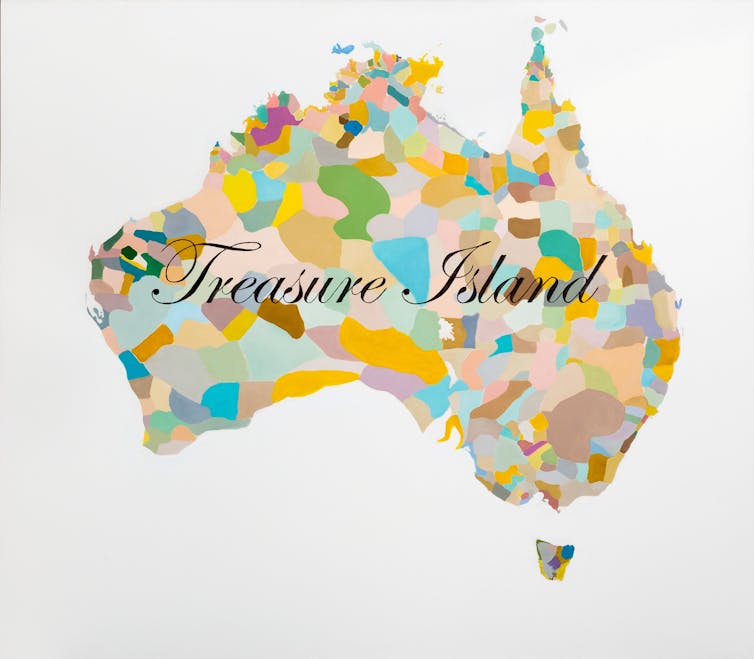
One of the featured artworks presents a large Aboriginal map showing multiple language group areas, and with the words “Treasure Island” across its flank. This refers to the imperial notion of Australia as Terra Nullius, a land of free resources to steal or extract.
Drawing on iconic tales of Robert Louis Stevenson (author of Treasure Island and collector of what Boyd describes as “Pacific fetish objects”) and countless ethnographic images from archives, Boyd creates his disruptions.
The works on display reflect the range of Boyd’s critical inquiry into the cosmos, patterned navigational maps, Plato’s cave allegory and dark matter in space and history.

The Transference Of Knowledge
We Call Them Pirates Out Here (2006) presents the viewer with a familiar image of Cook’s first landing at Kamay (Botony Bay), in 1770. Boyd re-presents Cook as a pirate, unlawfully stealing unceded land.
In Boyd’s hands the scene becomes chaotic rather than messianic. But the stain of power is still there.
The false truth can be disrupted, but the violence has already been done. De-colonialism has not yet been achieved.

I asked Daniel Boyd if non-Indigenous people will ever be able to understand life in the same way that First Nations people do – as multiple and complex, as holistic and connected and as poetic? He replied:
when Indigenous people situate themselves with place, with the sea, the land and the sky, then that knowledge can be transferred.
Boyd’s exhibition is exactly that transference of knowledge to audiences. He presents a middle room of artworks dedicated to the period of “blackbirding” in Australia, where people from South Sea Islands were brought to Queensland as slave labour to work on sugarcane plantations.
Boyd tells me that his own great-great-grandfather Samuel Pentecost was forcibly taken from Malakula Island, Vanuatu, and brought to Queensland to work for no pay.

On The Backs Of Slaves
In Secret Cures of Slaves, historian Londa Schiebinger writes about slaves being tossed into mass graves at the end of cotton or sugarcane rows if they died from exhaustion or malnutrition on site. I’ve read of slaves being only fed bananas or dumb cane which made their tongues swell and stopped verbal backlash.
As Boyd tells me, the Queensland economy was built on the backbone of free labour of First Nations and Pacific Island peoples. Wages were stolen and people were exploited.

Along with domestic servitude, this free labour created capital and profit for generations of white Australians.
Boyd continues these disturbing tales with a painting of an imperial ship, full of produce. The artist tells me that Joseph Banks “discovered” Tahitian breadfruit as a useful species to feed to plantation slaves, so the breadfruit was transported aboard the Bounty ship to Jamaica, another site of plantation slavery.
The brutality continued through Australian history and in Boyd’s own family lineage. Samuel’s son, Boyd’s great-grandfather, was stolen from his parents up in Mossman Gorge and taken to Yarrabah Mission.
Boyd transfers an image of Harry Mossman, photographed by anthropologist Norman Tindale, for this exhibition. This is one of the most unadorned and plain portraits of the exhibition: it has a calm, proud and direct appeal.
Adjusting Our Focus
Boyd’s use of tiny glue dots on the surface of his artworks references traditional painting but also acts as lenses. These adjust our focus and help us see the true stories, painful and sorrowful and shameful as they are.

They are emblematic of the way light (western knowledge) can blind us from what we need to see (Black truth). The mostly white dots are portals to better see the hidden stories.
Boyd’s art dispels white Australian propaganda that erases information about slavery, the stolen generation and the early years of white settlement. He encourages audiences to see the true stories lurking in the shadows.
It’s not easy, but facing the truth is the first step to decolonising our Australian history.
Daniel Boyd Treasure Island is at the Art Gallery of New South Wales until January 2023.![]()
Prudence Gibson, Author and Research Fellow, UNSW Sydney
This article is republished from The Conversation under a Creative Commons license. Read the original article.
Judy Garland at 100: more than just a star, Garland shaped the modern movie musical
There are many angles from which we can celebrate Judy Garland’s 100th birthday on June 10.
We can see her as iconic interpreter of the Great American Songbook, mother of a showbiz dynasty, gay icon, a sad symbol of the excesses of Hollywood control or a classic movie star.
But one of the most interesting things about her is not her place as the star of individual movies, or as a persona, but as a co-creator of a specific style of movie musical.
When looking at Garland’s varied filmography, I am struck by how many “integrated” musicals she starred in. These are movies where the songs contribute to telling the story as opposed to being simply attractive diversions: the songs are integrated into the plot.
Somewhere Over the Rainbow is specific to the plot of The Wizard of Oz (1939). No other character could sing it, and Dorothy could only sing it when she does, early in the film before her journey to Oz.
Similarly, The Boy Next Door in Meet Me In St Louis (1944) only fits where it is in the film: an expression of the wonder of a new crush.
Music For Music’s Sake
The earliest movie musicals of the late 1920s were either adaptations of preexisting stage shows, or backstage dramas about the staging of musicals replete with elaborate production numbers that have nothing to do with the plot.
The most famous among these were from Warner Bros with numbers staged by Busby Berkeley.
As the genre developed in the 1930s, there was usually a mix of plot numbers and pure spectacle, such as in the Fred Astaire/Ginger Rogers musicals made by RKO.
A few of Garland’s musicals fit this style, but most of the best known ones are strikingly void of musical numbers that exist purely for their own sake.
The makers of films like The Wizard of Oz, Meet Me in St Louis and The Pirate (1948) seem to have responded to Garland’s particular acting talents, writing stories and music that suited her storytelling style.
In this, she had an influence on both the form and the content of the film musical genre.
Even in her backstage musicals – where songs usually happen as performance, as opposed to being in musically-enhanced reality mode – Garland’s songs have double meanings as both performances and as character milestones.
The most famous example from Garland’s later career is undoubtedly The Man That Got Away from A Star is Born (1954).
In the film, Garland’s character Esther is rehearsing with her band, but it is clear the character is feeling the specific meaning of the song composed by Harold Arlen and Ira Gershwin for Garland to sing in this film.
A Fully Rounded Character
Take one of Garland’s less familiar films, 1943’s Girl Crazy.
This is not a great film by any means, but it has a stack of classic Gershwin songs and the most interesting plot of Garland’s pre-Meet Me In St Louis films (other than The Wizard of Oz, of course).
Garland plays the postmistress of a small college town somewhere in the American West, to which Mickey Rooney’s character has been banished for having too much non-academic fun at Yale.
Each of Garland’s numbers shows off a different side of her talent while still allowing her to stay entirely in character.
Her comedy duet with Rooney, Could You Use Me?, is a masterclass in under-acting. Even though Rooney is hamming it up at his usual 110%, Garland gives hyperactive Rooney a run for his money by keeping quite still. Focus remains on her even during Rooney’s verses.
In Embraceable You, Garland has fun charming the entire student body of the men’s college where her grandfather is dean. She also shows off her dancing talents in the number.
The melancholic ballad But Not For Me is Garland in her miserable mode, but numbers like this (there is one in almost every Garland musical) never come across as cloying or full of self-pity.
Instead, the subtlety of her portrayal of heartbreak means the audience’s hearts break right along with hers.
Finally, I Got Rhythm shows how powerful she was as an anchor for a huge production number, here a five-minute extravaganza complete with singers, dancers and Tommy Dorsey’s big band, brought to the college to celebrate the fact that it is staying open (and will now be coeducational!).
Unlike many such production numbers, which exist only to show off the performers, this serves as a fitting climax to the film: Garland has found her man, and who indeed could ask for anything more?
That even a relatively minor movie such as Girl Crazy lets Garland play a fully rounded character through her singing demonstrates her influence as a singing actress.
Her considerable talents pushed her collaborators to give her their best work, integrating song and story and pushing the movie musical genre to greater sophistication.
Correction: an earlier version of this story misnamed the lyricist for A Star Is Born. The writer was Ira Gershwin.![]()
Gregory Camp, Senior Lecturer, University of Auckland
This article is republished from The Conversation under a Creative Commons license. Read the original article.
Tribute To Wal Williams OAM
World Elder Abuse Awareness Day 2022
Advancing Equality For Older People
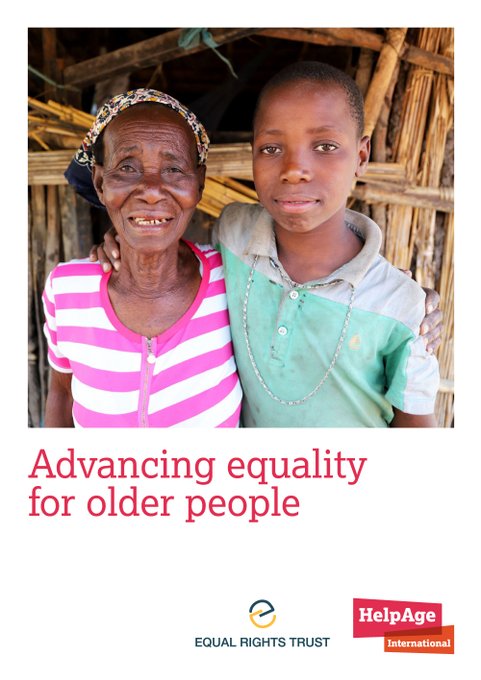
Seniors Rights Service Visiting The Central West
What Older People Think: COTA NSW Report Released
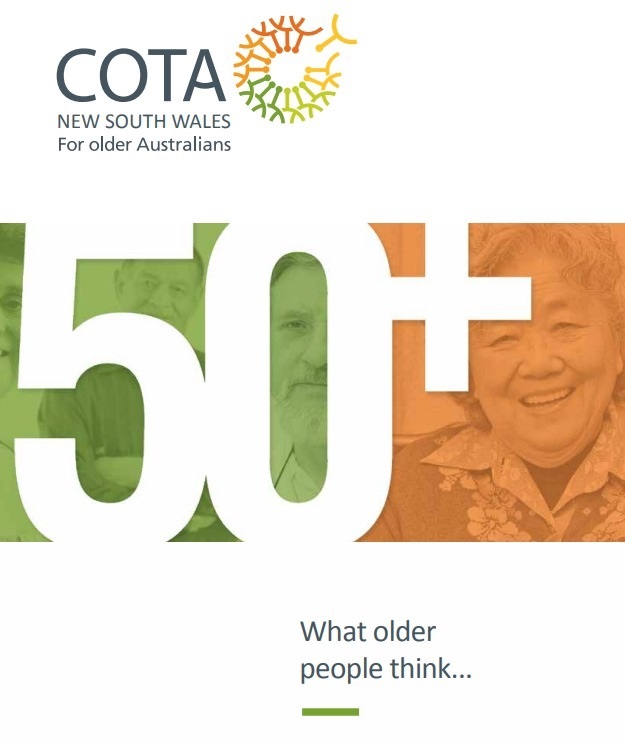
Moving Pictures – Changing How We Look At Dementia
Tax Time Scams And How To Avoid Them


- Contact people you know: Let your friends and family know what's happened.
- Contact your financial institution: If you've provided your bank or credit card details to the scammer, contact your financial institution immediately. They may be able to stop the transaction, perform a 'charge back' to your credit card (reverse the transaction) or close your bank account.
- Recover your stolen identity: If you have had your identity stolen, get in touch with contact IDCARE, a government website that will work with you to plan a response. Visit the IDCARE website or call 1800 595 160. You can also apply for a Commonwealth Victims' Certificate to support your claim that you've been a victim of identity crime and help re-establish credentials.
- Report the scam to authorities: Report scams to the ACCC via the Report a Scam website. Depending on the type of scam, you may also need to report it to the ATO, Centrelink, Medicare, the ACCC, the police, and the Australian Securities and Investments Commission. You should also report the scam to your telecommunications provider, email service, and/or the social media platform (depending how you were first contacted).
- Change your online passwords: If any of your online accounts have been compromised, change your password immediately. Most websites will have instructions for how you can recover a hacked account if you're unable to get into it.
- Set up two-factor authentication for online accounts: Two (or three factor) authentication offers an extra layer of protection. Along with your username and password, most two-factor authentication will set up a second step such as entering a code sent to your phone or email. This makes it harder for hackers to access your account without first gaining access to your phone or email. Most websites will have instructions for how to set this up for your online account.
Hidden costs, manipulation, forced continuity: report reveals how Australian consumers are being duped online

Australian consumers’ choices on websites and apps are being manipulated through online designs taking advantage of their weaknesses. That’s according to research on consumers’ online experiences and the presentation of websites and apps, released today by the Consumer Policy Research Centre (CPRC).
The research gives examples of consumers being manipulated or deceived into unintentionally buying items, paying more, or giving up more personal data than they meant to.
Examples include situations where an online store automatically added items to consumers’ carts, and “Hotel California” techniques which make it easy to subscribe to a service, but much harder to unsubscribe.
According to the CPRC’s findings, 83% of Australians surveyed had experienced one or more negative consequences – including financial harm or feeling manipulated – as a result of these “dark patterns”.
Some misleading designs breach the Australian Consumer Law. However, not all designs that have unfair consequences will necessarily be captured under the law. The latest report adds to existing calls to amend consumer law by introducing a ban on unfair trading practices.
What Are Dark Patterns?
Experts and regulators around the world have highlighted concerning online design techniques in recent years, labelling them “dark patterns” or “deceptive design”.
These designs often take advantage of a consumer’s recognised behavioural biases. For instance, “default bias” is consumers’ bias in favour of leaving default choices in place to avoid making complex decisions. Businesses take advantage of this by pre-ticking boxes in favour of the business’s preferences, despite consumer interests.
The Australian Competition & Consumer Commission has examined dark patterns, defining them as:
The design of user interfaces intended to confuse users, make it difficult for users to express their actual preferences, or manipulate users into taking certain actions.
The CPRC study conducted a randomised sweep of websites and apps to identify deceptive design features.
Hidden Costs: I Bought What?
The CPRC found several examples of online stores automatically adding items to consumers’ shopping carts, such as insurance or service plans.
For example, in one case a consumer buying a washing machine from a major online retailer for A$1,059, may or may not have noticed a single-line item, “3 Year Care Plan For Home - $160”, in the final steps of their purchase.
In other cases, customers were presented with offers of a product care plan at several points in the checkout process. The CPRC says:
this design approach risks implying that […] a product care plan is required when most faults or problems are adequately covered by the consumer guarantees.
For products sold in Australia, consumer guarantees about the quality of products are provided free of charge under the Australian Consumer Law.
“Hotel California” Or Forced Continuity
Another concerningly common pattern is the relative difficulty consumers experience when trying to unsubscribe from a service, compared with how easy it is to sign up. CPRC labels this “Hotel California”, after the famous line in the Eagles’ song: “You can check out any time you like, but you can never leave”.
Examples from the CPRC’s findings included attempting to cancel an Amazon Music Unlimited subscription, which required a consumer to navigate more than five screens. Similarly, cancelling an eBay Plus subscription required four additional steps after selecting “cancel membership”.
The CPRC argues it should be as easy to opt-out of a service as it is to opt-in. While extra steps may not seem disastrous in isolation, they can especially disadvantage those already experiencing vulnerabilities, such as sudden illness, loss of a loved one, or low digital literacy.
This is sometimes combined with another manipulative design technique called “confirmshaming”. With this, consumers are asked to confirm a statement that makes them feel shamed or foolish, such as if they want to “lose their benefits” or if they “refuse to support” a good cause.
Data Grabs, Colours And Countdowns
The CPRC also found the majority of consumers surveyed (89%) had experienced being asked for more personal information than was needed to access the relevant product or service. This was achieved in various ways, including by:
- pre-ticking the option to receive marketing communications
- forcing the consumer to create a profile to browse or purchase a product, and
- treating the mere use of a website as acceptance of data terms or conditions.
Other examples of manipulative design included highlighting the business’s preference in a colour known to entice consumers to agree or act (often green or blue), using a rapid countdown to create a false sense of urgency, and warning that a number of other customers are looking at a product.
Importantly, the research found consumers aged between 18 and 28 were more likely to suffer negative impacts from manipulative design, leading to substantial effects on their financial well-being and privacy. A significant proportion of consumers in this younger age bracket reported they:
- accidentally bought something (12%)
- spent more than they intended (33%)
- disclosed more personal information than they wanted to (27%)
- created an online account when they didn’t want to (37%), and
- accidentally signed up to something (39%).

We Need To Upgrade Business Practices And Consumer Law
For businesses, using dark patterns to boost profit will likely lead to long-term losses in the form of consumer trust and loyalty. Almost one in three people surveyed said they stopped using a website or app (either temporarily or permanently) after experiencing dark patterns.
Misleading designs may also lead to penalties for businesses under the Australian Consumer Law. This happened last year when Google’s privacy settings were found likely to mislead consumers.
However, other designs that have unfair consequences might not fall foul of consumer laws, if they don’t meet certain criteria set out by the law.
The CPRC’s research adds to evidence in support of the Australian Competition & Consumer Commission’s existing recommendation that our consumer law should include an unfair practices prohibition, similar to those in the European Union and the United Kingdom.![]()
Katharine Kemp, Senior Lecturer, Faculty of Law & Justice, UNSW, UNSW Sydney
This article is republished from The Conversation under a Creative Commons license. Read the original article.
NSW Government Responds To Grants Review Recommendations
- Replacing the current Good Practice Guide to Grants with the new Grants Administration Guide (to be issued under a Premier’s Memorandum).
- The establishment of a cross-agency “community of practice” comprising officials with expertise in grants administration, that will be tasked with developing resources to support compliance with the Guide and exploring opportunities for collaboration across government on grants.
Audit Office Of New South Wales: Transport 2021
- future access and licence fees that are subject to re-signed agreements
- an additional $4.1 billion of funding that is outside the forward estimates period
- a significant portion of the fair value of TAHE’s non-financial assets is reflected in the terminal value, which is outside the ten-year contract period to 30 June 2031, and the risk that TAHE will not be able to negotiate contract terms to support current projections.
- absence of conflict of declarations related to land acquisition processes at Transport for NSW
- no evidence of conflict of interest declarations obtained by TAHE from consultants and contractors regarding involvement in other engagements.
- finalise revised commercial agreements to reflect fees detailed in a Heads of Agreement signed on 18 December 2021
- prepare robust projections and business plans to support the required rate of return.
- agencies are aware of contractual obligations
- financial reporting implications are assessed, particularly with respect to leases, revenue and service concession arrangements.
- $128b road and maritime system infrastructure assets as at 30 June 2021
- 100% unqualified audit opinions were issued on agencies 30 June 2021 financial statements
- 26 monetary misstatements were reported in 2020–21
- $24.9b rail systems infrastructure assets as at 30 June 2021
- 6 high risk management letter findings were identified
- 37% of reported issues were repeat issues
Screen Time, Alcohol, And Poor Sleep For Girls: How The Pandemic Has Impacted Teens In Australia
- Compared to pre-pandemic levels, there were increases in the prevalence of excessive recreational screen time (86% to 94%), insufficient fruit intake (20% to 30%), and increased alcohol (2% to 10%) and tobacco use (1% to 4%)*.
- Overall, the prevalence of insufficient sleep decreased over the two-year period (by 26%), regardless of lockdown status.
- Being in lockdown was associated with improvements in sugar sweetened beverage consumption (39% lower than those not in lockdown) and discretionary food intake (27% lower than those not in lockdown).
- For females, there was an increase in the prevalence of insufficient sleep (24% higher than males) and alcohol use* (134% higher than males).
- Although the prevalence of insufficient physical activity and insufficient vegetable intake did not change over time, nor were there differences based on lockdown status, these behaviours remain concerning, with 82% not achieving 60 minutes of moderate-to-vigorous physical activity per day and 84% not eating the recommended five serves of vegetables per day.
Red Pandas Face A Fractured Future
Intersecting Light Beams Key In Transformative 3D Printer Potential

DNA Shed From Colon Cancers Into Bloodstream Successfully Guides Chemotherapy After Surgery
Alignment Of Planets This June
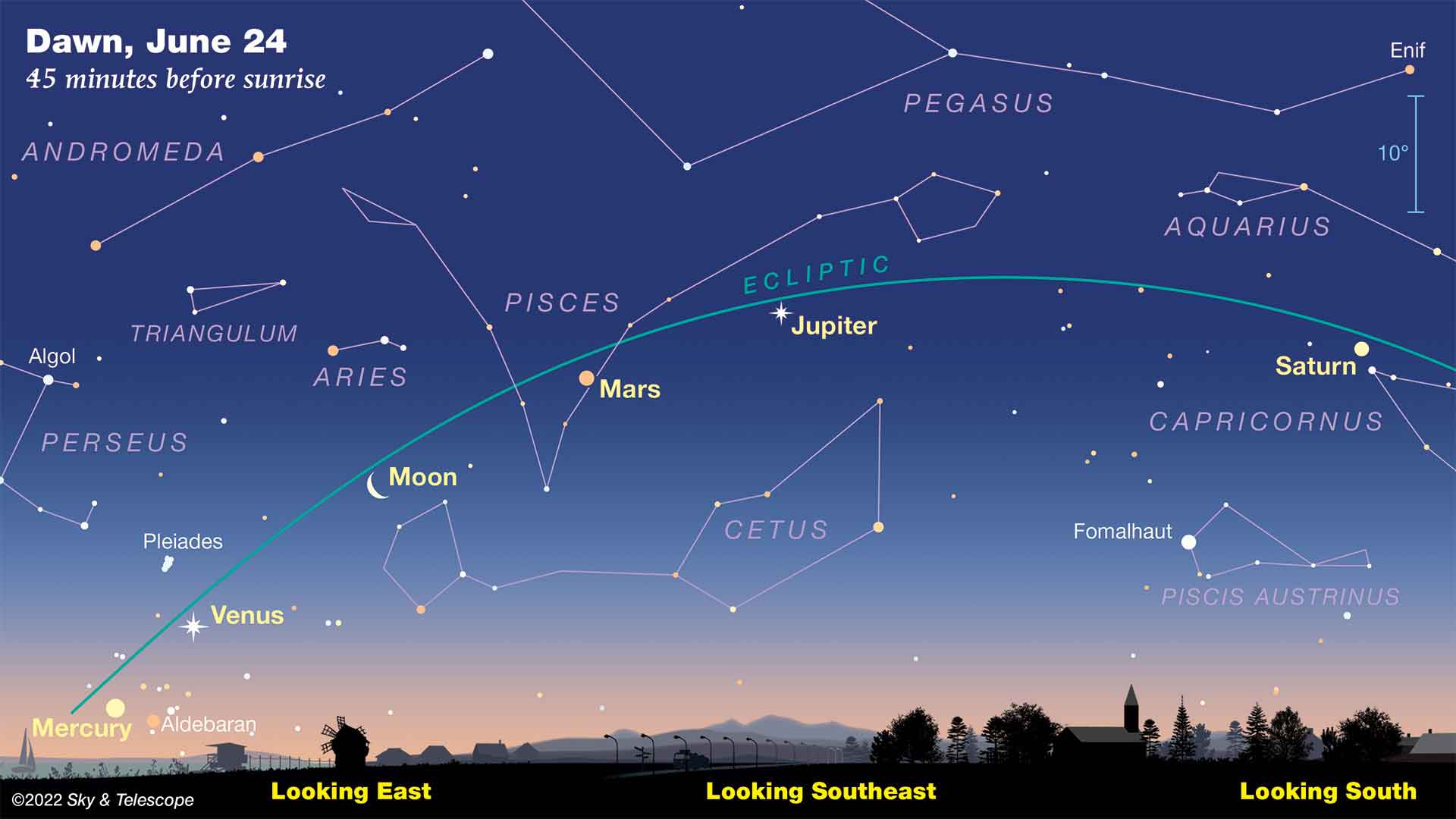
Expect the RBA to go easy on interest rate hikes from now on – we can’t afford rates to climb as steeply as the market expects

By lifting its cash rate by 0.5 points, from 0.35% to 0.85%, the Reserve Bank has added about another $120 per month in payments for a A$500,000 mortgage.
If financial markets are to be believed, by the end of this year it will have added a total of $800 per month – and, by the end of next year, a total approaching $1,000 per month.
Those figures are for variable mortgages, but homeowners on fixed rates won’t escape them long. Those rates are typically fixed for up to three years.
Many of the fixed-rate mortgages were taken out during COVID at annual rates as low as 2%. When those fixed rates end (and many will end in the next year or so) those homeowners will find themselves paying 5% or 6% per year, shelling out as much as $3,000 per month instead of $2,000.
Unless financial markets are wrong. The good news is, I think they are.
The pricing of deals on the futures market factors in an increase in the Reserve Bank’s cash rate from 0.10% to 3.5% by June next year, enough to push up the standard variable mortgage rate from around 2.25% to 5.65%.
We Couldn’t Afford The Rates The Market Expects
One reason for suspecting it won’t happen is that many homeowners simply couldn’t afford the extra $1,000 per month. Most of us don’t have that much cash lying around.
US President Richard Nixon had an economic adviser by the name of Herbert Stein with an uncommonly-developed sense of common sense. In his later years he wrote an advice column for Slate magazine.
To a reader wanting a cure for unrequited love, he wrote that the best solution was “requited love”. To a reader concerned about her inability to make small talk, he wrote that what people want most is a “good listener”.
In economics, Stein is best known for Stein’s Law, which says: “if something cannot go on forever, it will stop”.
Mortgage rates can’t keep climbing to the point where homeowners pay an extra $1,000 per month.
For new homeowners, it’s worse. The typical new mortgage taken out to buy a home in NSW has climbed to $700,000. In Victoria, it has climbed to $585,000. These people will be paying a good deal more than an extra $1,000 per month if the bets on repeated rate hikes made on the futures market come to pass.
The Reserve Bank says it lifted its cash rate from 0.35% to 0.85% today to withdraw the “extraordinary monetary support” put in place during the pandemic.
But the bank says from here on it will be guided by data, and, in a nod to homeowners concerned about continual rate hikes, said it expected inflation to climb just a bit more before declining back towards its target next year.
The Bank Will Be Guided By Data
Financial markets don’t see it that way. They have priced in (in other words, bet money on) rate hikes in July, August, September, October, November, December, February, March, April and May.
But there are reasons to believe the bank is right about inflation.
It doesn’t seem that way with electricity prices set to climb 8-18% in NSW, 11% in Queensland, 5% in Victoria, and as much as 20% in South Australia. (The only jurisdiction without an increase in prospect is the Australian Capital Territory, which has 100% renewables and fixed long-term contracts.)
Fortunately for overall inflation, electricity accounts for less than 3% of the typical household budget. Gas accounts for less than 1%. Even low earners spend little more than 4% of their income on electricity.
While the price of vegetables is soaring (heads of lettuce are selling for $10), we spend less than 1.5% of our income on vegetables.
The best measure of overall price increases remains the official one of 5.1% for the year to March, calculated by the Bureau of Statistics.
It is a more alarming increase in inflation than Australians are used to. But what matters for the Reserve Bank is whether the 5.1% is set to turn down and head back towards the target of 2-3%, or climb further away from it.
Australia is almost uniquely disadvantaged among developed nations in getting a handle on what’s happening to inflation, being one of only two OECD members (the other is New Zealand) to compile its consumer price index quarterly, instead of monthly.
By the time Australia’s index is published, several of the measures in it are months old, and they don’t get updated for another three months.
It has been said to make the bank’s job like driving a car looking through the rear-view mirror.
Using Our Rear-View Mirror, With Caution
Fortunately the Bureau of Statistics is gearing up to produce a monthly index. Meanwhile, in the United States – which is subject to the same international price pressures as Australia – most measures of inflation eased in April.
Wages growth, which the Reserve Bank said last month seemed to be “picking up”, remained dismal in the figures released a few weeks later – at just 2.4% in the year to March. That was well short of the 2.7% forecast in the budget for the year to June, and not enough to do anything to further fuel inflation.
Australia has a history of aggressive interest rate hikes to tame inflation.
In 1994, Reserve Bank Governor Bernie Fraser rammed up the cash rate from 4.75% to 7.5% in a matter of months. But that was when wage growth was well above inflation and the bank was trying to dampen “demands for wage increases” to prevent a wage-price spiral.
We don’t even have the beginnings of that yet. Unless the bank wants to needlessly impoverish Australians, and keep going until it pushes them out of work, it will increase rates cautiously from here on.![]()
Peter Martin, Visiting Fellow, Crawford School of Public Policy, Australian National University
This article is republished from The Conversation under a Creative Commons license. Read the original article.
Yes, women might ‘feel the cold’ more than men. Here’s why

We all have different preferences for when it’s the right time to bring out the winter blankets. And the thermostat’s setting often forms the basis of office arguments between women and men regarding the “correct” temperature for it to be set.
Between the sexes, there are always more similarities than differences. But research does consistently show women prefer a higher indoor temperature to men.
But is there any science backing up the widespread belief women “feel the cold” more than men?
Biological Differences Between Men And Women
At around the same body weight, women tend to have less muscle to generate heat. Women also have more fat between the skin and the muscles, so the skin feels colder, as it’s slightly further away from blood vessels.
Women also tend to have a lower metabolic rate than men, which reduces heat production capacity during cold exposure, making women more prone to feeling cold as the temperature drops.
Hormonal Differences
The hormones oestrogen and progesterone, found in large quantities in women, contribute to the core body and skin temperatures.
Oestrogen dilates blood vessels at the extremities. This means more heat can be lost to the surrounding air. And progesterone can cause the vessels in the skin to constrict, meaning less blood will flow to some areas to keep the internal organs warmer, leaving women feeling cooler. This hormone balance changes throughout the month alongside the menstrual cycle.
The hormones also make women’s hands, feet and ears stay around three degrees Celsius cooler than men’s.
The core body temperature is highest in the week after ovulation, as progesterone levels increase. This means that around this time, women may be particularly sensitive to cooler outside temperatures.
Although the hands and feet are cooler, women do have warmer average core temperatures than men. This is likely the source of the saying “cold hands, warm heart”.

Is It Just Humans?
The phenomenon that some of us prefer warmer temperatures to others isn’t unique to humans. Studies on many species of birds and mammals report that males commonly congregate in cooler areas where there is shade, while females and offspring stay in warmer environments where there is sunlight.
Male bats prefer to rest at the cool, high peaks of mountains, whereas females remain in the warmer valleys.
Female mammals may have developed a preference for warmer climates to encourage them to rest with offspring during stages when the young are unable to regulate their own body temperature.
So the difference between heat-sensing mechanisms may provide an evolutionary advantage.
So How Do We Agree On The Ideal Temperature?
The “Scandinavian sleep method”, where couples sleep with separate blankets, is one way to overcome the differences in temperature preferences.
In the workplace, personal comfort systems are thermal systems that heat or cool and can be locally positioned in individual work stations such as desktops, chairs, or near the feet and legs. Examples include small desk fans, heated chairs and blankets, or footwarmers.
These systems provide individualised thermal comfort to meet personal needs without affecting others in the same space, and have been found to produce higher comfort satisfaction in the workplace.
They may also be an energy-efficient method to balance thermal comfort and health in office environments.![]()
Charlotte Phelps, PhD Student, Bond University and Christian Moro, Associate Professor of Science & Medicine, Bond University
This article is republished from The Conversation under a Creative Commons license. Read the original article.
Disclaimer: These articles are not intended to provide medical advice, diagnosis or treatment. Views expressed here do not necessarily reflect those of Pittwater Online News or its staff.